

The Saint University Publishes
‘Legacies of Empire’ Report

SAFIRA SCHIOWITZ News Writer
After four years in the making, a report revealing the University’s colonialist and imperialist ties was published on 13 March and is available to read online.
The report entitled ‘The University of St Andrews and the Legacies of Empire, 1700-1900,’ was commissioned in 2021 following growing calls for British institutions to be transparent about their role in the Atlantic slave trade, as explained in Principal Sally Mapstone’s email announcing its publication and summarising its key points. Professor Aileen Fyfe led the project, working closely with Professor Lorna Milne, as well as Dr Isabel Robinson in the report’s early stages.
The report’s findings mainly examine
financial benefits the University received from colonial sources, including from enslavement, within the specified time period.
It names several donors to the University such as James Brydges, Duke of Chandos, who was a director of the slave-trading Royal African Company in the early 1720s. Alexander and David Berry’s £100,000 donation to the University in the 1880s derived from exploiting Indigenous land in Australia and displacing its original and rightful occupants. At least two eighteenth-century Principals of the University had family ties to enslavers, and several alumni in the two-hundred year period were found to have worked for the East India Company or participated in other colonialist undertakings. The University also contributed to studies falling into the category of what is commonly termed ‘sci-
entific racism’, possessing stolen ancestral remains of Indigenous people from across the globe throughout the twentieth century. The University has taken steps to address its colonialist history in recent years, with more plans underway. However, some members of the University community, including members of the BAME Students’ Network, would like to see a bolder commitment to reparations. BAME Students’ Network Vice President Isaac Pickrum was asked to review a draft of the report before publication and shared his thoughts with The Saint. Pickrum’s primary concern was about the report’s language, which he felt skirted around the racist reality it was meant to describe. For example, the report refers to University groups and professors studying “racial anthropology” in the
Continues on Page 4.
Who Killed The Witch Lake Eight?
by Celia Irving
In 1987, workmen Thomas Campbell and Ernie Price were digging a garden when their shovels struck something more sinister than soil: human skeletons. Edwina Proudfoot — a local archaeologist and now former director of St Andrews Heritage Services — was called in to investigate, uncovering eight intact skeletons. Read on Page 10.
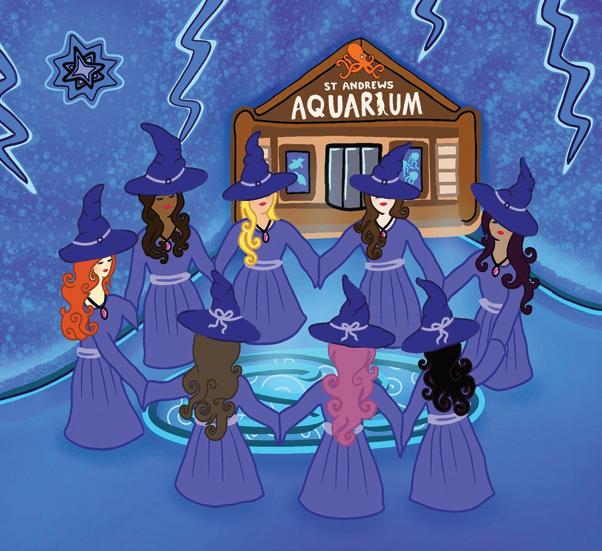
I Want To Be A Mum With Dad Lore
by Mistral Zerbi
Ever think back to your dad’s dinner-table stories and realise ‘dad lore’ is mostly insanely dangerous shenanigans he rebranded as character building? As a girl, I heard those stories like fiction — but I bet most boys saw them as a blueprint. Read on Page 13.
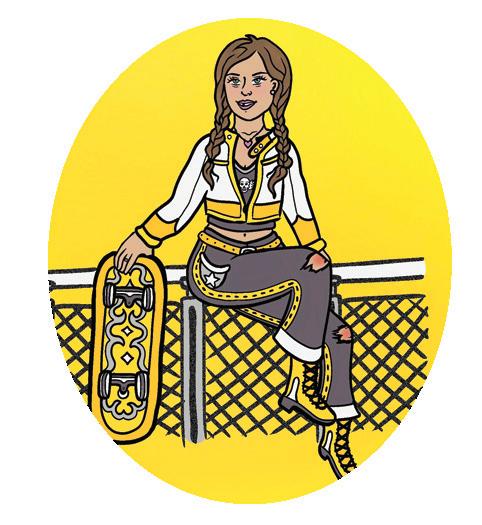
What’s Inside?
EDITORIAL
In this issue, Parie Desai reports on the North East Planning Committee’s decision to make the pavement expansion along South Street permanent. This decision means that the outdoor seating areas, originally implemented for Covid-19, are here to stay. For a town in Scotland, prioritising outdoor spaces may seem confusing to an outsider. Known for its rainy weather and cold winds, why would we take away practical parking spaces for something we can only enjoy for short blips of the year?
Anyone who wonders this can find the answer in the sunshine. When light illuminates all the shadows and crevices and gardens there is a collective exhalation. St Andrews has a uniquely impressive dedication to being optimistic about sunshine — all it takes is a few rays for The Central’s or The Dunny’s outdoor seating to be popularised with Peroni and Aperol Spritz, fur coats, and sunglasses. St Andrews, despite our deadlines and essays, is spreading its wings in the warmth. This optimism has been made clear in the last few weeks, with the enjoyment of grassy quads, beach swims, and open windows. This valent optimism speaks to what defines St Andrews. Here in my last solo editorial, I wish to share my thoughts on it with you.

As St Andreans, we have proven to make the best of any situation. These streets are full of the type of people that will use temporary disappointments to push themselves further, to reorient their approach to a situation, or to let something go to make room for something new. Whether it is a bad grade, a heartbreak, or a rejection from a desperately wanted flat, we know disappointment and frustration. We know what it is to be caught in the worst rain of your life, for the wind to bite at your fingers and ears, for darkness to meet you when you leave your 3pm tutorial. How much more sensitive does this make us to sweetness?
Excuse my sentimentality, but our collective appreciation of the sun makes me see the sharedness of our experiences in this space, in this sun. It makes me smile that this joy has been recognised as officially important and deserving of taking up physical dedicated space. Let this kind of sunny joy take up your life in what is left of the semester. Deadlines and weather permitting, photosynthesize with the rest of the population and read this week’s issue outside. I hope you enjoy. Riley.
“Quote of the Issue: “If people did not love each other, I really do not see what use there would be in having any springtime.”
- from Les Misérables by Victor Hugo
The Editorial Board
David Buchan Editor-in-Chief
Riley Raab Editor-in-Chief
Pietro Barbini Business Manager
Mary Henderson News Editor
Georges Toulouse Viewpoint Editor
Simon Ezra-Jackson Features Editor
Alex Le Sage Puzzles Editor
Alden Arnold Photography Editor
Arnaz Mallick Arts & Culture Editor
Ilaria Freccia Deputy Editor-in-Chief
Hannah Shiblaq Deputy Editor-in-Chief
Olga Alonso Blanco Events Editor
Ana-Lucia Chalmers Science & Technology Editor
Mahaley Wise Sport Editor
Isabelle Holloway Head of Illustration
Armaan Madanmohan Senior Copy Editor
Natalie Olofsson Podcast Editor
Maria Ebrahim Head of Web & Social Media

EDITOR: MARY HENDERSON
Foreign Affairs Society Welcome Diplomats to the Ambassador’s Ball
SOFIA PANEK News Writer
On 14 March, the School of International Relations’ annual Ambassador’s Ball, hosted by Foreign Affairs Society, welcomed two guests of honour to St Andrews: His Excellency Dr Ferenc Kumin, Ambassador of Hungary to the United Kingdom, and Mr Stéphane Pailler, Consul General of France in Edinburgh and Glasgow. Inviting esteemed diplomatic officials to attend the Ambassador’s Ball is a new initiative started by Foreign Affairs Society this year. Ball Vice-Convener Joshua Inglesfield, who served as the Chief-Coordinator of the diplomats’ visit, explained that the initiative was intended to “add a level of diplomatic angle” to the popular International Relations gala. “It’s about the celebration of the highest levels of diplomacy and the highest levels of academia. We’re bringing together the highest rank in the diplomatic world with one of the highest ranked universities in the UK, and indeed the world,” he stated. Inglesfield envisioned that the high table at the Ball, including the guests of honour as well as the School of IR President Cole Schubert, Foreign Affairs Society President Charlie Ball, and Ambassador’s
Ball Convener Michael Blinski, would create an opportunity to “integrate the worlds of diplomacy and academia.”
When contacting the special guests’ respective embassies, Foreign Affairs Society emphasised the evening’s capacity to serve as an educational opportunity for students aspiring to become future diplomats. The Society also explained that students could greatly benefit in their understanding of current affairs by learning from the insights of the highly accomplished diplomatic guests. Foreign Affairs Society was keen to host Dr Kumin due to his extensive experience in academia, which the Society believed would allow him to convey both academic perspectives and practical insights when discussing foreign policy with students. Dr Kumin holds a PhD in Political Science and Government, and developed a strong background in academia as a lecturer at several Hungarian universities. Alexander Peris, the Foreign Affairs Society Guest Speaker Coordinator, stated an expectation that Dr Kumin would “be able to really help students understand Hungary’s foreign policy at every level.”
Prior to attending the ‘Agents and Alibis’ themed ball at Hotel du Vin, which featured a black-tie dinner complete with live jazz music and an afterparty, Dr Kumin delivered an educational lecture to students on the
topic of Hungarian foreign policy. Foreign Affairs Society organised the speaking event to magnify the academic aspect of the evening, intending to create a unique opportunity for students to engage with pressing current issues in international affairs from an insider’s perspective. Dr Kumin told The Saint that he was ambitious to provide deeper insights from his experience in diplomacy, “to go a little bit beyond the headlines […]to provide a window on the things that I’m working on.”
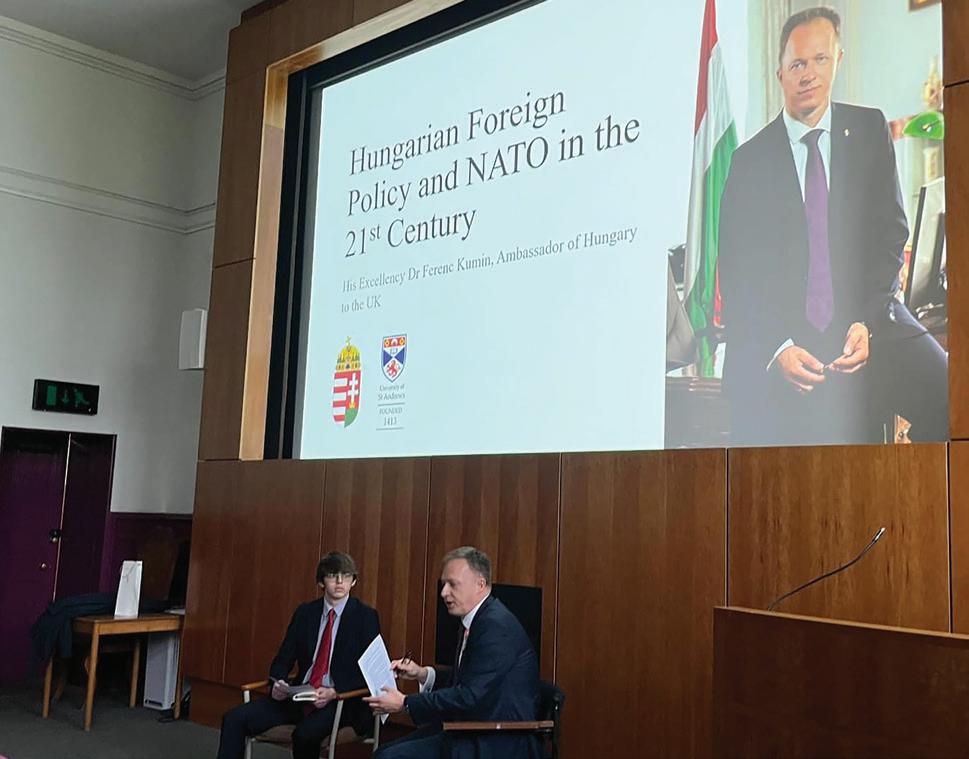
Foreign Affairs Society was inspired to invite the French Consul-General due to the upcoming 730th anniversary of the Auld Alliance, a historical Scottish-French alliance that established strong diplomatic relations between Scotland and France. During the dinner segment of the Ball, Mr Pailler acknowledged the significance of the agreement, and concluded his remarks by offering a toast to the alliance.
The diplomats indicated that being invited to a university ball was an unconventional experience. Dr Kumin told The Saint: “I’d never been invited to a ball
that is organised entirely by students. It’s a special feature of this University, and it’s a lot of fun and a new experience.” Reflecting on the evening, Mr Pailler stated: “I had a lot of discussion with the people at my table and I was very impressed by the level of wisdom in the questions regarding diplomacy.” Mr Pailler expressed that he was highly pleased both the event and his overall visit to the University, and Dr Kumin concurred that “[St Andrews] is exceptional, it’s just incredible.”
Image by Joshua Inglesfield
National Focus Stories from Scotland
EVA LEWIS News Writer
Tributes Paid to Local Search and Rescue Hero
Mass commemoration from around the country has been paid to the RAF Mountain Search and Rescue veteran David ‘Heavy’ Whalley, who has died aged 72. During his career, he helped save hundreds of lives, responding to over 1,000 mountain incidents. Whalley was famously the senior team leader of rescue efforts that followed the Lockerbie
“A friend to so many in the mountain rescue community and beyond.”
disaster, which saw Pan Am Flight 103 crash on 21 December, 1988, killing 259 passengers and crew members, as well as eleven residents living in the Scottish town. After the disaster, Whalley helped establish support structures for first responders and rescuers who suffered from PTSD and other trauma related disorders as a result of their work.
Tributes have poured in, including from Scottish Mountain Rescue, who described Whalley as a “leader, a mentor, and a friend to so many in the mountain rescue community and beyond.”
Investigation into the University of Dundee’s finances announced
An independent investigation concerning the financial crisis at the University of Dundee is now underway, commissioned by the Scottish Funding Council (SFC). Earlier this month, the University announced a £35 million deficit and the consequent need to cut 632 jobs. The SFC has approved a £22 million support package for the University.
The probe, headed by former Principal of Glasgow Caledonian University, Professor Pamela Gillies, will analyse management and governance, information flows, and cultural issues as potential factors for the “deterioration” of the University’s finances, and consider why this went undetected by University leadership. The University has stated that it is “committed to engaging fully” with the investigation and acting on its findings.
Police Scotland Announce Funding Crisis
Police Scotland have announced that a lack of investment has caused large areas of the country to have very little police presence, regions described as “policing deserts”, and has since led to the closing of police stations and a reactive service.
The chair of the Scottish Police Federation (SPF) spoke at the Federation’s annual conference, stating that falling officer numbers have left parts of the country “with an almost invisible policing presence”, largely due to
a “chronic underinvestment in policing”. He told the conference, which was attended by Justice Secretary Angela Constance, that “SNP ministers must accept that policing our communities cannot simply be reliant on the goodwill of officers. They should show some common sense by finally providing Police Scotland with the funding they need to keep communities safe.”
“A lack of investment has [...] led to the closing of police stations and a reactive service.”
Continued from page 1
nineteenth century through the “acquisition and display of human remains,” some of which likely came from “the disturbance and desecration of burial sites.”
“The term they’re looking for is phrenology and scientific racism,” Pickrum said. “If you want to come to terms with these histories, you need to be honest about what happened here. They were collecting skulls from Africa and elsewhere to scientifically argue about the intelligence of different human races,” he continued.
He made suggestions to make the wording of the report more direct in a threepage commentary to Fyfe and Milne, but these suggestions were not taken. “They essentially changed nothing,” he said, and expressed frustration about this considering he was specifically called upon to take time to read and review the report.
Professor Fyfe told The Saint that she and the other writers made intentional decisions about this language. “It has been a genuine challenge to write a report that (in contrast to other university reports of this type) ranges from the horrors of racialised chattel slavery in the Atlantic world, to the ruthless search for profits by the East India Company, to the violence done to Indigenous peoples and their lands in Australia.”
“These are all consequences of British colonialism and imperialism, but they
are also all very different from each other. Words that might be appropriate in one context may not be in another,” Fyfe said. She believed the choices to use certain phrases would be more “historically precise while also covering a wide range of different cultural and geographical contexts.”
Pickrum asserted that foregoing the use of phrases like ‘scientific racism’ or ‘phrenology’ in favour of ‘racial anthropology’ is not historically accurate, as ‘scientific racism’ is more established jargon. When he raised this point, he recounted that Fyfe and Milne said they wanted to prioritise using “largely neutral tones.”
For Pickrum, it is important to consider that historical writing can never truly be neutral. “The way you choose to describe things affects their veracity, their truth historically. Like when you say you acquired things through ‘unequal trade,’ which is theft, you can just say theft, and by not saying theft, you’ve reduced the truth of what happened.”
Fyfe explained the reasoning behind these choices stems from uncertainty about the history: “In the case of collections items in particular, all too often, we do not know for certain what the conditions were under which an item was acquired. We may guess at ‘theft’, but we rarely know for sure. And there are various other ways in which the power imbalance between Europeans and
Indigenous peoples could have played out.”
Fyfe continued: “Personally, I think that ‘theft’ is too simple to cover the range of possible ways that natural historical specimens, cultural heritage items, and even human remains, could have been acquired. I hope that by explicitly mentioning ‘violence’, the ‘desecration of burial sites’ and the possibility of trade, we will encourage readers to reflect on those complexities.”
Pickrum hopes that, in future projects, there will be more consideration of the people impacted by colonialism, not only an examination of the perpetrators. “I think the next steps for [the BAME Students’ Network] is to really try and get people in the BAME community involved in reading this material, seeing how it connects to them,” he said.
Dr Akira O’Connor, Chair of the Race Equality Charter (REC), reviewed a draft of the report and shared a similar hope after reading the published version. While he praised the extensive investigation into past University leadership’s imperialist connections, he said: “A key issue in any work like this is how it acknowledges and represents the people affected by colonialism and empire.”
This in mind, O’Connor expressed that “it is an important document to look at alongside accounts that focus on the voices of those who encountered and were directly impacted by those St Andrews
staff and alumni considered in the report.”
Part of the five-year REC Action Plan is to “foster dialogue and build an open culture of conversation around these issues.” Now that
“Words that might be appropriate in one context may not be in another.”
it is published, O’Connor said that the REC team will develop “a specific action that will facilitate engagement with and conversations about the Legacies of Empire Report.”
The publication of the report marks a significant step in the University’s acknowledgment of its colonial past, though questions remain regarding the language and framing of the issues it addresses. As the University moves forward, it will be crucial for ongoing dialogues to centre on the voices and experiences of those most affected by colonialism and its legacies.
Photo by University of St Andrews
Plans for Solar Panels on Younger Hall
ROWAN HOOVER News Writer
A controversial plan to install 27 solar panels on the roof of the historic Younger Hall in St Andrews has been approved by Fife Council’s North East Fife Planning Committee. The decision, as part of the University of St Andrews’ broader decarbonisation strategy, has sparked debate over the balance between sustainability and the preservation of heritage sites.
Younger Hall, a B-listed, 100-yearold art deco building located on North Street, is a key cultural and academic venue, hosting concerts and University graduation ceremonies, and a prominent building for any student in town. The solar panels, set to be installed on the east-facing roof, will cover approximately 104 square metres, the majority of the 185-squaremetre roof space. Despite its approval, the project has faced opposition from the St Andrews Community Council, which

raised concerns about its visual impact on the surrounding conservation area.
The St Andrews Community Council argued that the installation of three rows of black photovoltaic panels would detract from the character of the historic building and the broader conservation area. While the panels will introduce a stark contrast to the existing red clay pantile roof, planning officials reassured committee members that they would be largely invisible from street level, with the only vantage point being the top of St Rule’s Tower, located 300 metres away. Planning officer Benet Davis, who assessed the proposal, noted that Fife Council supports renewable energy projects provided they do not significantly harm historic or architectural fabric. He stated that while the installation will alter the building’s appearance, the impact is limited and, crucially, reversible. A condition attached to the approval requires the University to restore the roof to its original state once the solar panels reach the end of their lifespan.
Despite objections, the committee unanimously approved the installation. St Andrews Liberal Democrat Councillor Jane Ann Liston defended the project, arguing that sustainability should take precedence over aesthetic concerns. She also criticised
the presence of the nearby Gannochy House, a 1960s-built student accommodation block, stating: “Gannochy House is much more of a blight on the landscape and detracting from the Younger Hall than solar panels would be.” She further suggested that the Community Council may have misjudged the situation, given the ongoing climate crisis. “To have objected, considering the climate emergency, to fitting photovoltaic tiles to the top of the Younger Hall, I think they may have made a mistake there,” she remarked.
The installation of solar panels on Younger Hall is part of a broader initiative by the University of St Andrews to reduce its carbon footprint and transition to renewable energy. The University has cited increasing energy demands as a primary reason for expanding solar power across its estate. While the planning application was assessed under local and national sustainability policies, concerns remain among some community members about the potential precedent this decision sets for other historic buildings in St Andrews. However, with Fife Council’s approval now secured, the University can move forward with the project, marking another step in its commitment to renewable energy.
Photo by University of St Andrews
University Withholds Name of Donor Mentioned In Stella Maris Report
SIMON EZRA-JACKSON & EDITH OBORNE Features Editor & News Writer
Despite two Freedom of Information requests from the British Society for Middle Eastern Studies (BRISMES), the University of St Andrews continues to withhold the name of the “prospective funder” mentioned in the independent investigation into Rector Stella Maris. The independent investigation was publicly released in July 2024, in response to Stella Maris’ October 2023 University-wide email which condemned Hamas war crimes and described Israel’s actions in Gaza as “genocidal”.
Maris voiced her concerns to The Saint, “It’s concerning to see that the report references external influence in relation to a process involving an elected student representative. The Rector is chosen by students and is accountable to them, not to individuals or entities outside the University. It’s important that student representatives are able to carry out their roles independently and without undue interference. The mention of other considerations in the report raises concerning questions about the impartiality of the process.”
An open letter issued in August 2024 by St Andrews societies including Amnesty International, the Muslim Student’s Association, Middle East and North Africa Society, BAME Students Network and the Socialist Worker Student Society said, “the risk of a specific, unnamed donor withdrawing funding as a result of Stella’s statement was a key motivating factor for the University’s investigation and decision […] it is unacceptable for important institutions to be degraded and diminished by the demands of external voices.”
“It’s important that student representatives are able to carry out their roles independently.”
The investigation, conducted by Lady Morag Ross KC, mentions a donor when describing the “factual background” of the period between 21 November to 15 December, 2023. It states: “The Principal [Sally Mapstone] had to consider potential financial consequences. She explained to me that a major project plan had been put in
serious jeopardy because the prospective funder, [REDACTED], had been very concerned about information relating to the University and the Statement made by Ms Maris. The Court already has information about that issue. The Principal, in particular, but also others, had to work very hard to repair damage done and to rebuild that important relationship. I understand that the anticipated funding was secured.”
After the release of the investigation, BRISMES, the largest national academic association in Europe focused on the study of the Middle East and North Africa, filed two Freedom of Information requests for the University to reveal the identity of the prospective funder and “the nature and value of the ‘anticipated funding’.” They were twice denied this information.
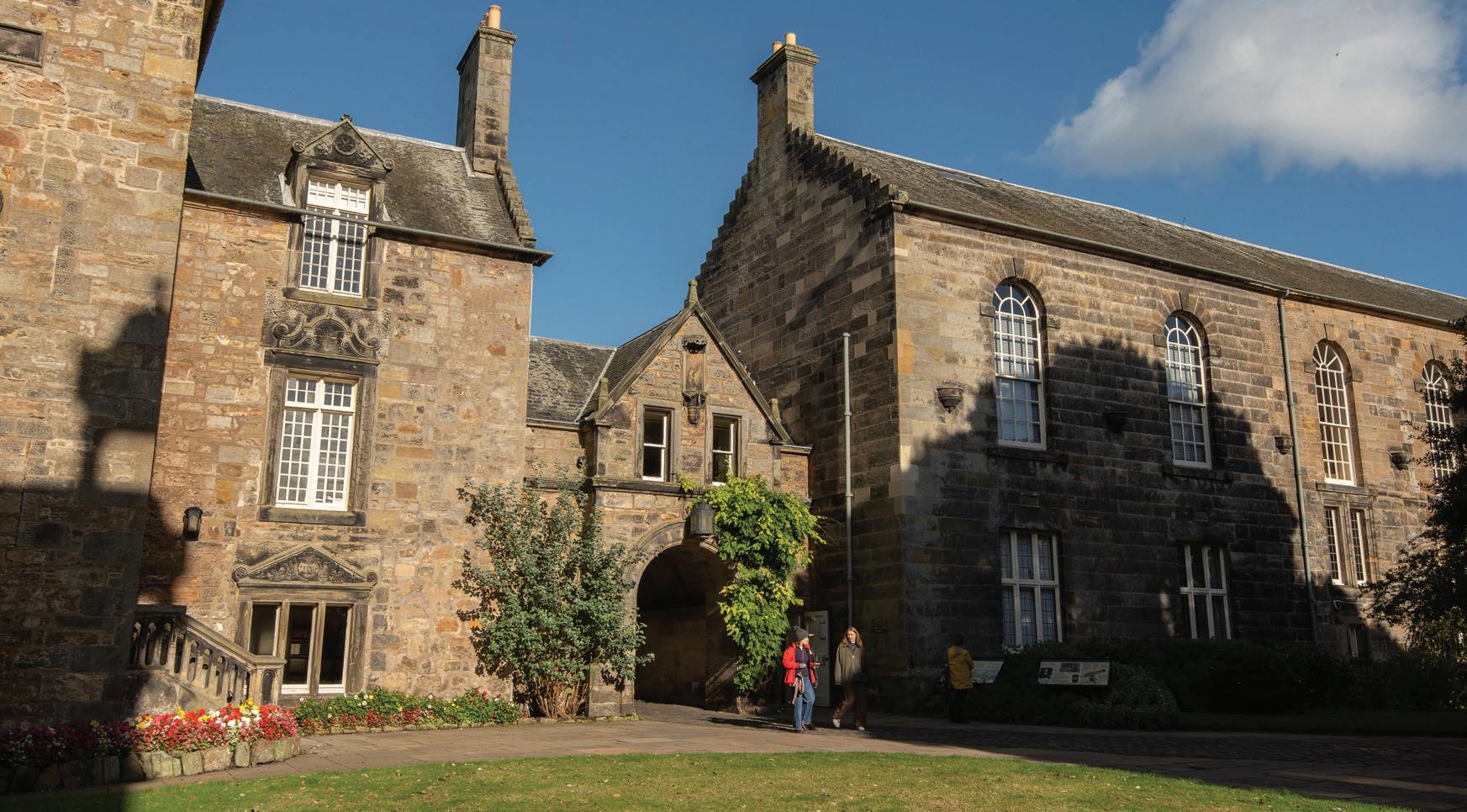
Rector Maris’s freedom of expression.”
“The identity of the requestor is irrelevant to the collective decision reached by Court.”
The University responded: “The identity of the requestor is irrelevant to the collective decision reached by Court to commission an independent investigation. [...] There was disclosure of the relevant facts to Court, and the public. Disclosure would be contrary to the public interest [...] Disclosure would be to the detriment of both parties and as such likely to give rise to a successful action by the witness and the funder (who is entitled to bring concerns to the University without their identity being made a matter of public record, as are others who contacted the University).”
The University added they have “robust controls in place to secure and accept funding [...] The relevant point [brought up by Ross’ report] was that funding was placed at risk and that had to be managed.”
BRISMES raised the “possibility” that the University “prioritised its financial interests and the views of a potential funder over its obligations to protect and defend
In their response to BRISMES’ FOI request on 5 February, the University mentioned that, in the 15 December, 2023 meeting to decide whether to investigate Stella Maris, Principal Mapstone “appraised Court of the external consequences that had arisen.” The University stated, however, that there was “no scope for the funder to have any influence” over Maris’ dismissal, pointing out that the donation had been made prior to the Court’s decision to launch the investigation.
Dr Lewis Turner, BRISMES Co-Vice President and Chair of its Committee on Academic Freedom, told The Saint, “The fact that the donation was made before the investigation was launched does not dispel our concerns [...] First, the University has disclosed that the Principal had to work ‘very hard’ to satisfy the donor, and we know from subsequent FOI disclosures that the Principal was subsequently involved in briefing the University Court on this issue at the meeting where the investigation was launched.”
“Donor relationships are not oneoff events; they are ongoing,” Dr Turner continued. “This is why it is important to know the identity of the funder, particularly if it is a large or prominent funding body which might try to exercise influence over St. Andrews. There is precedent for this: in the United States, pressure from longterm donors has had a major influence over the way universities handled student encampments. We would be very concerned to see a similar pattern emerge in the UK.”
The University stated that “evidence given in confidence to an investigation is inherently sensitive; release could be damaging to witnesses and/or the conduct of future investigations,” and continued to deny revealing the identity of the donor.
In response, Dr Turner said it was
“striking that the rest of the unredacted report does reveal information which seems sensitive [...] it is not clear why the identity of the donor would be more sensitive than this. For example, the report discloses comments of witnesses about incidents of antisemitism (2.5), about their feelings of lack of safety, distress and anger (2.562.58), and about conduct at a protest which took place on campus (2.49-2.50).”
Dr Turner repeated BRISMES’ desire to find out the identity of the donor: “The University should be willing to disclose relevant written communications and briefings to allow the public to scrutinise the decisions. We know these documents exist but the University is currently refusing to disclose them.”
In a statement, a University spokesperson said:
“No donor has influence on university governance, and it is mischievous and disingenuous to suggest otherwise.
The University has clear regulations governing the receipt of donations.”
“The Rector was found by an independent investigation carried out by a leading KC, to have breached her important and legal responsibilities as a member of the University Court and a charity trustee. The Rector repeatedly refused to accept the findings of that report, or to comply with the steps Court asked her to take as a consequence.”
“For those reasons alone, Court had no option but to discharge Ms Maris from her role as President of Court and as a trustee of the charity. Ms Maris remains the Rector of the University, and we continue to provide her with support to undertake that role for the remainder of her term of office.”
Photo by University of St
Andrews
Diplomats and Tech Experts Gather for St Andrews Summit
ZAINAB HAJI News Writer
Diplomats, tech executives, and academics flocked to Younger Hall last week to discuss all things geopolitics and emerging technologies for the inaugural St Andrews Summit.
Previously known as the St Andrews Speaker Conference — an event run for over two decades by the Foreign Affairs Society — the first summit of its kind, was held on 22 March, with support from the University of St Andrews’ Department of International Relations.
This year’s theme was ‘The Geopolitics of Emerging Technologies in a Fragmented World’. The day featured keynote addresses from experts like Sir Robin Niblett, former director of Chatham House, alongside panel discussions on subjects like the future of warfare to artificial intelligence and quantum computing.
Other high-profile guests included Paul Stein, former Chief Technology Officer of Rolls-Royce, as well as diplomatic figures such as the Ethiopian and Moroccan Ambassadors to the UK and Finland’s Defence Attaché.
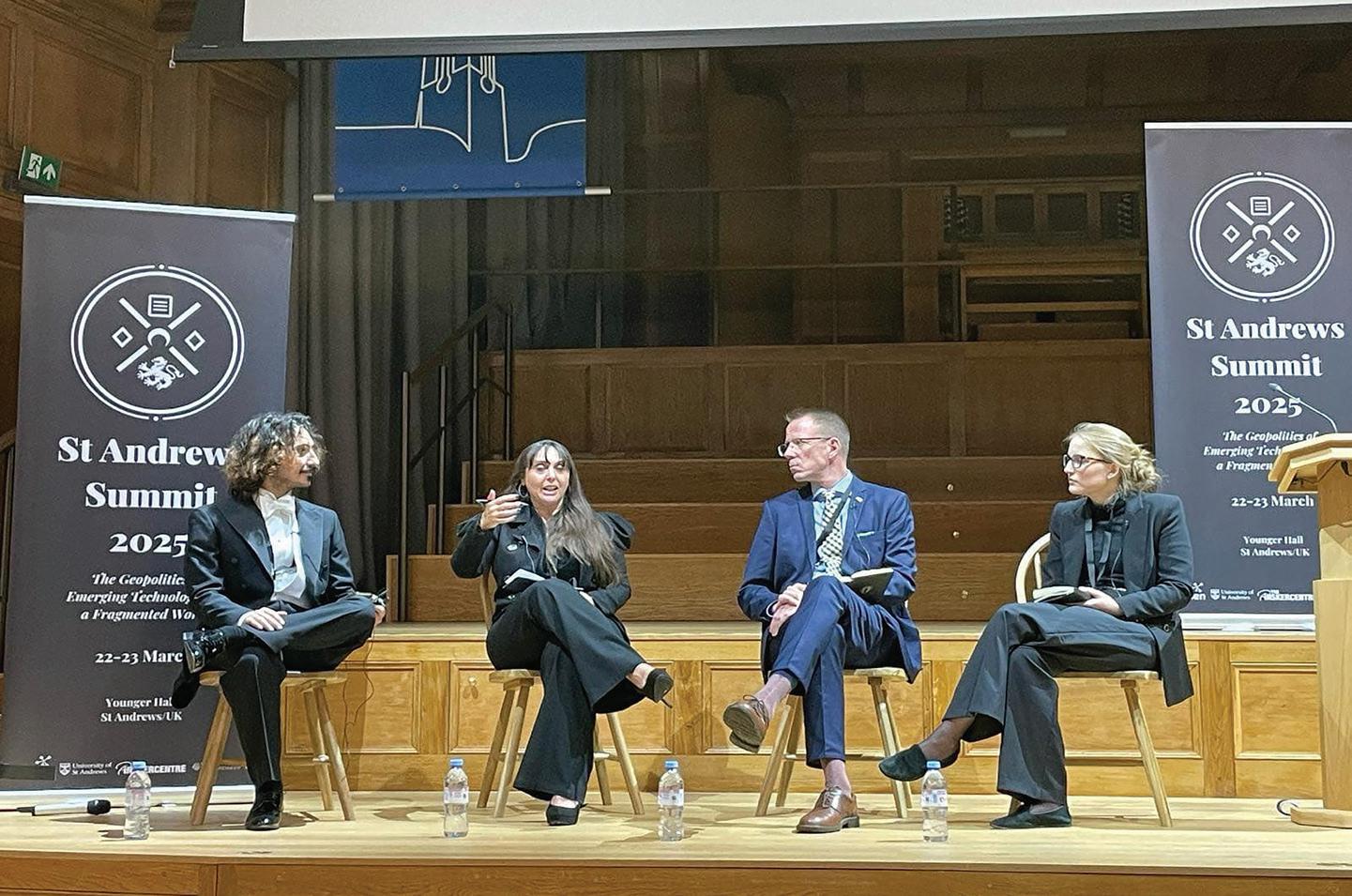
Boray Taspinar-Sherifovsky, the Summit’s President, and current student, emphasised the event’s evolution and expanding scale, noting that it has grown beyond its previous format under the Foreign Affairs Society.
He stated: “In some ways, it has been running for twenty years. In some ways, this
St Andrews South Street Extensions Approved
PARIE DESAI News Writer
On 12 March, councillors on the North East Planning Committee agreed to make the pavement build-outs permanent on South Street. As a result, cafes, bars, and restaurants along the street will retain their outdoor seating arrangements.
Pavement build outs were originally introduced during the COVID-19 pandemic in 2021 to allow businesses to continue operating with the correct social distancing guidelines in place. At five different locations on South Street, the council temporarily extended the footway width to allow for more tables and chairs to be placed outside.
Convenor of the North East Fife Planning Committee, Councillor Jonny Tepp, lauded the meeting’s verdict: “I think the right decision for St Andrews has been made today. The leisure and tourism sector is one of the town’s key employers and is vital to keeping the economy strong.”
He continued: “These outdoor spaces have proven very popular with locals and tourists. Some of the objections focused on the loss
of forty car parking spaces in South Street, but parking is not a material consideration in relation to these planning applications.”
The results from a large public consultation show that 46 percent were in favour of keeping the additional pedestrian spaces, versus 42 percent who wanted them removed.
Ayben Sinclair, owner of Neighbours Cafe on South Street, was in favour of the additional space: “My cafe is quite small. I’ve only got five tables inside, but because I’ve got the area outside, it helps my business.”
When asked about the implications of these permanent build outs on her business in the future, she expressed confidence, particularly for the summer months: “We don’t obviously get a very good summer all the time, but when we do, people really look forward to sitting outside.”
Moreover, Sinclair shared that she is Turkish and that in Turkey there are plenty of outside sitting areas, primarily because of the warmer climate. She compared her home country to the UK, describing how, unfortunately, outside sitting areas cannot be found everywhere here. Sinclair believes that the move will make St Andrews stand out.
is the first year it’s ever happened. It certainly was the largest summit of its kind in Scotland in some years. I don’t think anything of the sort has happened anywhere in Scotland. We had think tankers and policy makers from IISS, the Royal United Services Institute, Chatham House and quite a few others
coming from London and beyond, which, for a small town like St Andrews, is kind of insane. This year’s summit was intended for genuine knowledge and value exchange. The theme is so multi-dimensional and interdisciplinary that it requires voices from policy, diplomacy, physics, and beyond.”
Around seventy students attended the event, but TaspinarSherifovsky hopes participation will grow in the future, particularly if funding allows for lower ticket prices.
“We hope that in the future, with enough sponsorships and alternative funding, we can make the summit even more accessible,” he said. “The response from students has been overwhelmingly positive,” he added, noting an influx of emails from those eager to be involved in next year’s event.
“It says so much more than any other piece of feedback — more than a clap or a thank-you message. People want to be part of this, to contribute, and to shape its future.”
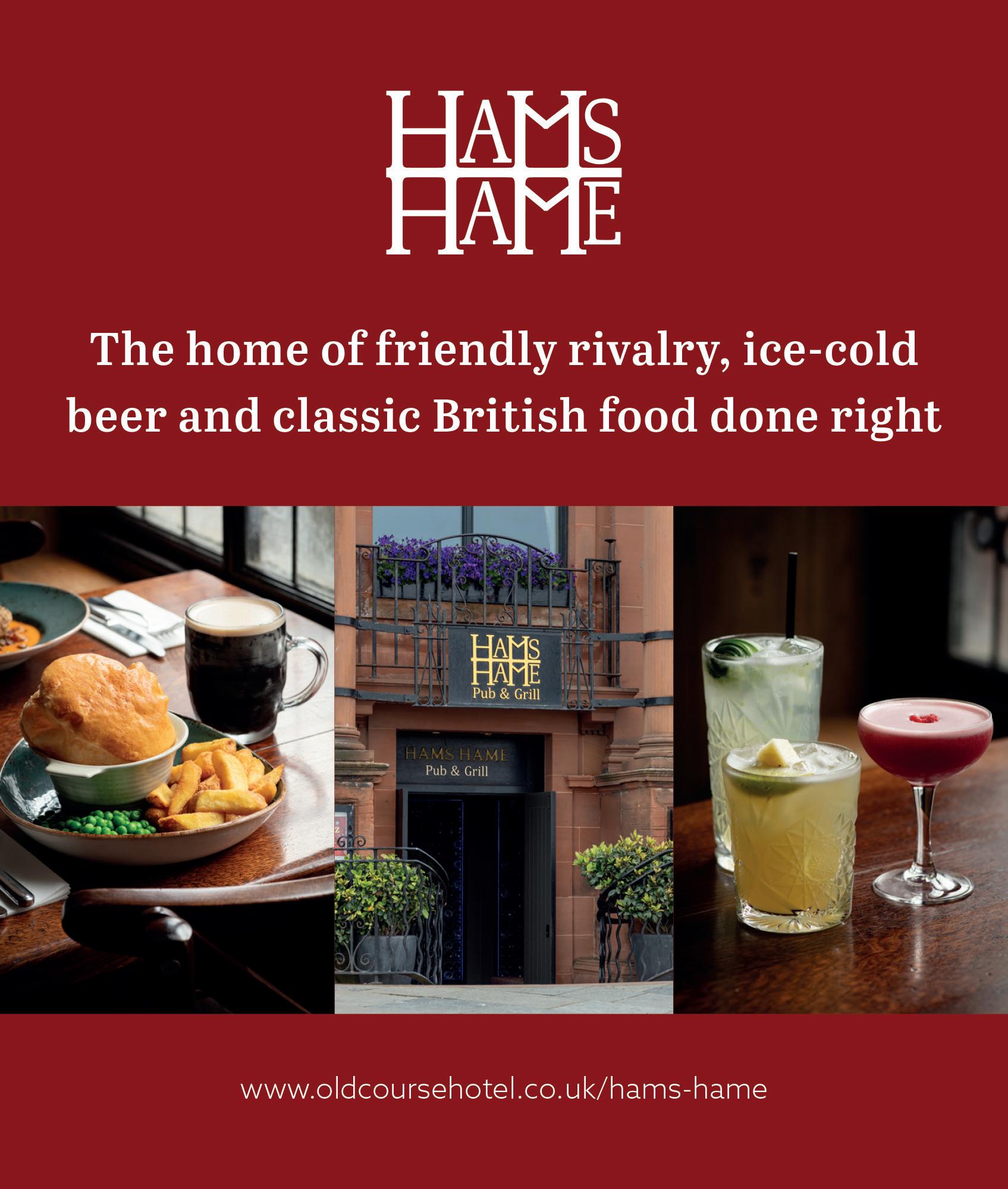
Image by Alexey Shamagin

Viewpoint
I Want to
EDITOR: GEORGES TOULOUSE
be a Mum With Dad Lore
Why women should live to the fullest before settling down
MISTRAL ZERBI Viewpoint Writer
Ever think back to your dad’s dinner-table stories and realise ‘dad lore’ is mostly insanely dangerous shenanigans he rebranded as character building? As a girl, I heard those stories like fiction — but I bet most boys saw them as a blueprint. Unlike boys, who are brought up to believe that their bodies are made of rubber, girls are often encouraged to stay safe, to preserve their bodies and minds as if they were delicate heirlooms. While boys are often excused for erratic and reckless behaviour, girls simply don’t get away with being silly or impulsive. And I’m not just talking about expectations — that girls should be smarter, more composed, more mature — but also physical risk. We will be discouraged from having riskier pastimes: like, don’t learn how to skateboard, or ride a bike too fast, because ‘you could hurt yourself’, and scars are certainly not pretty on a girl. Girls are taught to play it safe — but it’s time we make our own mum lore and start living for ourselves. Even if it’s not our own parents discouraging us, someone or something else will. I know this from personal experience. My mother was my number one fan when I learned to skateboard at age thirteen. Even with her support, though, I found myself leaving my board behind when I moved to university, because it simply didn’t fit with the heels I now felt so confident wearing. I certainly had grown more confident, but annoyingly cautious compared to my younger self. I see this as a common feminine experience: we start choosing safety over freedom. We choose what we know over what we don’t. Being a girl is a constant identity crisis, torn between an emotionally-impulsive heart and a mature, cautious mind. More often than not, the mind wins — especially when it comes to making decisions about ourselves. Ironically, the only time we let our wild hearts take the
lead is in decisions involving boys. Maybe, if we just decided to flip the script, leaving the cautious mind to take the lead in our love lives and letting our crazy hearts choose how we live and who we become, life would be much easier… and more fun.
are rarely questioned, and their detours are seen as adventures. They don’t hesitate to centre their lives around themselves at all times, even if it sometimes comes off as selfish.
Women, on the other hand, are conditioned from a young age

inadvisable part of it. That lack of regret came from dreaming recklessly and living freely, on his own terms, never waiting for anyone’s approval. Here’s the difference: men grow up as the main characters of their own stories — their choices
SAFFRON ROWELL Viewpoint Writer
One of the only lockdown trends to have not only permeated the public consciousness, the ick has a powerful hold on the landscape of modern-day dating. Five years on, now that we’re not sixteen anymore...
our life choices, our crazy plans. Maybe it’s time we learned from that unapologetic male confidence — not to be careless, but to be free. Like Gillian Anderson said: “Follow your dreams, not your boyfriends.” We
Some Things Should Die
ALDEN ARNOLD Photo Editor
The Abrahamic religions have a contemplative proverb that goes, “For you are dust, and to dust you shall return.” In Christian mass, this line is recited every year on Ash Wednesday as a reminder...
deserve to fall in love with our own life before we fall in love with anyone else. The life we will look back on — hopefully with laughter and pride — won’t be the life we carefully curated, but the one we simply lived. We should plan that solo trip we always wanted to plan, try that sport that seems too difficult at first, or express that opinion that we were once told was not ‘ladylike’. Who cares, really?
Our future ‘mum lore’ will be made up of all the stories we live before we meet the dad of our future kids (if we choose to have some). It’s the life we build before we find someone worth settling down with. So until we do, why should we give anyone the power to tell us how to live the right way? University is the best opportunity for us to build our mum lore, developing our intelligence and critical spirit, but also uniquely unhinged personalities, and live stories worth telling our future kids.
One night, my girl best-friend and I decided that a construction road sign would make a fantastic decoration for my new living room. Why? Well, the right question is, why not? Not everything has to make sense, and not everything has to be a thought-through, mature decision — something we often forget as we grow older. Sometimes, the only logic that matters is choosing to have fun with our fellow women and enjoy the time with the people who are closest to us. Living by the rules is safe, but we all know that rules were only created because it’s more fun to live without them.
As women, we already know that the future awaiting us — for those who choose to be mothers one day — will be a life full of love but also full of responsibilities and duties. Hence, we have an overwhelming responsibility to ourselves first: to get rid of that imaginary boundary that blocks us from living how we want to. Remember the only person you could ever truly disappoint is your future self.
Illustration by Maya Mason
Whine and Dine
Why excessive complaining kills
TRUMAN CUNNINGHAM Viewpoint Writer
I’ve often said I speak ‘anecdotally.’ When I make my points, I pull from personal experience. In a kind of storytelling format, I usually open with a story and then I try to universalise; if I’m contributing to...
Devil’s Advocate Is it wise to be friends before dating? NO 7% 93% YES

What should come first: the date or the friendship? The answer seems obvious to me: friendship. And yet, somehow, this is treated like a wild proposition. The modern attitude toward relationships seems to treat friendship as optional or something to be tacked on later. If you can get past the awkward small talk and enough of your personality is obscured by dim lighting and flattery, you’re halfway there. Only later do people realise that being able to talk to someone for more than an hour without wanting to leave is rather important.
There is nothing especially radical about suggesting that you should probably be friends with someone before you date them, or at least to consider it first. To me, it’s one of the few self-evident truths about relationships. The qualities we want in a romantic partner — trust, support, and the ability to be present without constantly checking our phones — are exactly what we’d expect from any friend. Yet, somehow, when romance enters the picture, these essential traits are treated as bonuses or ‘green flags’ rather than basic prerequisites.
There’s probably a reason why every first coffee date I’ve been on has completely failed to show my actual personality. First dates — especially with strangers, or at best a mutual friend — are awkward by default. You don’t know the person, so you end up stuck in this loop of stiff, interviewstyle questions about hobbies, favourite films, and semi-uncomfortable small talk. I could easily talk for hours about music — new bands, old genres, pretty much anything. Yet, when someone once asked me about my favourite artists over coffee, I panicked and said Taylor Swift — which is both untrue and slightly embarrassing.
Of course, the friend-first approach can complicate romance. The better you know someone platonically, the harder it can be to imagine — or risk — changing the relationship. The more you consider them as something more, the more it

Many swear by the fact that good friends make for good partners. After all, a platonic friendship seems but one step removed from a romantic relationship. You already like your closest friend. You share the same interests, you feel comfortable around each

This is why friendship is the best testing-ground. It reveals the qualities that would otherwise potentially take months of dating to uncover. You get to see if you truly enjoy their company beyond the superficial charm they might only be able to maintain over a single dinner date.
just friends, throwing romance into the mix probably isn’t going to work out any better.
In short, I think friendship is more of a foundation in a relationship rather than just a helpful bonus. It might not be exciting enough to inspire any corny novels or films, but it does tend to make for fewer catastrophes. Which, frankly, seems like a reasonable trade-off to me.
attracted to this person, can ‘feel that spark’, and do really want to give it a go, I won’t stop you, but, I would be severely remiss if I did not at least present the following advisory warning on desiring, expecting or — God forbid — attempting to live your ‘friends-to-lovers’ fantasy. The drawbacks of dating friends might seem obvious. Mutual friends might find
the new dynamic difficult to adjust to, as will you and your now decidedly not so ‘friendly’ girl- or boyfriend. Then there’s the possibility you break up. Not only do you lose a good friend, you also risk being stuck in a pseudo custody battle over your other friends. Think deciding who keeps the goldfish is tough? Try deciding who goes to the next pub quiz with the ‘gang’. It is not these clichéd drawbacks, however, which I think constitute the real trouble with the friends-to-lovers fantasy. It is precisely the fantasy element. If you had a genuine romantic connection capable of blossoming into a long and healthy relationship, you wouldn’t be realising it years into knowing a person. It’s more likely that one of you is significantly more interested in the other, and that it is only the realisation that this interest is there that prompts the other person to ‘give it a go’. Worse yet, both of you may, in fact, be deluded – perhaps out of familiarity or utter desperation – into thinking that each other’s likeable personality and half-decent looks is enough to carry a relationship. The slow-burn friends-tolovers fantasy of two ‘besties’ coming to realise that they’ve always been meant for each other is just that — a fantasy.
Even then, if such a ‘relationship’ does develop, it isn’t always rosy either: dating a friend often means dating someone with whom you didn’t have enough of a mutual spark to generate a proper romantic relationship much earlier and with whom you probably never will. Now, I’m not saying you enter into serious relationships the first day you meet someone. But, if from that first day you can already sense that warm and tingly amorous feeling develop, it is a much better sign you’ll be able to sustain a proper romantic relationship. While great friends do not always make for great partners, great strangers make for great dates, which make for great partners, which make for best friends.
Illustration by Janya Malkani
The opinions expressed in this publication are those of the authors. They do not purport to reflect the opinions or views of The Saint.
Smoking Hot
The mysterious appeal of the tobacco enthusiast
SUNAA AHMED Viewpoint Writer
They say everything improves with time, and more often than not, they are right. A few months is all it usually takes to love a place, to fall for its quirks and its foibles. Six months is about how long it took me to wrap my head around St Andrews, getting over the imposing grandeur of Sally’s Quad juxtaposed with the unashamedly Sovietlooking Gannochy House. Yet there is one building to which this cliché cannot be applied; of which, the opposite is true: for me, the Main Library has grown more repugnant with each passing year. Its hospital lighting, mismatched carpets and low ceilings offend the eyes and bewilder the senses. On the rare occasions I cannot avoid visiting, I rely on the minority of people milling about the entrance to restore my sense of aestheticism, reminding me that a kind of casual glamour can exist even in the greyest, most lifeless of buildings. I am talking, of course, about St Andrews’ dedicated smokers. Granted, there is nothing cool about trying to smoke. Most of us, driven by the joint forces of teenage arrogance and inebriation have given it a go. It almost inevitably ends with a fit of asthmatic coughing, a keen sense of embarrassment, and the promise that no such foolish experiment shall ever be carried out again. However, the community outside the Main Library has no such smokers, and there is no inexperience or amateurism as they lift their smouldering rollies to their lips. They smoke not because they feel the need to boost their status or to impress sycophantic passers-by like myself, but
because it is a kind of sacred ritual. I’m perhaps a little ashamed that everything about them appeals to me. The treasured lighters they keep in back pockets, the way they tenderly lick their papers closed, the cupping of hands around the flame as they light up. A mixture of admiration and jealousy takes over as I walk past, and each time I curse the good sense that prevents me from joining this coveted community.
A few quick conversations with friends prove I’m not the only one who finds
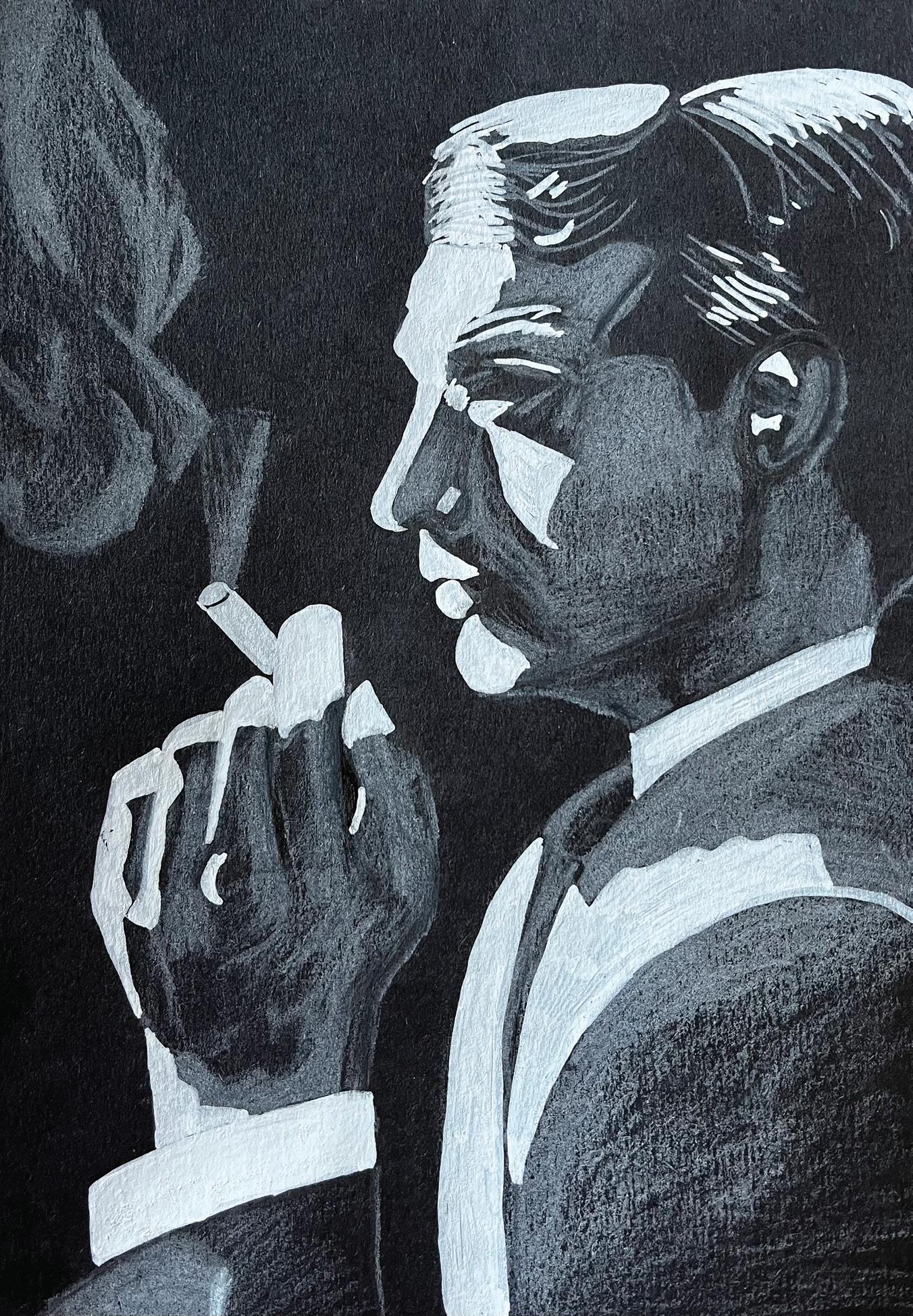
smoking so appealing. Many agree that the performative smoker, the one who does so only in big groups with the hope of an audience, is far more of a turn off than a turn on. The casual smoker is different, there is something of the bad boy (or bad girl) about them, a kind of devil-may-care attitude that doesn’t let the thought of blackened lungs
bother them. I think movies must take a large share of the blame, as some of the most attractive individuals to grace our screens have done so with a cigarette. Take Hugh Grant in Bridget Jones, emerging delightfully sodden from a river with his shirt open, his lit cigarette balanced crookedly in an irresistibly arrogant grin. The same argument can be applied to females, with Basic Instinct’s Sharon Stone springing to mind. As she snaps her delicate leather holder shut, resting her cigarette against elegant fingers with a kind of easy grace, all thoughts of carcinogens melt (literally) away. Although smoking is responsible for 7 out of 10 cases of cancer, with over sixty different substances known to be toxic, it is hard to care when the Hugh Grants of the world make it look so good. Perhaps smoking is attractive because of the violently unappealing nature of its alternatives. Vapes, though considerably less harmful than cigarettes, lose any charm to their bubblegum flavourings and hot pink exteriors. What’s more, within the corrupt world of marketing, their target consumers are teenagers, with children as young as twelve using them daily. Elf bars and Lost Marys are the new alcopops, and where the tween may once have looked to Brain Lickers or Toxic Wastes for their sugar kick, a Cherry Ice Crystal Bar now offers a far more addictive alternative. Perhaps, vapes might even provide the solution to my less-than-commendable admiration of the seasoned smoker. Print rolling paper exclusively in Baby Pink and Lime Green, replace regular tobacco with a spiced peach alternative, and the addict’s roguish charm will likely fade into smoke.
Serial Griever
by Natasha Currie
I recently stumbled upon an article in the Let’s Talk About Loss blog: ‘Three Ways Fleabag Depicted Grief Perfectly’. As a long-time Fleabag fan, it struck a chord with me and reminded me just how good the show was. Mulling it over further, I propose a fourth way that Fleabag depicted grief perfectly, and it’s through the tumultuous dating life of Fleabag herself.
Whilst I haven’t yet found my Hot Priest, I do have some similar stories to the pseudonymised ‘Bus Rodent’. My friends still talk about ‘Bike Boy’, the bike mechanic I once went on a supremely hungover date with. The kind of date you simply cannot miss, despite your alcohol-induced weakness, because it was arranged by your mother in exchange for a free road bike service. Thanks, Mum! There are several others who I will save from embarrassment, but since my mother’s death I seem to have stalled the collection of my beloved dating stories. I have found myself straying into an introspective haze that does not align with meeting someone. For the first time in a long time — maybe ever — I am a little scared to hand over my heart. The entire promise of dating and the hopeful suggestion of a fresh start just feels misaligned with grief’s refusal to offer a clean slate. Fleabag perfectly captures the way grief makes you crave connection but also makes you recoil from it. We see this dichotomy in Fleabag’s dating trajectory: full of selfsabotaging one-night stands, rebounds to Harry, and the defiant chase after Hot Priest. She throws herself at these connections, not necessarily because she believes in them, but because she is desperate to feel something other than grief. Yet, in her most vulnerable moments, hyper-independence becomes a protective armour covered in spikes which stops people getting past that first or second layer and actually seeing her for who she is.
As I prepare to graduate St Andrews (gulp) and enter the real world, dating has been looming in my mind like a deadline. The prospect of an entirely new pool of people to meet is both terrifying and enticing. St Andrews has offered me the comfort of being known and safe in my grief. My friends and all the readers of The Saint know, so it’s a pretty tight circle. The real test lies ahead: stepping into empty spaces where I have to build everything from scratch. Dating after grief isn’t just dating — it’s risking another heartbreak in a heart that is already hurting. However, if Fleabag can do it — messily, painfully, and with a lot of wine — then I suppose I can too. Eventually.
Illustration by Isabella Abbott

LEWIS MACKINLAY Viewpoint Writer
The stock market thrives on stability, Trump is anything but. His erratic trade policies, tariff wars, and inflammatory rhetoric have made markets a rollercoaster of uncertainty. His unpredictable outbursts send investors into frenzies. Volatility follows him like a shadow, and in an economy where confidence is currency, his return is fuelling the turbulence investors fear most.
Got you! Or sike, as the cool kids say.
If you’ve been following my fortnightly op-eds, you may have expected yet another whine about the pitfalls of a second Trump presidency. But no, that was not me. The opening paragraph you’ve just read was written entirely by my everreliable (and slightly unnerving) friend, ChatGPT. Could you tell? Probably not. Did you roll your eyes? Likely, yes. And that, dear reader, brings us to today’s real discussion: AI’s ability to replace journalists.
Every time someone groans about how AI is “coming for our jobs”, I point to one profession as an exception: journalism. The usual rebuttal to this is that AI is already replacing journalists. But here’s the truth — AI will never replace real journalists.
True journalism isn’t just about compiling facts. It’s about investigation, analysis, and, most importantly, storytelling. Journalists don’t just report what happened; they ask why it happened, who is responsible,
AI Wrote This
and what it means for those affected. They verify sources, challenge authority, and present information in ways that move, shock, or inspire audiences.
Think about the war correspondent dodging gunfire to report from the front lines. The dedicated investigative journalist spending years unearthing corruption. The local reporter sitting in a disaster zone, listening to survivors recount their losses. These stories don’t just require facts — they require understanding. They also require genuine empathy, which AI cannot partake in.
Of course, AI is already in the newsroom, and in some ways, it’s proving useful. Companies like Newsquest have introduced roles such as “AI-Assisted Journalists”, where AI generates routine reports using human-inputted data. It can sift through mountains of press releases and quotes, transcribe interviews, and even detect
misinformation (as quick as it creates it, that is) faster than any human. The journalist can throw in the mundane and be instantly gifted with a publishable story. This, as Newsquest’s Head of Editorial AI, Jody Doherty-Cove, put it in 2023, allows the reporter to instead “do that human touch journalism that really resonates with the communities.”
But the key here is that it can assist, not replace. AI can support journalism, but it cannot be journalism. It can summarise a government report, but it can’t press a politician for a clearer answer. It can compile statistics on a humanitarian crisis, but it can’t capture the raw grief in a survivor’s voice. Some of the most powerful journalism is driven by human connection.
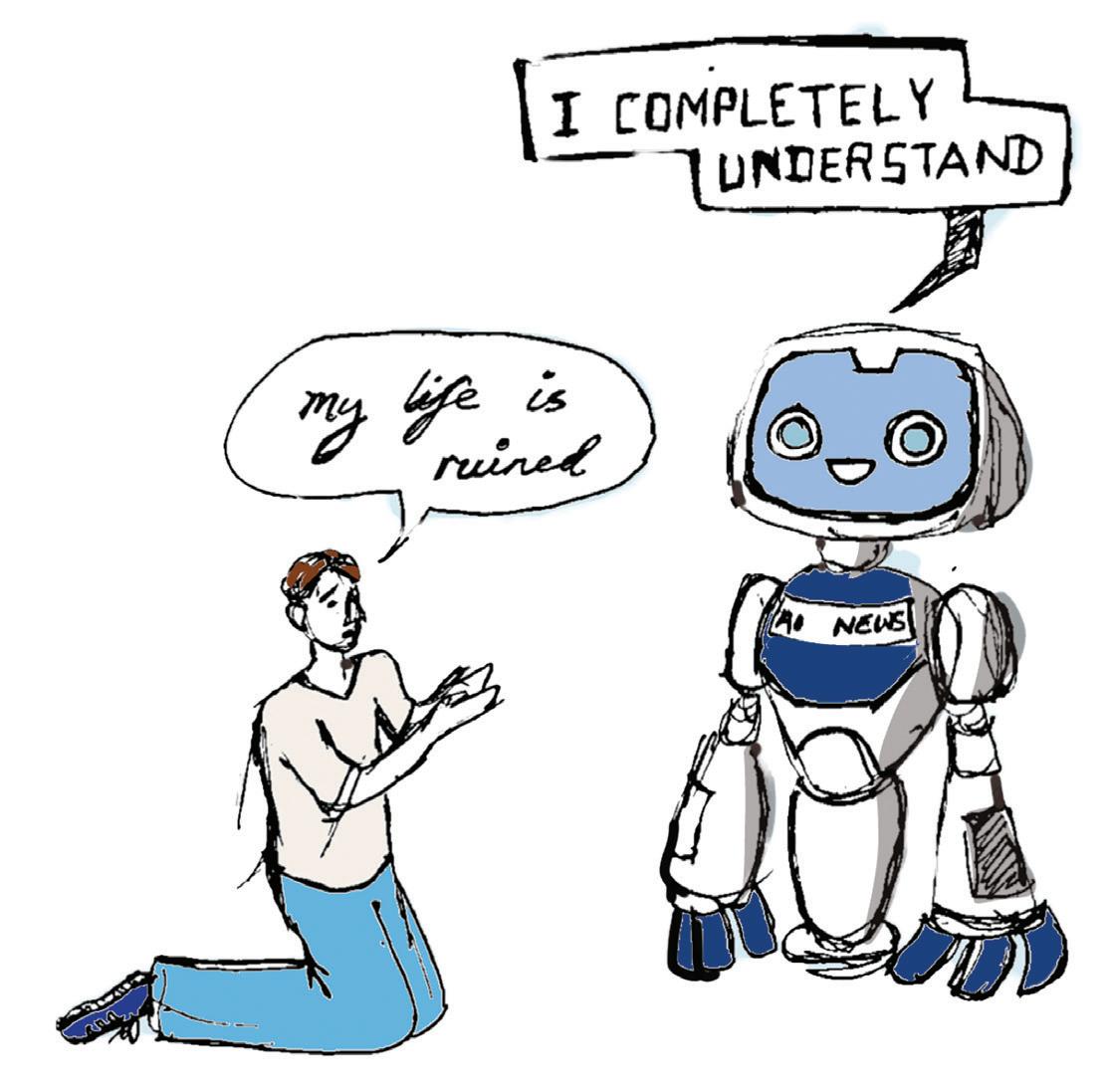
It’s the Pulitzer Prize-winning investigations that expose abuses of power, the personal narratives that force society to confront uncomfortable truths. AI can process language,
but it cannot feel — it cannot grasp the weight of a mother’s sobs or the tension hanging in a courtroom as a verdict is read.
Another fundamental flaw is that obviously AI cannot step out from behind a screen. Journalism thrives on organic, real-world engagement. Reporters attend protests, knock on doors, track down reluctant sources, and immerse themselves in unfolding events. No matter how advanced AI becomes, it cannot stand in a crowd and sense the energy of a moment. It cannot read between the lines of an evasive answer. It cannot tell when someone is lying — not truly.
Sure, AI could, in theory, replace a television anchor. A perfectly polished digital face, emotionless and efficient, reading headlines with robotic precision. But would audiences accept it? Would we trust it?
Even the most scripted news broadcasts with a real yet robotic presenter require real journalists behind the scenes — gathering, verifying, and structuring information. Without them, AI is left assembling disjointed pieces of unverified content, hardly a foundation for credible reporting.
For now, the journalist’s job remains safe. Until politicians, survivors of the world’s tragedies, and lottery winners feel comfortable sharing their stories with a robot, there’s nothing to worry about. Journalism is, at its core, a medium for human-to-human connection — something AI has no business being involved in.
Illustration by Elizabeth Yang
Kamala and I: the Struggle of Ethnic Names
GAYATRI CHATTERJ Viewpoint Writer
If you’ve just picked up this copy of The Saint, as it was no doubt thrust in your face by one of us overeager student journalists, then, by nature of this town, your name is probably Emma, or George. Or Tom, or Olivia. I say this with absolutely no intention of targeting or attacking the 80% of this student body. It is the UK after all, an abundance of people with British names is to be expected.
The UK has become a melting pot of cultures, whether due to its current status as a global metropolis or its colonial past. However, this isn’t reflected in the culture here, and many of the social interactions I’ve had in this town — most notably, experiencing a genuine and visceral fear at the thought of having to introduce myself to new people — reflect this.
On move-in day in my first year, I made an impulsive decision driven by panic: to rely on the shortened form of my name to
save myself and others from the inevitable butchering of ‘Gayatri Chatterji’. It was my first time being in a predominantly white environment, and I hadn’t anticipated how deeply I would feel it. What used to be the occasional mispronunciation from an American teacher who called me
“Gitari” in class (my school friends still laugh) was about to become my everyday reality. My anxieties hyper-fixated on such episodes from school, as I felt the same dread I experienced when a new teacher who wasn’t Indian tried to say my name.
I grew up resenting my name, wishing my parents had chosen something more palatable to the Western vernacular. I remember feeling a deep-seated mix of rage and envy when I learned my cousins had deliberately been given ‘easier’ names to pronounce, because they too were born and raised abroad. Relief would wash over me — and continues to do so — when I meet a fellow South Asian for the first time. I know I can tell them my name without wincing
beforehand or afterward, and hear it said back to me with the nonchalance of it being a known and common name. It’s the kind of interaction and feeling I continue to chase even now.
Gaya, as I am called here, was, before university, ‘coined’ by close friends who shortened my name affectionately. I was known by that name — but out of closeness, not avoidance. With time, I’ve come to appreciate that it has become a way for me to present myself more easily, helping me integrate with the people I meet in this town.
This was made all the more unfortunate when people would exclaim, “Is it like the Greek goddess?!” and I would have to deliver my well-rehearsed but dreaded spiel. I suppose being proud of a name I constantly find myself having to explain can feel impossible, and it certainly did as I attempted to adjust to this university environment. I regret not being more comfortable with the fact that I have an ethnic name, one which is millennia old, one that holds such
weight, and, over time, I’ve come to know is beautiful. It represents my culture and heritage, something unavoidably loaded here in the UK. Indeed, my surname, which was anglicised during British rule in India due to administrative ‘difficulties’ with writing and pronunciation, eventually stuck and became a normalized part of the cultural landscape in independent India. That legacy is not in my control, but I no longer have any desire to further perpetuate it by shortening my first name. Especially not when I share it with some of the most influential scholars of postcolonialism (IR students: check your reading lists, the name is Spivak).
I like to think I’ve decided that this is a hill I’m happy to fight and die on: my name is my name. That being said, I can’t promise that dread and panic won’t strike the next time I find myself making introductions. But for now, it’s Gayatri. Not Gertrude (no, I’m not joking). Ga-yuh-three. Soft ‘t’. Not as difficult as you think to pronounce. And no, it’s not ‘unusual’. It’s just ethnic.
Not to Brag, but I’ve Got a Big Bag
Upsise your bag to upgrade your life
POPPIENA HORSINGTON
Viewpoint Writer
In a world marked by arbitrary divisions and categorisation, there is one binary I do consider crucial: the question of ‘Small Bag’ or ‘Big Bag’. Understanding someone’s toting habits is vital to my evaluation of our compatibility, as a large luggage advocate myself. Yet, recent trends have tried to push the ‘clutch’ and other such teeny-weeny item-holding accessories onto the average person. Just as the Lorax spoke for the trees, I am here to speak for the Big Bag; less so the bag itself, but rather the loyal companion who dons this impedimenta selflessly. They are a crucial addition to the hangout and their sacrifice is not one to be overlooked. In many ways, lugging around the Big Bag is a labour of love. Knowing that you have supplies to last a nuclear winter — while being thoughtfully prepared for every season and circumstance — clearly makes you the most valuable asset at any event. Fresh injury at the function? Band-aids hidden away in one compartment. Sudden sore throat? Water bottle and lozenge handed
your way before you even have the chance to properly cough. Do not even start me on the portable charger capabilities! Only the Big Bag friend can feel such a deep desire to selflessly provide for others. Like a guardian angel, they brace for crisis so that they may delicately swoop in (never weighed down by their colossal accoutrement) and immediately ease tensions and conflict.
To those of you arguing that no

hunter-gatherers? Is the Big Bag not an epigenetic phenomenon made to appease
our instinct to covet knick-knacks? Yes, I do carry around tissues, paracetamol, and an umbrella, but the power of the Big Bag also allows me to bring my ticket to the Franz Kafka museum — and a pack of Formula One trading cards — with me everywhere. That hoarding capacity is unrivaled, I tell you. Who hasn’t wasted at least an hour of their lives watching a ‘What’s in my bag’ video? We all know the most interesting ones derive from the largest reticule!
Think Anya Taylor Joy or Ariana Grande: people who carry the most impractical things in the largest accessories you’ve ever seen. There are stories hidden within these hefty totes that go unseen, tucked away in zippers and pouches. You see a Big Bag making its way down the street and think: “Just what could be in such a capacious purse?” I see such a spectacle and grin, knowing that its secrets are waiting to be handed out to the right people. I feel compelled to add that large luggage
is not distinctly gendered. Its call can beckon to all, yet not all are brave enough to shoulder the burden. I have a male friend who, on the nights out of our younger years, would haul around a humongous backpack filled with various spirits and mixers to sustain the student body. A mobile bar of sorts, if you will. His willingness to freight these libations around town throughout the night made him greatly beloved. Yet it raises the question: if he didn’t, would anyone else have made the sacrifice? The answer is: probably not — but why? What is it about the Big Bag that intimidates?
The accessory does not have to be bulky either, it can remain sleek despite its mass of contents. Backpack, handbag, crossbody messenger, even a shopping bag — your options for expanding your holding capabilities are wide and varied.
The time comes for you to consider your place in this world. As the Lorax says, “A tree falls the way it leans. Be careful which way you lean.” As you walk the streets, look around and take note of those who have embraced the liberating lifestyle which comes with Big Bags. Only you can make the call to join them.
Illustration by Magdalena Yiacoumi
Naturally, My Dear Watson
Investigating the Earthy-Crunchy
SAM SPENDLOVE
Viewpoint Writer
I’m going to describe to you what we Bostonians would call an ‘Earthy-crunchy’. I think even if you’ve never heard that word, you’ll know who it refers to: those wary of doctors and paracetamol, very interested in the ‘buried wisdom of our ancestors’, and almost always anti-vaxxers or vaccine skeptics. They usually follow this ideological vein to other conservative beliefs that coalesce around the idea of what is, in their minds, ‘natural’ — gender roles, doubts about climate change, the list goes on. And it turns out they’re everywhere.
I’ve never been naive about the complexities of political affiliation — I know that any belief can coexist in abject contradiction with a person’s identity or circumstances. But, after encounters with multiple Earthy-crunchies in my age group, I’ve only just started to appreciate how such an ideology functions — how the integrity of the scientific method comes to be questioned by people who’ve never known life without it.
Earthy-crunchies idolise the past.
They idolise it to such an extent that their ideology starts to feel more like an aesthetic sensibility than a set of beliefs. They work off of what looks and feels ‘natural’ — and from that they decide what’s acceptable or effective. To the Earthy-crunchy, we always knew better back then. Sometimes they stumble upon a real historical injustice: for example, male physicians commandeering the process of childbirth and all but erasing the wisdom midwives had been bringing to the practice for centuries. But, from this, they make hasty and fallacious jumps: all evidence-based medicine is founded in a similar lack of humanity, vaccines give you autism, and pasteurised milk tastes better because, despite the risks, it’s untouched ‘Natural’ becomes a cloak for ‘alternative’ — anything that does not appear institutional is automatically a form of resistance against crushing, clinical modernity. Within this way of thinking there seems to be a tension between simplicity and complexity. The Earthy-crunchy learns to associate the natural with the intuitive and effective. Evidence-based medicine — with all its mysterious pills, Latin names, and
complex manufacturing processes — is as convoluted and deceptive as modern bureaucracy. That’s why any sort of systemic concern is forgotten: it’s all an illusion put up by the scheming modern world to distract us from the intuitive wisdom we should be turning to. Because Earthycrunchies are often white and relatively privileged, the whole ideology — despite being created by genuine fear — often strikes one as a selfish lack of perspective. Science is amoral, often cruel and misused, but almost never (and certainly not systemically) against white homesteaders in Britain or America. Of course, it’s worth noting that rural communities often lack healthcare infrastructure — but this is an entirely different issue to deliberate conspiracy. It might explain distrust, but it doesn’t redeem it.
When it does harm a group like the homesteaders — such as in the thalidomide scandal (1960-1962) — it’s addressed swiftly and with about as much regret as you can expect from a corporation. When it’s misused against disenfranchised groups — such as in the syphilis study carried out on the Black population of Tuskegee,
Alabama — it can take more than half a century to be properly addressed, if it ever is. The issue is that Earthy-crunchies get to audit a world of easy-access healthcare while actively undermining trust in it. They can only go unvaccinated because they happen to live in a place where herd immunity keeps them insulated from the diseases they expose themselves to. They can freely abandon their conspiracy theories in emergencies, accessing reproductive care or life-saving treatments, because they know modern medicine will be there for them when push comes to shove. Unlike disenfranchised populations, they have a safety net — one that even the most sincerely held distrust can’t remove. Communities genuinely touched by disease don’t question the necessity of evidence-based healthcare; privileged Earthy-crunchies might benefit from gaining perspective through them. I can’t take away anyone’s right to skepticism. But I can call attention to the lack of principle. In the same way you can’t just ‘not do’ politics, you can’t just ‘not do’ science. Sadly, earthy-crunchies, filled with self-satisfaction, will likely continue to try.
The opinions expressed in this publication are those of the authors. They do not purport to reflect the opinions or views of The Saint.

HANNAH HEILMAN Features Writer
Content warning: sexual harassment.
EDITOR: SIMON EZRA JACKSON
When a Safe Ride Isn’t Safe
Confronting sexual harassment in taxis
was nearby to signal for help. Noah said the driver then asked him to either pay £50 or take off his shirt. Noah refused to take off his shirt, but the driver then wouldn’t allow him to pay the £50.
Taxis line every main street in town. For many students, they offer a way to get home safe after a night out. Taxis get you to class on time, to social outings, to nearby towns. But are they truly safe?
The Saint interviewed two students who experienced sexual harassment using taxis in St Andrews.
Details of the encounters should be read with caution.
The first incident happened last summer. Noah, who was a postgraduate at the time, had joint pain and was running late for a dissertation meeting, so he hailed a taxi from Church Street to North Haugh.
Noah paid by phone, but as he tried to leave the car, the driver said Noah hadn’t paid. Noah showed the payment receipt on his phone but the driver said it hadn’t gone through. Then, he then locked Noah’s passenger door. Noah agreed to repay the £5 fee, but after the driver pulled out the card reader, he increased the charge to £15.
“I was trying really hard to toe the line between being assertive, being like, ‘You can’t do this to me,’ and also, ‘You know how you’re perceived’.” As a genderqueer man, Noah felt he was targeted because the driver viewed him as a woman. “I’m really small and he was bigger than me, so I realised that I’m within reach of this person. I don’t want to give him an excuse to do something, but also, I need to go.”
Noah argued back about the fee — the driver even tried holding the till under his phone to force the payment. Eventually, Noah agreed to pay the £15. But the
“This is turning into a properly dangerous situation.”
driver would still not unlock the door.
At that point, Noah tried to call the police — but the taxi driver took his phone. “I was like, okay, this is turning into a properly dangerous situation.” He remembered looking around, but no one
“He still had my phone, so he held up the phone to my face,” Noah said. “He thought I had face ID and luckily I didn’t, my phone was really old. So he was trying to unlock my phone and was like, ‘Do you have any pictures of yourself?’ I was like, no I’m obviously not doing that, just let me pay you the £50 and maybe you’ll actually let me leave.”
Eventually, the driver let Noah pay the £50 and unlocked the door. A tutorial had let out and a lot of students were passing by. Noah went inside to the bathroom, where he cried and called a friend. That night he reported the incident to the police.
“I don’t think I processed it in the moment because I was so fight-orflight that I didn’t really have a chance to think about how shitty that was,” Noah said. “I was looking around a lot to see if there people and considering escape options. I was like, ‘Could I break through the glass?’ and thinking, ‘Do I just leave my phone behind?’ I just wasn’t conscious enough to recognise how bad it was […] I don’t think it really hit me until I was sitting in the bathroom crying.”
Noah sent screenshots of the charges on his banking app to the police. The taxi company was registered under a string of letters — not a real company name. According to Noah, the police said they would look into CCTV footage from the University to track down the licence plate number. But after calling for updates, the police told Noah they couldn’t comment further. Noah still hasn’t heard any updates, months later.
piercings,” Kat said. “He was like, ‘Is it alright if I touch them?’ It’s uncomfy to say no. So he went up to touch them, and then went up and stroked my face. I pulled away, but he was driving around in the countryside, literally country roads. I couldn’t have gotten out if I wanted to because I’d be in a field in the middle of nowhere with no signal.”
Over the course of 30 minutes, Kat said the driver asked if she lived alone — which she lied about and said no. He asked what a ‘sugar daddy’ was, but she said she, “didn’t want to initiate anything sexual,” so gave
“As long as I’m in my flat, I’ll be safe. I can lock the doors.”
I live.’ He could just come back at any time.” She called the non-emergency number, and that same night the police arrived at her doorstep to interview her. Kat told them she would be willing to press charges if anyone else came forward. Only three days later, another girl reported him, having had a nearidentical experience. The driver was then arrested, and his taxi license was suspended. According to Kat, a court date has been set for April, and he is facing charges of “acting in threatening and abusive manners”.

thing in Scotland, but in Manchester there are cases of people spiking cigarettes and vapes. So in the back of my mind I was like, ‘I’m not going to take a cigarette,’” she said.
“Afterwards I felt disgusting that it had happened,” Kat said. “I felt sick for myself, and I just couldn’t stop crying for ages. Then, after that, I just felt numb about it […] I was petrified to leave my house for days. Just walking down my drive to empty the bins I had a full-blown panic attack. I was just in my flat for days, all the curtains closed, sitting in the dark with a knife in my bed in case anything happened at night, my bedroom doors locked.”
In February, Kat Graves, another postgraduate, had her own taxi nightmare. After leaving the DRA ball and getting a pint at Aikman’s, Kat hailed a taxi off the rank on Bell Street. She lives 30 minutes outside of St Andrews, so she said she sat in the passenger seat to give the driver directions — something she doesn’t normally do.
“On the way there, he just started asking weird questions, like asking me about my
When they finally got to her house, the driver offered Kat a discount, which she initially declined, but after he kept persisting, she accepted. As she got out of the vehicle, she said he asked if she wanted a massage.
“I just kept thinking, ‘I’ve got to get home, I’ve got to get home. As long as I’m in my flat, I’ll be safe. I can lock the doors,’” Kat said. “But then when I got home and I was in my flat, I was like, ‘Oh s**t, he knows where
In a statement to Saint, the Students Union wrote: “Following the recent concerns raised around student taxi experiences, Your Union has been working with StAnd Together to look at how we can support students with clear, practical advice around getting home safely. Over the summer, Student Services will be working on a full update of the Good Night Out Guide, and alongside that, StAnd Together and Your Union will be developing general guidance on using taxis safely in St Andrews. We’re keen to keep the focus on empowering students with useful tips and reminders that apply no matter which company they choose to use, rather than making recommendations around specific firms.”
Illustration by Holly Ward
Who Killed The Witch Lake Eight? St Andrews’ early modern murder mystery
CELIA IRVING Features Writer
In 1987, workmen Thomas Campbell and Ernie Price were digging a garden when their shovels struck something more sinister than soil: human skeletons.
Edwina Proudfoot — a local archaeologist and now former director of St Andrews Heritage Services — was called in to investigate, uncovering eight intact skeletons. The eerie discovery fueled a longstanding question: Is Step Rock, formerly known as ‘Witch Lake’, haunted by St Andrean witches?
Just a hop over from the penguins at St Andrews Aquarium and a skip down from the cajun fries of Saint Sizzle lies the Step Rock tidal pool. Unlike its twin over on Castle Sands, the 300-by-100-foot pool is no longer available for public use. But in its heyday, the ‘Steppie’ was perhaps a midcentury 601 — a place to see and be seen. Originally a Victorian bathing spot for men and boys, the austere tidal pool transformed into the Grand Step Rock Complex in the 1930s, lying at the heart of St Andrews social life.
flames at the stake, the locals tied the accused witches’ thumbs to their opposite toes and threw them into the sea to test if they ‘swum’. If they floated, they were deemed guilty of witchcraft and dragged
impossible. Furthermore, the discovery of children’s skeletons at Step Rock further undermines the witch theory — young children were seldom accused of sorcery. Instead, most local archaeologists today
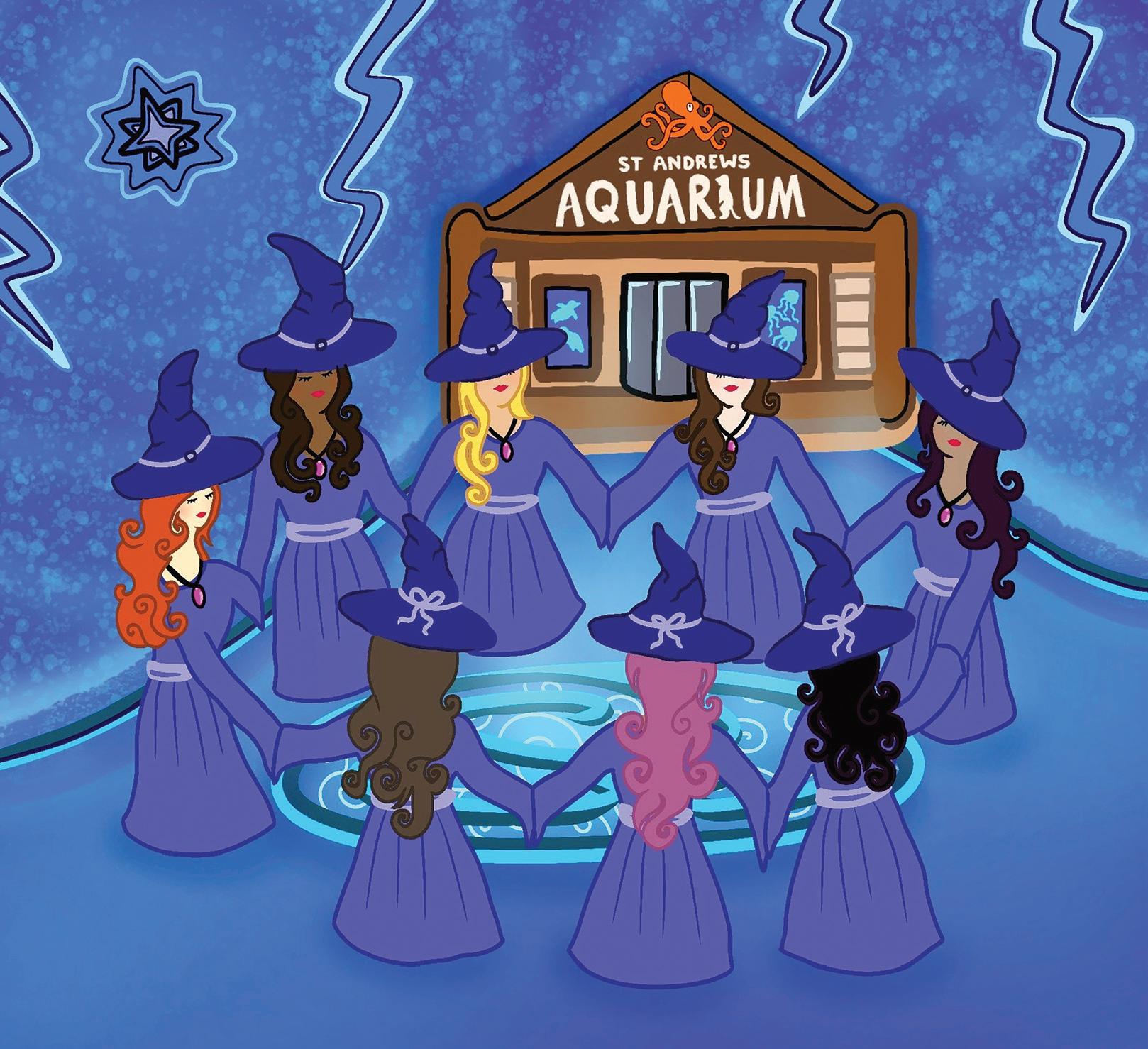
Yet long before Step Rock was a destination for postwar amusement — or even a men’s-only retreat — local legend whispered that the pool possessed a more ominous history, one tied to Reformationera witch trials. Centuries before the skeletal discoveries of the 1980s, the great storm of 1856 ravaged the Fife coastline, causing significant coastal erosion at Step Rock and exposing intact human skeletons within the tide pool. This revelation was the basis for the witchy St Andrean legend.
“The most sexy and interesting answer is, obviously, witches.”
Step Rock sits just down from Witch Hill, the current site of Martyr’s Monument. It was on this very mound that accused women burned at the stake during the Scottish Witch Trials of the sixteenth to eighteenth centuries. Before facing the
to Witch Hill. If they drowned, they were proclaimed innocent — though at the cost of their lives. Thus, the numerous remains uncovered by Step Rock were presumed to be the bodies of said ‘innocent’ murdered witches that encountered this grim end.
But how much truth can be found in this unsettling account?While the legend of witches’ skeletons at Step Rock remains compelling, historical evidence tells a different story. Preservation Trust Archives suggest the story of Step Rock witches is no more than myth. “The most sexy and interesting answer is, obviously, witches,” Douglas Spiers, the Lead Archaeologist for the Fife Council, said. “But it’s also the least likely.” More common than drowning accused witches was the practice of “garrotting” them before burning — or, more accurately, “lightly toasting” them. While Spiers acknowledges that accused witches may be buried in and around St Andrews, he points out that distinguishing them from other burials would be practically
conjecture that the bones at Step Rock belonged to plague victims. St Andrews saw at least six plagues during its witch trials, resulting in the death of hundreds of residents. East Coast port towns affected by the plague had to dispose of plague corpses swiftly to prevent further contamination. St Andrews victims were often buried off-therecord in mass plague pits beneath the cliffs of the Scores, right by Step Rock. The extent of coastal storms, including the storm of 1856, regularly cause rockfalls and erosion at the burial sites, uncovering skeletal remains.
While Spiers favours the plague theory,
“Newspaper reports don’t say what they did with the bones.”
he doesn’t discredit other more far-fetched answers. Few explanations exist for burials outside of consecrated church grounds —
this departure from religious practice would have been highly unusual, if not scandalous, for the time. “It’s not impossible [the bodies] are sixteenth century martyrs,” like Reformation the dissidents Patrick Hamilton (of North Street ‘PH’ fame), Henry Forrest, George Wishart, and Walter Myln — four men honoured by the Martyr’s Monument. Another possibility could involve early modern shipwrecks. They were quite common in St Andrews, and the drowned bodies of strangers were often placed in mass graves along the shore rather than in consecrated churchyards. Some of Step Rock’s skeletons, Spiers said, might belong to those seafarers. Other possibilities might include victims of infanticide or suicide. Is there any definitive way to know the truth? “None of the skeletons have
“Finding dead people in St Andrews is the bane of my life.”
ever been examined,” Spiers notes. “And newspaper reports don’t say what they did with the bones.” Moreover, the coastal landscape has changed significantly over the last 500 years. Coastal erosion, storms, and land reclamation make it difficult to analyse accurately. Carbon dating the skeletons would cost at least £400 — a sum unlikely to be raised in the name of the Step Rock skeletons. “Some of these bones could be from the Bronze Age, and next to them, we could easily have a seventeenth century witch, and then an eighteenth century drowned crew from a shipwreck,” Spiers muses. “There [have been] an awful lot of [bodies] across St Andrews […] finding dead people in St Andrews is the bane of my life; we uncover them every year.” Without a controlled, thorough excavation, no explanation can be provided. Be it witches, plague victims, or adrift seafarers, Step Rock’s tidal pool has potentially borne witness to some of the goriest chapters of St Andrews’ early-modern history. Try not to think about the corpses next time you’re down at Step Rock ordering a Saint Sizzle cheeseburger — it might spoil your appetite.
This article is largely based on social history archives courtesy of the St Andrews Preservation Trust.
Illustration by Isabelle Holloway
“Wahoo, I’ve Got A Sword!” Following The Shire into battle
CIARA WHEELER Features Writer
We ride south at dawn. Hours later, the sun is high, and we step onto the field to a bugle sounding out, the clash of metal, the distant clop of hooves. Tall figures brush past me in surcoats and helmets, barking orders to squires carrying spears and polearms over their shoulders. My guide kneels, and her comrades assist her in pulling on her chainmail.
At this point, you might be wondering if I’ve accidentally pasted the opener to a ‘romantasy’ novel. I wouldn’t blame you — but this is no fiction. This is Big Battle, an annual gathering of some of Scotland’s most avid medieval combat re-enactors. St Andrews’ own Shire of Caer Caledon is in attendance, and I accompany them for the day.
The Shire is a reenactment society that has been around for several decades, in various incarnations. The current society is composed of several ‘guilds’, each specialising in a craft from way, way back when. Bardism, leatherwork, meadmaking — their weekly schedule reads like a biography of a fourteenthcentury peasant.
The Fighters Guild, a section of the society dedicated to training members in periodaccurate combat, is a major focal point for the society. Scotia McDonald, training officer and Shire member since 2010, takes me down to the Military Museum of Scotland where the battle is taking place.
it, horrifyingly!’” McDonald says. “You have to coax people into it. No, you’re fine, you’re not going to hurt anyone, we’ll show you how we do this in a way that’s safe, fun, and creates a good show.”
She gives me the names of the other re-enactment groups in attendance — if you’re thinking ‘The Shire of Caer Caledon’ is dramatic enough, wait till you hear about Regia Angelorum, the Knights of Monymusk, Britannia XIV, and the Company of St Margaret.
On the day of combat, each group shows up early — armed and ready. I felt oddly out of time standing at the side of the battlefield, fiddling with my phone in front of fighters in authentic medieval armour. I had to be assured several times the swords weren’t
with big pointy spears to poke their foes.
According to Chris Coutts, Training Officer and Leader of the Knights of Monymusk, there’s been some big changes in the Scottish re-enactment scene in the last decade. These large-scale collaborative events have only come back into fashion in the last couple of years, as tensions built between groups around the time of the 2014 Scottish independence referendum, where differences of opinion led to fights, ironically, becoming unsafe for combatants.
But Coutts says bringing back events like Big Battle has been invaluable. “We all train on our own with our own groups in our own time, but to work with each other at events like this? It enriches everything.”
He also is a big advocate of students making re-enactment their own: “If you have too many old bastards like us hanging around in charge, it stops being a student thing. We’re here to help, but they remain at the core of things.”
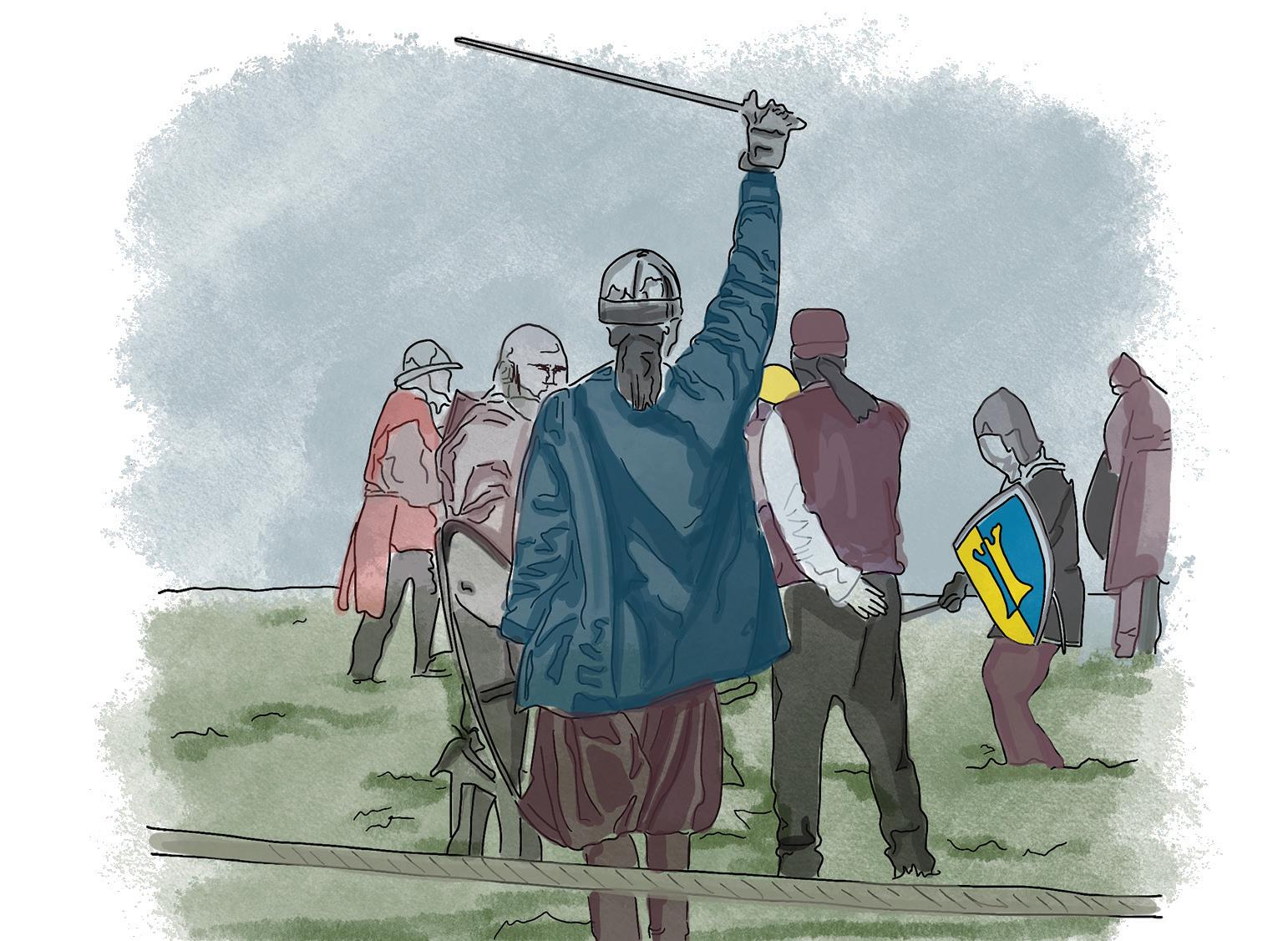
actually capable of lopping a head off.
“Generally, very few people turn up
“Oh, we’re gonna fight now? Okay, we’re doing it, aaaaand now I’m dead.”
and immediately say, ‘Wahoo, I’ve got a sword! I’m going to menace people with
Despite my sniffiness, Secretary Amitabh Bharghavan and long-time member Rosie Cromwell are all smiles as they set up their armour. “The kit’s pretty comfortable. It’s heavy, but it’s fitted,” Bharghavan says. “Chainmail is the heaviest thing in the world to lift, and then you put it on, and it’s fine,” Cromwell adds. She’s held many committee positions during her time in The Shire, and came back to the society after her graduation. “It takes over your life.”
Throughout the day, a lot is going on at any given time: a child dressed as a monk is taught to shoot a bow, groups practice a spear formation but mix up their left and right and end a clattering mess. One especially intriguing game was called ‘Circle of Treachery’, where people in chainmail sneak up on each other
Big Battle is one of the opening events of the re-enactment season, which lasts all summer.
It’s definitely a spectacle: from fast-paced combat drills to practising drills with horse trainers responsible for the equestrian combat sequences of the 2023 Napoleon film. But for most re-enactors, Big Battle is just the warmup, McDonald says.
“People get one good crack to get themselves sorted, to literally scrape the rust out, de-mothball, discover where the holes are in your kit, what’s shrunk, that sort of thing, before the season gets into full swing.”
Could the Middle Ages come to St Andrews? “I could see The Shire hosting Big Battle next year,” McDonald tells me, her excitement apparent. “Us training officers serve at the pleasure of the committee, but I think we could at least lean on them a bit [and] they’ll see it’s a good idea.”
So, why get involved with medieval reenactment as a university student? “It’ll pull you in,” McDonald says. Her summary of the combat experience sums things up quite well.
“Oh, we’re gonna fight now? Okay, we’re doing it, aaaaaand now I’m dead. Gonna lie on the ground for a few minutes, that was fun.”
One Conversation at a Time Isabella Checkley
In Georgia he found himself an honorary member of the KGB. In Kazakhstan he rewired a car to race a train. In Uzbekistan he traded coal to cross the border. In Tajikistan he was tailed by security services on bikes. In Kyrgyzstan he was jailed for having been to Tajikistan. On a train along the Afghan border, he saw the Taliban with their flag driving along in a pickup truck...continued online
Goodbye Overheadrews?
Simon Ezra-Jackson
There is a chance that you, yes you, have dated Overheadrews. I mean that quite literally — it is possible you may have traipsed down South Street together, or shared a scoop of Janetta’s, or clambered up St Rule’s Tower in the dying light. You wouldn’t know: “It’s not something I bring up on the first date,” the Overheadrews admin, who I’ll call Drew, told me, as we sat on a bench by West Sands on a drizzly day...continued online
When ADHD Meds Run Out Mrunmayi Kamerkar
“A lot of people don’t believe that ADHD is a thing, still,” Alison Clink told me. Thirteen years ago, Clink’s son was diagnosed, but she couldn’t find enough information about how to live with the condition. [...] Today, she runs another ADHD support group in St Andrews with Lisa Cathro, founder of Zest Cafe. Thirteen years down the line, Clink and Cathro’s work is especially important — since September 2023, there’s been a national shortage of ADHD medication... continued online
KK’s First Female President Elisabeth Van Meer
Every Monday, the Kate Kennedy Club (KK) follows its decades-old tradition of gathering to plan its events and initiatives. This year, however, one crucial thing has changed. For the first time, a woman presides over these meetings. Emma Andersson is the first female President of the originally men-only KK...continued online
Illustration by Magdalena Yiacoumi
“Deeply Troubling and Misogynistic” The experience of the St Andrean woman
HANNAH SHIBLAQ Deputy editor-in-chief
This article contains references to sexual assault and rape.
“I feel like this is a girl’s town,” one female student told me. In essence, she isn’t wrong — women make up 60 per cent of the University’s student population. Yet, in spite of this, I’ve found that in my conversations with women in town, the 3:2 ratio is hardly representative of St Andrews’ feminist prowess.
To its credit, the University boasts an overwhelming collection of female-run societies. The Student Association website lists four ‘women in’ societies (focussing on female representation in male-dominated fields), Women for Women, and Feminist Society, not to mention those which are not affiliated, like HerCampus, the Lumsden Club, and EmpowHer. Given all these societies, why do so many of the
“I do Art History and French [...] I maybe have two guys in a class of like, twelve.”
women I talked to still feel frustrated?
Representatives from some of these societies noted the lack of male involvement. Ines Tamarin, the President of EmpowHer, said some of her male friends feel uncomfortable “interfering” with the society’s women-centred space. “Not that it is an interference, but they would feel as though it is,” she said. “Just because you’re painting a pot doesn’t mean you’re interfering with women’s lives.’”
societies deter male students. “I don’t know if I’ll ever be able to
join Women for Women,” said the society’s President Victoria OlavesenSabb. “Realistically, [I will not], because we’d have to change our name.” She told me some students ask, if the society aims for cross-gender equality, “Why is it not People for Women instead?”
Rhiannon Peacock, Editor-in-Chief of HerCampus, meets the same queries; she figures most of the other societies do, too: “I feel like [EmpowHer] often get[s] asked, ‘What about Empower Him?”
Most of the representatives attributed this mindset to some of the negative perceptions of their respective societies. Peacock told me she’d “heard some things”. When she tells her friends about HerCampus, they often ask, “Isn’t it really cliquey?”
Jacinta Guelfi, President of the Lumsden Club, had the same experience. “I know people say, ‘Oh, you’re in Lumsden,’” she said, “but [...] I’m so used to it that I barely notice it anymore.” She was well aware that Lumsden’s competitive recruitment process has made for its notable ‘exclusivity’. She pointed out, however, that Kate Kennedy and Carnegie operate similarly. She wondered if they were cut a “bit more slack” because they accept male students: “Maybe [...] having men [...] validates the grouping.”
Olavesen-Sabb was also sceptical of this negativity. Why were female-run societies ‘controversial’ if all they did was “put events on and [raise] money”? “Isn’t that what every society does?” she asked.
Some of them felt that students thought their societies were in competition with one another. They assured me that this was not the case. Many of Women for Women’s committee members belong to the other female-oriented societies in town, OlavesenSabb said. Many of the societies even often collaborate. “If there was a rivalry, it [...] would completely just undo everything that we are trying to do,” said Amy
female-dominated subjects. “I do Art History and French,” she told me, “and, [in] both of those, I maybe have two guys in a class of, like, twelve girls.” She admitted that, because of this, she often forgets the gender divide present in STEM subjects. Computer Science consists of 27.3 per cent women, making it the most male-dominated subject in St Andrews second only to Hebrew. Women in Computer Science’s Social Media Coordinators, Lily Martin and Mia Cousins, assured me that, while the University is supportive of the subject’s female students, they still find some aspects daunting. Cousins is one of two women in a twentyperson group project. She told me she still feels the “need to prove myself to [my male peers]”. Martin shared that, in her group project, even though one male student was reported for degrading comments he had made to his female counterparts, he is “still allowed to lead the project”. I asked why nothing had been done in spite of this. “Because he is good at coding”, she replied. While humanities subjects are more female-dominated, these students still face challenges. One humanities student, who I will refer to as Catherine, told me about how, in the throes of a discussion with her male peers, she felt unable to take part: “Some of the things they were saying, I feel like my more feminine [...] branch of knowledge just didn’t conform to.”
Experiences like these have laid the groundwork for Catherine’s anonymous Instagram account, @monthlycycle.sta, which compiles the submissions of St Andrews students — mostly those of women. These include poems, short stories, and, most noteworthy, the overheard statements of some of the University’s male student body. Some are light-hearted; others are much darker. “When I look at you all I see is a mouth for my d**k,” reads one; “I had a dream where I raped you,” reads another. The shock-factor of this content is Monthly Cycle. The formatted account overheardrews pinned a post in September whose content, it clarified, was “not for any comedic value”.
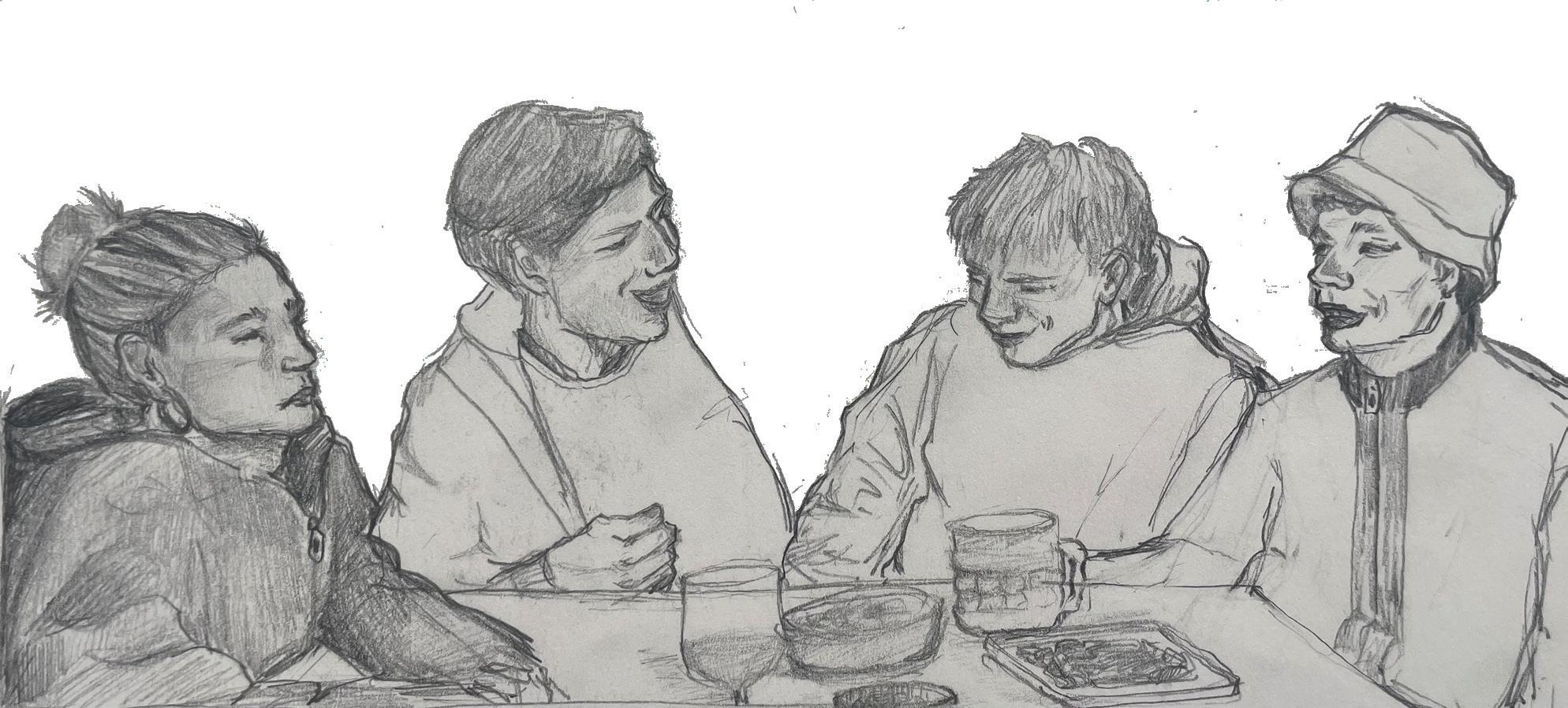
In St
Salvator’s Hall, someone was overheard boasting about a “competition” for “who could sleep with the most impoverished female”. “When you collate things that men have said to the women of this town, [...] you aren’t staring at something that seeks to entertain but rather a deeply, deeply troubling and misogynistic current,” Monthly Cycle wrote to me in an email.
Catherine was aware that male students may not react well to Monthly Cycle, given the inflammatory nature of some of its posts — she didn’t seem to care, though. “Some of them can find it and be offended [...] some of them can find it and maybe it’ll provoke thought, but I am actually so sick of caring about men,” she laughed. I asked both Hyslop and her coPresident Jillian McLeod if they thought St Andrews was a safe place for women. McLeod hesitated; in some ways, she was pleased with the environment in
“I am actually so sick of caring about men.”
town. “I don’t want to use the word grateful,” she began. Hyslop corrected her, “You shouldn’t have to be grateful.”
Dr Rosa Campbell, a lecturer in the School of English, mirrored McLeod’s uncertainty. She noted that the University’s support system was “stretched”: “It’s understaffed, it’s underfunded, and it has its limits.”
Hyslop also described the larger culture in town as one which “can be really hostile”. “I think as much as I feel really safe in St Andrews, [...] there’s a lot of problems,” she told me.
Five years ago, the Kate Kennedy Club found itself immersed in scandal due to a series of allegations submitted anonymously to the Instagram account @ standrewssurvivors, and in December 2024, the University held a meeting to discuss stripping author Neil Gaiman of his honorary doctorate in light of sexual assault allegations — one of which was from a female student.
I wondered how this could change; McLeod said it begins with putting more of the onus on male students. “Men are not simple creatures,” she said. “We’re all highly intelligent and capable human beings.”
I asked Catherine what she wanted to say to the men in this town — even if under a pseudonym. “Just calm down and listen,” she replied. “Let the defensives go for a minute, and just [...] listen.”
Illustration by Vera Kaganskaya

Wild Words

ACROSS
1 Pds. of 60 mins.
4 Analysis that might be done in MT2508
9 Non-verbal UK lang.
12 Informal debts
14 ‘Nor land ________’ (nowhere on Earth)
15 Silly, in Seville*
16 Dad
17 Took 18-across again, for one
18 Exam common in ModLangs
19 Winner
21 Texas landmark you won’t forget
22 Crew member
23 Waiting for a page, maybe
25 Cable box (abbr.)
26 Former Majority leader Tom
28 Winged member of European folklore
31 Bearman’s 2025 teammate
33 Outback runner
34 Flubs
35 British King deposed by Richard III
38 Symbolic objects
40 Insane, in Istanbul*
41 Mens ____ (legal mental state)
43 Common lunch hour
44 St. Andrews submitting system
45 Tailed creature that might be pals with 28-across
47 Won’t bother, in text-speak
50 Berber group Mdou Moctar belongs to
51 American Sara Lee snack
53 “______ of One’s Own” (Virginia Woolfe classic)
56 Without dissent, as a floor vote
58 Actual
59 ________ fool (goofs off)
60 Bitter in Bourdeaux
61 Ancient Roman senator (elder or younger)
62 Reward for bringing flowers, if you’re lucky
63 Johnathan Larson’s musical magnum opus
64 ‘i can’t even’
65 One of a flight
66 Former 8-bit console
Anagrams: Video Games
by Julia Emery
by Alex Le Sage
DOWN
1 Safari creatures
2 Get one’s attention, as a lion might
3 The Philadelphia Eagles have two
4 Singer-songwriter Amos
5 Gaga, in Greece*
6 Ultimate nature
7 “I have no idea”
8 Tit for ____
9 When repeated, island in Polynesia
10 Screw over
11 Lost it, in Lanai*
13 Not spend
15 Roll back, like your head
20 Passion
21 It can be hazy or bitter
24 Graduates
27 Tenor Bocelli

28 Grand Slam event contested in June
29 Limb
30 Snakelike shape
32 Egy. airport code
34 Mr. Blue Sky band
35 Club music abbr.
36 Party 26-across
37 Mad, in Munich*
39 Enlightenment in Hindu tradition
42 Severe disability
45 16-across’s partner, perhaps
46 28-down’s 1999 winner (where he finished off his Golden Slam)
48 Movie hero played by Damon
49 Advantages
50 Lost it , in Lugo*
52 Dr. Zhivago star Sharif
53 Rainbow shapes
54 Batter
55 Promise
57 Former F1 Brazilian Felipe
59 Batteries that may not be included
by Iris Hubbard
EDITOR: ALEX LE SAGE
by Alex Le Sage
Make as many words as possible! Rules: Words must have at least 4 letters and must contain the center letter. Letters can be used multiple times. Scoring: 4 letters words are worth 1 point each. Longer words are worth 1 point per letter. Each puzzle has at least one word which includes all the letters and gives you seven bonus points.
Crossword by Greta Shope
Julia Emery
Illustration by Elizabeth Lang
SELEN TONKUL

EDITOR: ALDEN ARNOLD
Up-Close: St Andrews Masonry
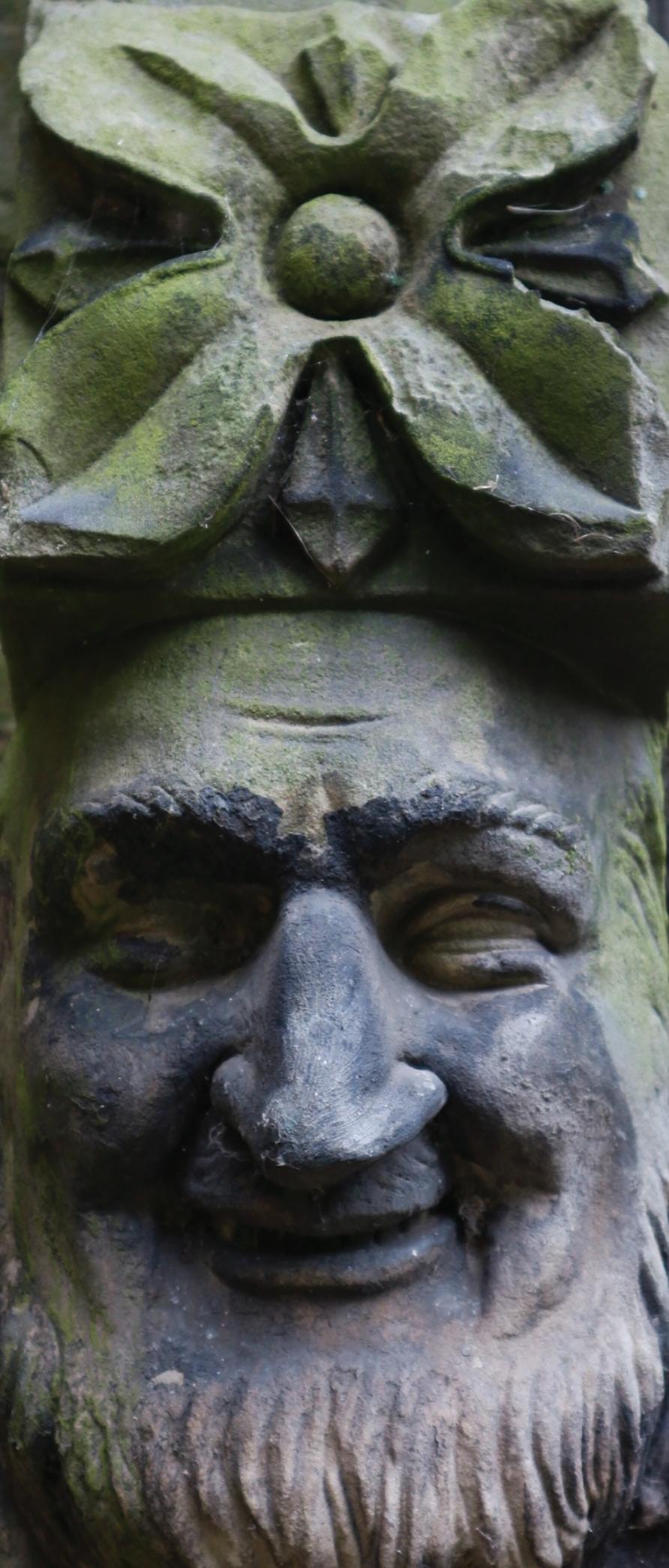

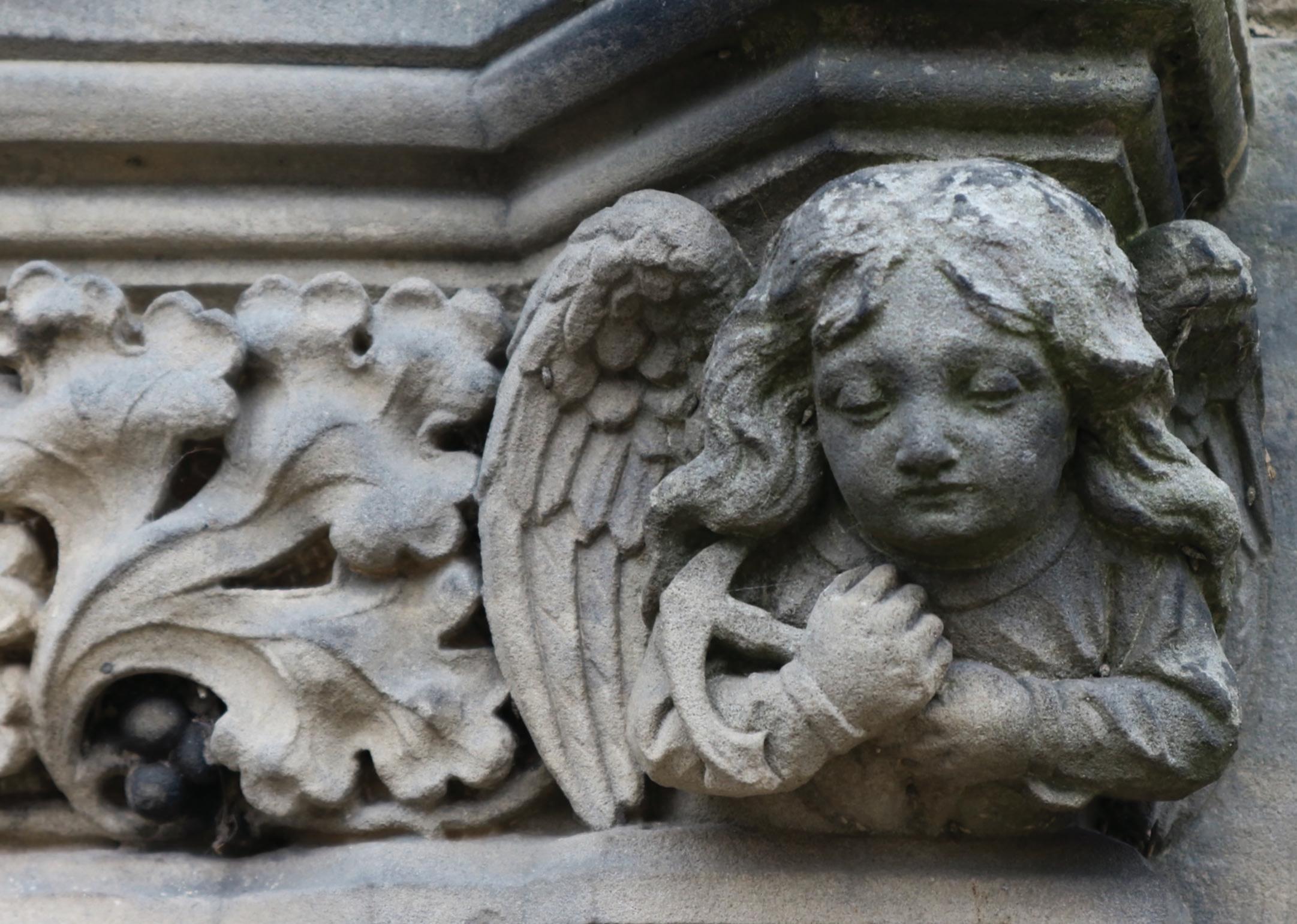

Photographer

Coos and Corvids

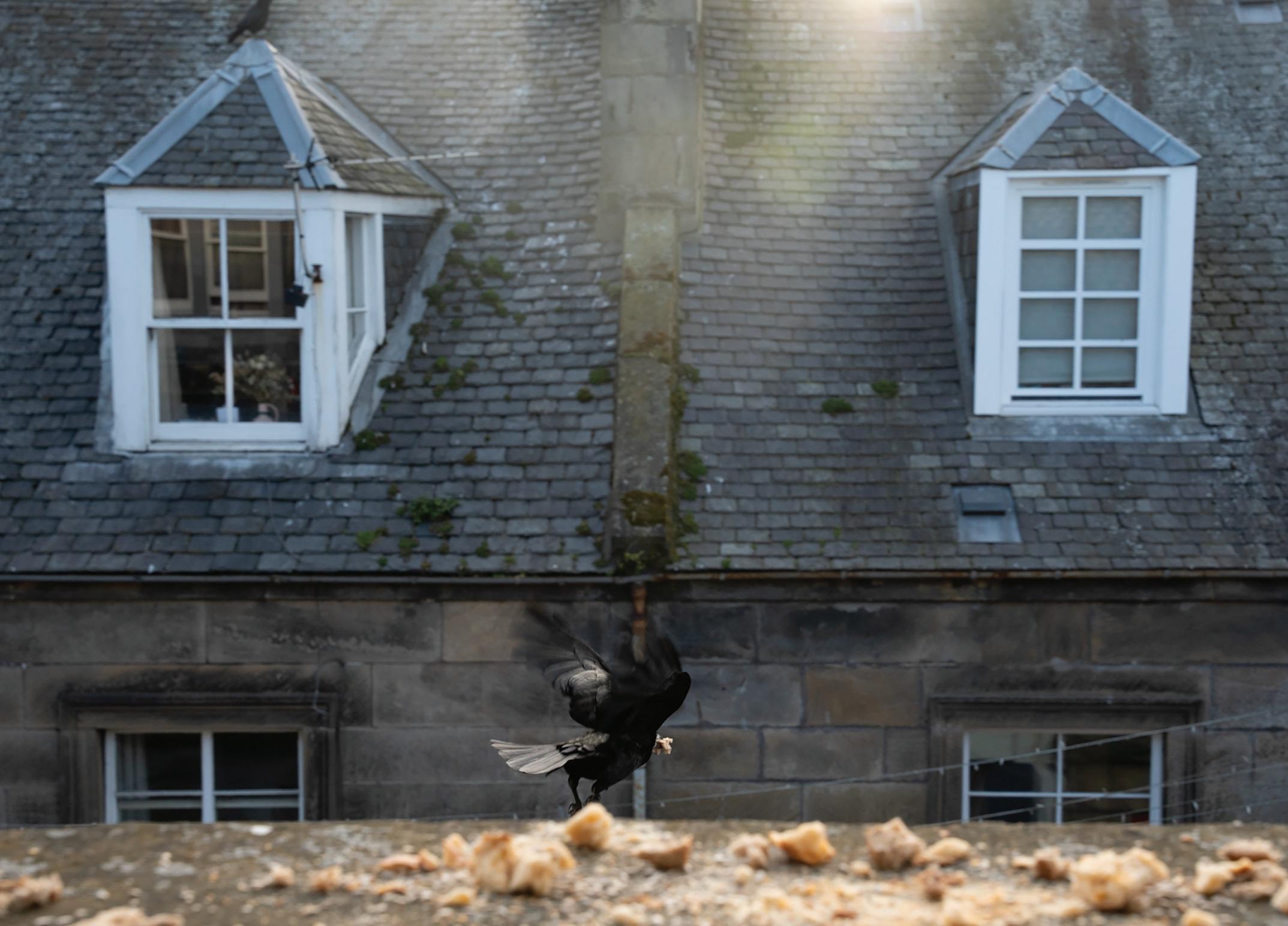

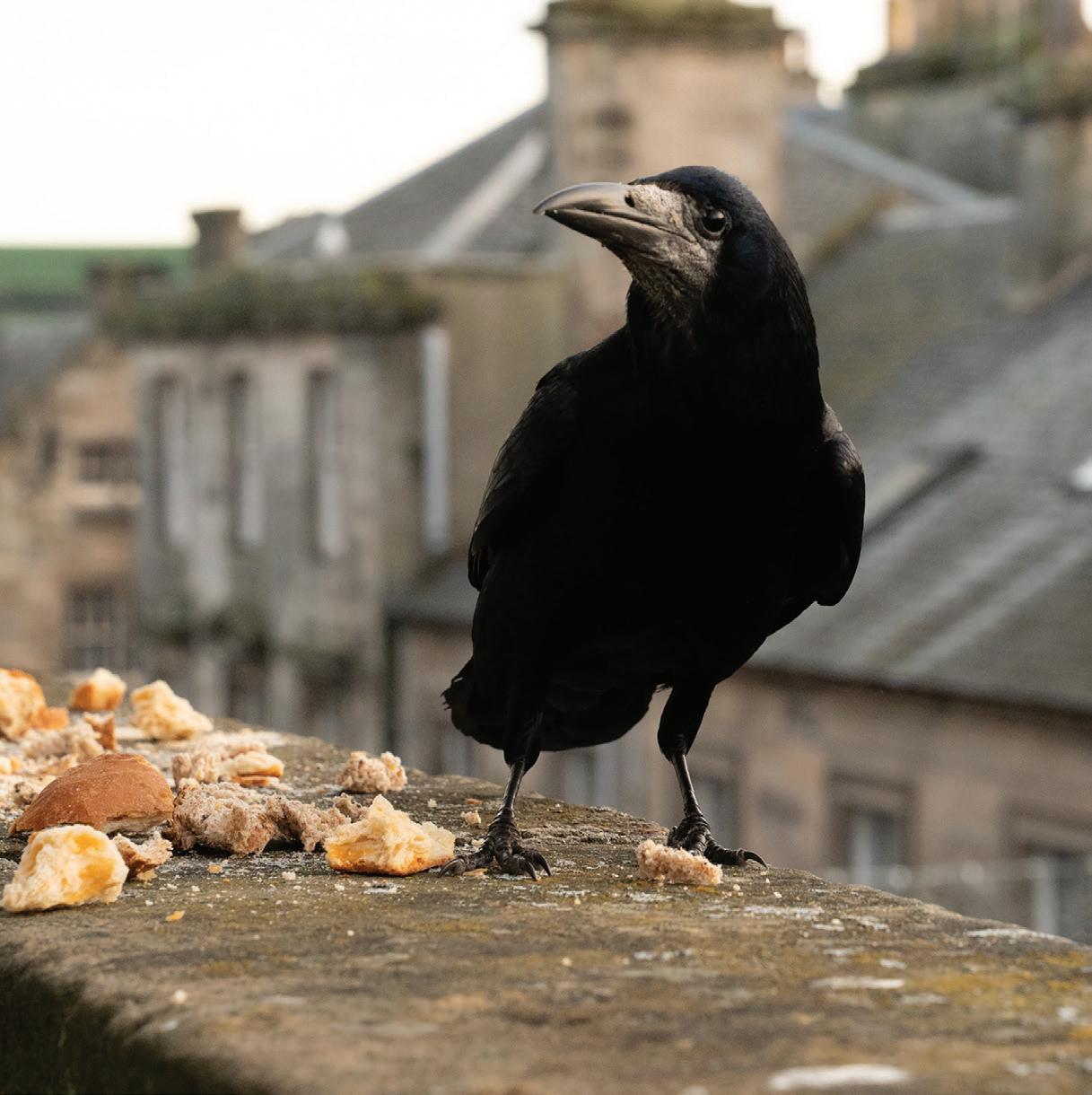
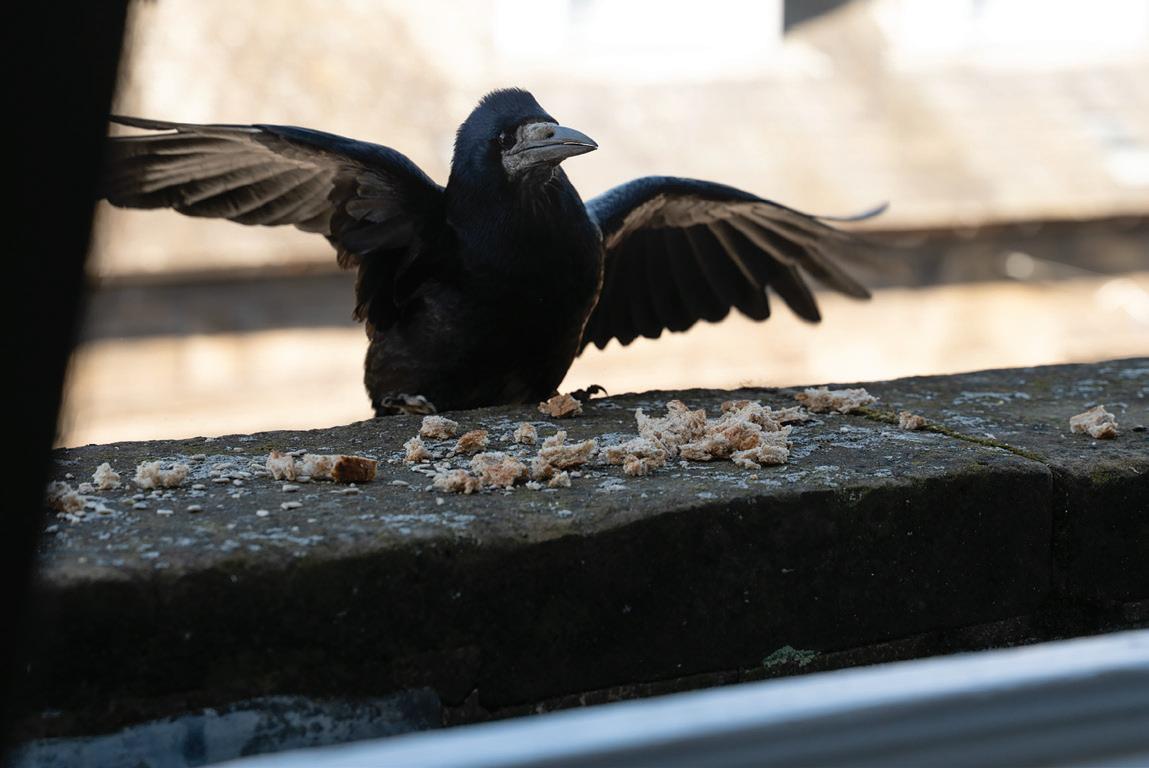

HEATHER WALLACE Photographer
EDITOR: ARNAZ MALLICK
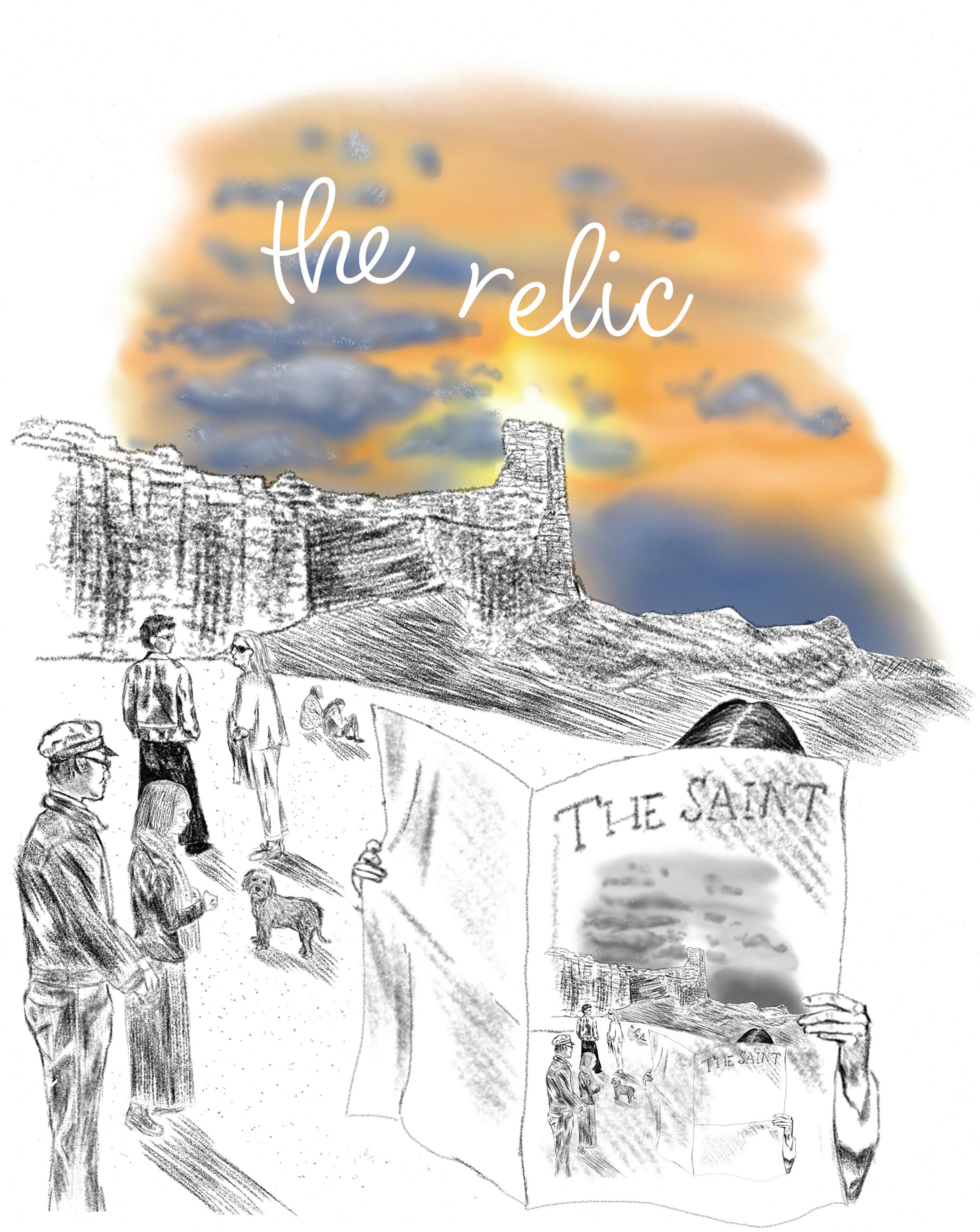
Illustration by Alice O’Sullivan
Springtime with Topping & Co.
Looking for your next read? The Saint and Topping & Co. have come together to save the day. Find below the best springtime stories, all books are available locally in store.
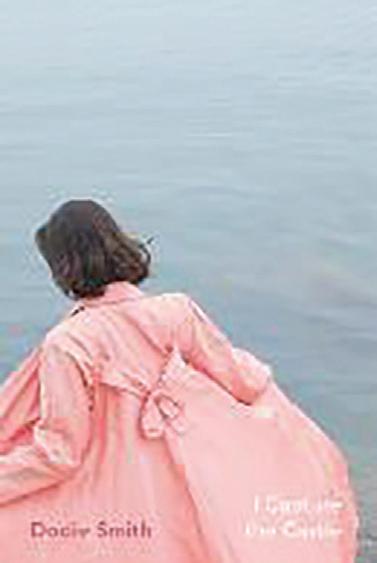

Ruby Recommends I Capture the Castle by Dodie Smith
“I write this sitting in the kitchen sink,” so begins Cassandra, our positively charming, seventeen-year-old narrator, as she looks out on a drizzly March morning from the haven of her crumbling castle home. It is here that she lives with her eccentric family — her feisty sister Rose, her dreamy stepmother Topaz, and her writer’s-blocked father Mortmain. We become her confidants as she weaves her coming-of-age story through journal entries, chronicling a year of great change in her life.
An underrated classic, I Capture the Castle feels like stumbling upon a secret Austen novel. As fresh as the day it was written, Cassandra’s entries are filled with budding love and blossoming maturity, all bobbing down a babbling brook of whimsical asides. Warm and sunny but not without the odd April shower, this little gem makes for a perfect spring read.
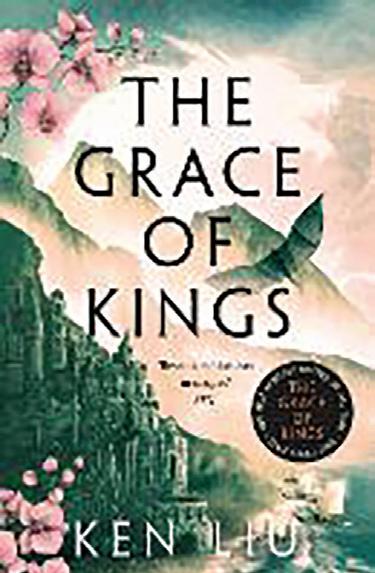
Murray Recommends The Grace of Kings by Ken Liu
Spring is the season of hope, possibility, and renewal. It is the season of change — in fact, many political movements which seek to challenge authority are styled as springs. In The Grace of Kings, Ken Liu merges both definitions. In the archipelago of Dara, the people are unhappy. An unlikely allyship forms between a poor but wily Kuni Garu, and the warriornobleman Mata Zyndu. Together they decide it’s become time for a change of season.
In this ‘silk-punk’ epic, the first in The Dandelion Dynasty, Liu expertly weaves an extended floral metaphor throughout his otherwise intensely political book. Themes of power, rebellion, and the friendships born in-between are woven together like garlands. This character-driven series is perfect for fans of historical fiction or fantasy this spring — or for those of you who seek the hopeful nature of change that defines both springtime and humanity itself.
STAFF PICK
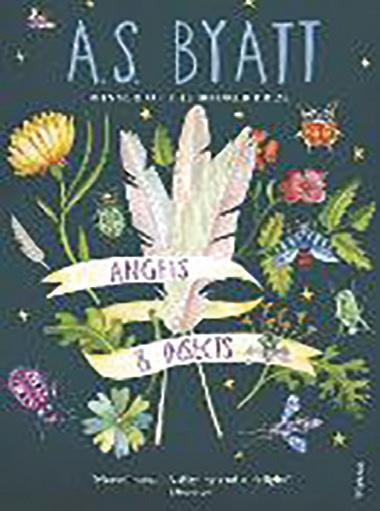
Arnaz Recommends Angels and Insects by A.S. Byatt
Kafka’s (Final) Trial
ALEXIA HEASLEY Relic Writer
The tradition of posthumous publication and ensuing ethical debate on the matter stretches from Virgil to, most recently, Joan Didion. Amongst those at the heart of the discussion is Franz Kafka, whose first posthumous novel was published a century ago in 1925. Kafka had written explicitly to his friend Max Brod prior to his death that he wanted everything “in the way of diaries, manuscripts, letters (my own and others’), sketches and so on, to be burned unread”. Somehow misunderstanding the request, Brod began contacting publishing houses, and within two months had signed an agreement to publish all of Kafka’s unfinished novels. Within three years of his death in 1924, three of Kafka’s major works, The Trial (1925), The Castle (1926), and Amerika (1927) had been published consecutively. These works, though at times fragmentary and incomplete, became fundamental texts in the school of modernist literature. Kafka’s fictional worlds ran on absurd bureaucracy, existentialism, and inexplicable alienation that struck a chord with many readers in their non-fictional lives, establishing him as one of the great literary minds of the twentieth century. The term ‘kafkaesque’ entered the colloquial language, becoming interchangeable with ‘bureaucratic’ or ‘nightmarish’. In this eponymous word alone, Kafka’s lasting impact found itself pervading the modern world of language and literature long after his death. The texts themselves found influence beyond literary schools of thought and started to emerge in philosophical and political studies. Traces of Kafka’s
“I like you, but can’t date you.” Had I grain of sand for every time I heard that, I’d put Castle Sands to shame — where I go to think about the boy who ends up saying those words to me. It’s also where I even tually go to collect sea glass with him. Only this time, he’s not the inspiration behind my curated playlists, nor the leading star in all of my fantasies — he’s just my friend.
work can be found in the existentialist writings of Albert Camus and achieved cult status in Cold War America as more people began to resonate with his images of isolation and oppression under a looming, bureaucratic political system. His exploration of absurdism and the individual struggle for meaning will not be constricted by any one period or place, and thus maintains relevance to readers globally. When his writings, though published without his consent, have had such an expansive and positive impact, it is difficult to accept the ethical dilemmas that accompany them.
According to Roland Barthes’ theory of the ‘Death of the Author’, authorial intentions limit the reception and interpretations of the author’s works and should not be paid attention to, making this dilemma a lot easier to navigate. Though if Barthes were to find out his Mourning Diary had been published nearly two decades after his death, he too might have requested that it be burnt. It is evident that the greatness of a posthumous text cannot be discussed in the same breath as morality. Though, with these works having been published and scrutinised for just under a century now, a modern boycott would be simply, well, absurd. The ironic truth is that the greatest respect we can pay to Kafka now is to read his works and honour the profound contribution they have made to the literary sphere whilst also offering a more cautious approach to the posthumous publications of contemporary authors. If Kafka could have seen into the future, his greatest novel might have been one discussing the absurd ethics of posthumous fame — but perhaps that too would have been a project he abandoned and left to be published later without his consent.
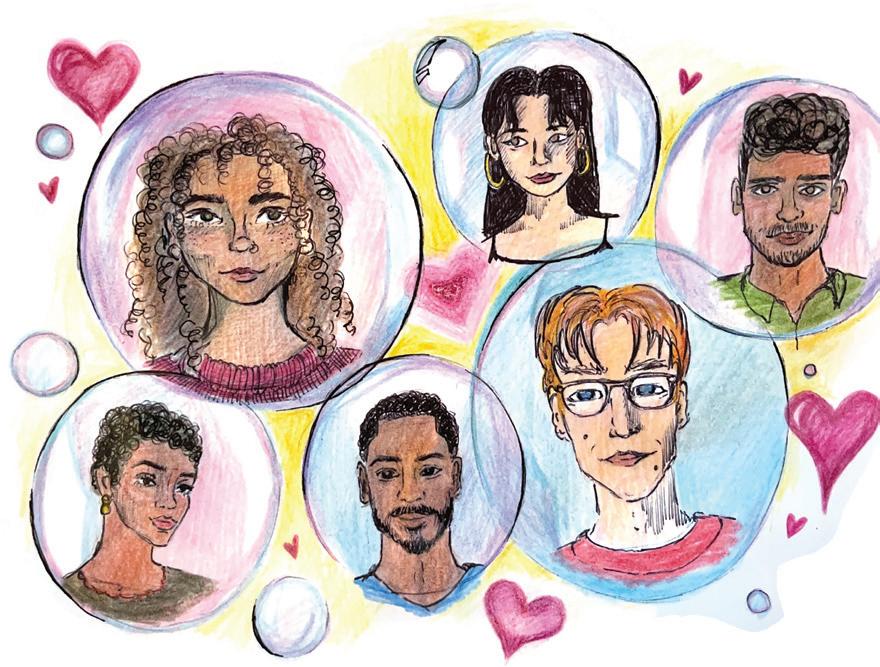
I often find myself faced with this rejection — one that doesn’t even really feel like a rejection. Perhaps “I’m not interested [full stop]” would’ve been kinder; the additive, “I still want to be friends,” is temptation enough for me to brave that emotionally tumultuous terrain. Because, regardless, I felt something for him once — whether because he was handsome, or liked my Letterboxd reviews, or told me that I “made journalism cool” (true story). Crushes require energy, and energy cannot be created or destroyed. I think the same is true when it comes to love: it simply changes form.
Angels and Insects is comprised of two novellas set in the second half of the nineteenth century. The first novella, ‘Morpho Eugenia’, depicts an insectologist returned from being shipwrecked in the Amazon, who marries into a wealthy English family, naming one of his newly discovered butterflies after his wife. Byatt’s writing deals with both the beauty and sublimity of nature in all its forms, but particularly in insects; Byatt, through her characters, describes both the iridescence of butterflies as well as the natures of ants, using these insects to illuminate Victorian reactions to the rise of scientific thought and evolution in the nineteenth century. do you have a survival story? email arts@thesaint.scot to be featured.
I’m now friends with my first-year crush, though it was only upon our running into each other at a party after not speaking for a year that this was realised — a decision made prior to his hand slipping up my shirt and my back hitting the garden wall. The guy I liked last semester holds seats for me in the library now. During study breaks, we laugh at how I once tearfully confessed my feelings and how he kissed me in spite of himself. I’m aware that these experiences are unconventional and even devastating — but what is love if not that? To feel it at all, even if painfully, reminds us that we are a part of something so much bigger than ourselves. Sometimes when I’m at Castle Sands, I imagine a stranger on the other side of the world staring out from their own spot by the sea. Maybe they’re reflecting on what could have been. Maybe, by a stroke of fate, we’ll cross paths someday. Maybe they’re the reason why none of my past romantic pursuits have worked out. Maybe it’s them I’m meant to be with. Or maybe not. I’m sure we’ll be friends either way.
Illustration by Elizabeth Lang
SOREN RASMUSSEN Relic Writer
Our lives are covered in typography. With the near-extinction of handwritten text from modern life, nearly every word we read is a typeface — a particular design handcrafted and often hand carved by humans. But why is text designed the way it is? Why don’t iMessages look like Renaissance manuscripts? And why are we stuck with Arial and Times New Roman? Through some of history’s most influential typefaces, here’s a brief journey through nearly 600 years of typography.
While the story of printed text began in eleventh century China, our Latinate history starts in 1440, when Gutenberg invented the printing press. Seeking to emulate handwritten manuscripts, he created a typeface that closely mimicked contemporary German calligraphy, a style now called Blackletter or Gothic script. You’ll know it if you’ve ever seen The New York Times’ logo or a can of Liquid Death: bold, intricate lettering with sharp, angular lines and dramatic differences in stroke weight. For legibility’s sake, we won’t use the style here.
Given its glaring impracticality, Blackletter’s reign was short lived. Not only difficult to read, the style is laborious to carve and uses excessive amounts of ink and paper, so printmakers turned to a different calligraphic inspiration, Italian Humanist script, and began to forge the Serif style as it’s known today. Serifs (the decorative little strokes at the end of letter lines) lie at the heart of typography’s development. More than mere ornamental flourishes, they can improve the reading experience by guiding the eye from one character to the next, making them the ideal form for long texts like novels or newspapers such as this one. The manipulation (and eventual omission) of these little lines is fundamental to centuries of typeface history.
We’ll begin with Garamond. Created by engraver Claude Garamond around 1550, it is by no means the first serif type, but is among the oldest typeface families still widely
What’s In a Font? A
brief history of the sculpted word
predecessors), and bracketed serifs (meaning slight curves leading into the serif bars). These typefaces, along with successors like Baskerville, still maintain relevance today, and Garamond itself has been used as the typeface of the Harry Potter books and Abercrombie & Fitch logo. The St Andrews logo uses a similar Old Style typeface in Palatino.
Fast forward two centuries and we arrive at Bodoni. Bodoni is classified as a Modern or Didone typeface — a style with far more stroke contrast, a strictly vertical axis, unbracketed serifs, and ball terminals (rounded stroke ends). It became highly popular in the late eighteenth and early nineteenth centuries, and while they’re rarely used for large bodies of text, the style still maintains that popularity today, often associated with elegance. In popular culture, the Bodoni typeface has become immortalised through the iconic capital letters of VOGUE, ZARA, and MAMMA MIA!
This brings us to the bane of every student’s existence:
Times New Roman. The typeface’s story began in 1931, when The Times newspaper commissioned designers Stanley Morison and Victor Lardent to create a new body text for their paper — one that was both robust, compact, and easy to read. The result was just that: a narrow, highly legible type that could fit lots of text into their paper’s columns. The typeface became popular in book printing, eventually leading Microsoft to ultimately make it the default font for Word in 1992 — the last nail in the coffin for students everywhere.
inspired by the Bauhaus movement and now visible in every Wes Anderson movie. These typefaces help legitimize the style, but it wasn’t until 1957 that sans-serif truly took off, when Swiss designer Max Miedinger designed the font you read now: Helvetica. In a time demanding clear, unornamented, modern aesthetics, Helvetica caught the moment. It became the staple font of mid-century advertising everywhere and is still the most popular typeface in the world, seen today through brands like WhatsApp, Jeep, and the New York City subway system. Helvetica’s success is fundamental
further Microsoft programmes and


became iconic in its childish, facetious eccentricity. This has led to frequent controversy over its misuse, from World War II memorials to domestic violence pamphlets to the presentation revealing the discovery of the Higgs Boson particle discovery in 2012. A movement exists to ban the font altogether, with one of its founders declaring that the font is akin to “turning up to a black-tie event in a clown costume”. Nevertheless, Comic Sans is probably not going anywhere either.
“As Comic Sans has shown us, text is, for better or worse, a deeply aesthetic experience. ”
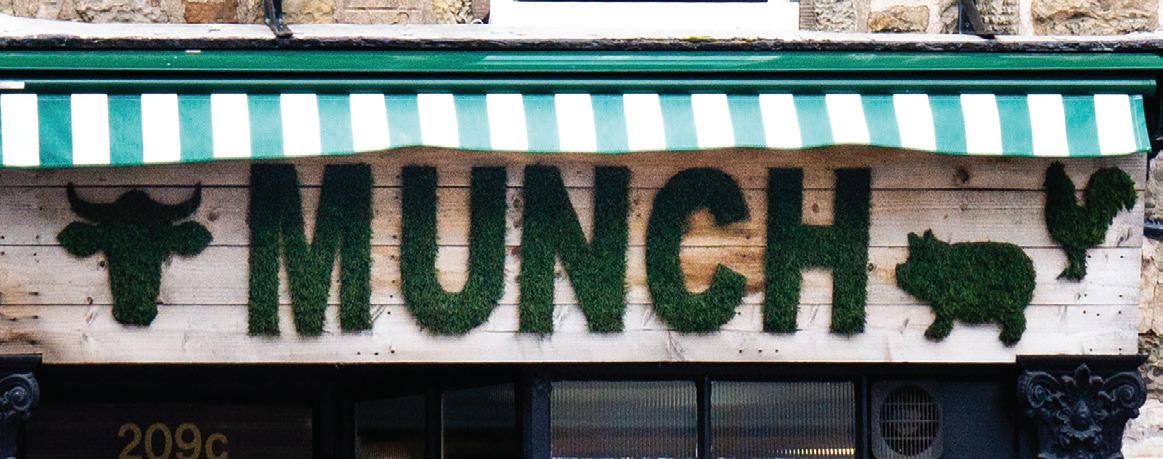
popular today. Garamond is an example of Old Style, characterised by mild contrast between thick and thin strokes, a slight diagonal axis in letters like ‘O’ (though much less than its
Of course, not all fonts have serifs, and most digital text today is sans-serif. Sansserif text has existed as long as the written word, but was shunned by printers for centuries, denounced as ugly, vulgar, and (most importantly) not what the Romans did. But with the widespread change of the early twentieth century, sans-serif slowly grew legitimate. The modernised, industrial world demanded both innovation and simplicity from its text, manifested through typefaces like Johnston Sans in the London Underground and the austerely geometric Futura,
to the widespread adoption of similar sans-serif forms today. The all-toocommon Arial you are reading now was created to mimic Helvetica, one of many subsequent iterations that bring us to our present moment, along with Microsoft Word’s default Aptos and Apple’s own SF Pro spelling out the apps on your home screen. The style has clear practical benefits: its simplicity suits a pixelated screen, and its strong legibility makes it accessible to all audiences. Whether you’re a fan of such ornamental sterility or not, sans-serif is here to stay. But there’s one more typeface we’d be remiss to forget, undoubtedly the most infamous typeface of all time. No doubt you’ve recognised it already. Comic Sans was created in 1994 by Microsoft designer Vincent Connare for Microsoft Bob, a software interface designed for children and new internet users which featured a talking dog guiding the user around. Believing the dog’s speech bubbles shouldn’t be in Times New Roman, Connare reportedly created Comic Sans in 3 days, mimicking handwritten text from graphic novels. The font never made it into the programme and Microsoft Bob was soon discontinued, but Comic Sans couldn’t be killed. It spread through
There are many more stylistic developments and infinitely more typefaces not covered here, of course, and with so much at our current disposal, it’s easy to view the story of typography as complete. But as long as culture moves forward, so too will the sculpted word. As the Klim Type Foundry writes, “The alphabet is not a problem to be solved by a typeface. It is a concept made concrete through countless written and designed letterforms [...] not defined by a single typeface but expressed through all of them.” We don’t know what the fonts of the future will look like, but they won’t merely be what we’ve seen already. You might say this is far too much time dedicated to fonts — that no matter what typeface one uses, the text is always the same. But does every font in this article read the same? As Comic Sans has shown us, text is, for better or worse, a deeply aesthetic experience. While the words themselves may not change across fonts, our reception does. James Cameron learned this much when he used Papyrus in Avatar. Text isn’t just transactional. From aesthetics to cultural history, there’s a lot more going on in between the lines.
Photos by Madeleine Rea
With Romance, Ghosts, and Other Things
Inside Grey Gardens
performed in it. Their tragedy was a theatre.
MARI CLAUDIA REIMER Relic Writer
While watching Jacqueline Kennedy’s iconic White House tour, the first televised glimpse into the private world of American politics, I expected to learn more about how she transformed what she called the “dreary Maison Blanche.” Instead, I found myself tumbling down an entirely different rabbit hole — one that led me to Grey Gardens, the now legendary documentary capturing the strange, decaying world of Jackie’s eccentric relatives, Big Edie and Little Edie. Their crumbling Long Island estate was a world unto itself, with its overgrown landscape, 300 cats, and theatrical one-woman dance performances. As Little Edie herself put it, it was a place “with romance, ghosts, and other things.” Grey Gardens (1975), the cinéma vérité masterpiece by Albert and David Maysles, immortalised the lives of Edith Ewing Bouvier Beale (Big Edie) and her daughter Edith Bouvier Beale (Little Edie), Jackie O’s wildly eccentric aunt and cousin. Once fixtures of New York high society, they were later found living in a collapsing East Hampton estate, trading debutante balls for cat-infested squalor. They didn’t just survive in their decaying kingdom; they
The documentary captures a world that goes back and forth between faded aristocracy and absurdist drama. A Victorian portrait of a youthful, glamorous Big Edie is placed on the wall in the house, a relic of an era when she was a sparkling socialite draped in pearls. The camera lingers just long enough for you to wonder: How does one go from champagne soirées to arguing with a raccoon over dinner scraps? Big Edie, at least, seems unbothered: “The cat’s going to the bathroom right in back of my portrait. I’m glad he is. I’m glad somebody’s doing something they want to do.”
Little Edie, meanwhile, is fashion. Not in the way Jackie Kennedy was — perfectly tailored suits and pillbox hats — she reinvented clothing: skirts worn as capes, sweaters wrapped around her head. “This is the revolutionary costume! I never wear this in East Hampton!” . She was a style icon before the world knew how to handle one like her, inspiring designers like John Galliano and John Bartlett decades later.
But Grey Gardens isn’t just an exercise in glimpsing oddity, it’s a portrait of two women
locked in a codependent relationship. Little Edie, ever dreaming of an escape, watches over her mother with a mix of devotion and resentment: “We better check on mother and the cats. She’s a lot of fun, I hope she doesn’t die. I hate to spend another winter here though. Oh God, another winter.” Big Edie, on the other hand, revels in their shared exile, rewriting their downfall as a grand artistic statement.
Beyond their personal drama, the estate becomes a character in itself, decaying and overgrown. “Oh, Mother thinks it’s artistic this way, like a Frank Lloyd Wright house. Don’t you love the overgrown Louisiana Bayou look?” Little Edie declares, gesturing to a landscape that would send a gardener into cardiac arrest.
exercise in survival, both theatrical and literal. They subsisted on an unusual diet, scraping together meals from whatever was available. Canned food, Wonder Bread sandwiches, and pints of melted ice cream were staples, often eaten with knives. The Beales even applied for food stamps through a friend to avoid public scrutiny. “I dine once a day at 5 p.m., mainly on fruits and vegetables,” Little Edie declares, though the ever-growing raccoon colony feasting on loaves of Wonder Bread in the attic suggested otherwise.
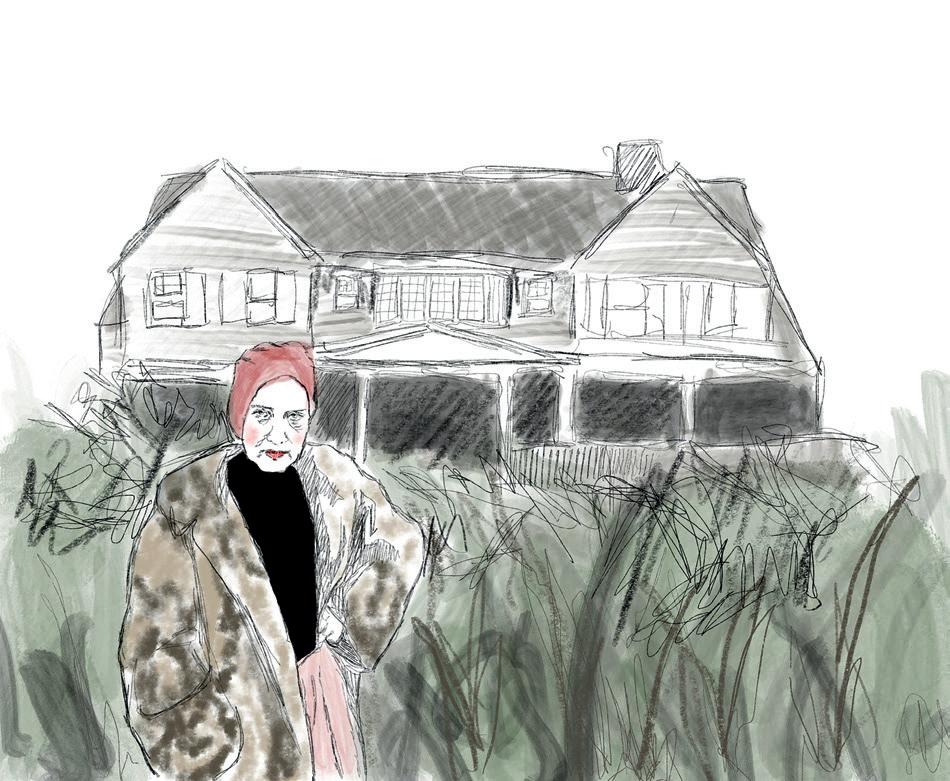
Their existence was an
After Big Edie’s passing in 1977, Little Edie finally left Grey Gardens, selling it in what can only be described as the most dramatic real estate move in history. “After mother died Jackie told me she’d hired all these people to renovate the house, but I didn’t want Jackie and Lee to grab the house, so I sold it quickly for mere pennies.” The estate found new owners in Washington Post Editor Ben Bradlee and his wife, Sally Quinn, who lovingly restored it. Despite its decay, Grey Gardens was never just about a house. It was a stage where life was lived on its own eccentric terms. Little Edie, despite years of hardship, never lost her theatrical spirit: “I had my cake, loved it, masticated it, chewed it and had everything I wanted.”
The Influence of One Author
And how he undermined Amazon’s monopoly on books
ADRIAN HANLON Relic Writer
Having sold over 40 million copies, Brandon Sanderson is one of the bestselling fantasy authors alive. More than that, he is one of the most prolific. Since the publication of Elantris in 2005, he has written 32 novels (among them the epic-fantasy series Mistborn and the Stormlight Archives), as well as a substantial number of shorter works. So, although it may have been suprising, it should not have come as a shock when Sanderson revealed that, throughout the period of 2020-21, he had written five secret novels.
The first he had started writing only for his wife. He would write a few pages, let her read them, and then continue. The last he wrote for his son. That one he did not include in his Kickstarter, but the other four he did, and in one month in 2023 he crowdfunded a record-breaking $42 million to provide fans with the self-published novels and their associated merchandise.
It seems curious that he should selfpublish, given that he already has a publisher. Yet it seems less so when we discover the extent to which publishing companies
are subservient to Amazon. Although one might not picture the multi-trillion-dollar conglomerate as a ‘bookseller’, it is in fact the biggest in the world, controlling 50 per cent of the print book market, 63.4 per cent of the audiobook market, and around 90 per cent of the eBook market. Amazon has a monopoly over books, and as such it can (and has) extorted publishers and authors, and can (and has) leveraged unfair business practices to eliminate competition.
It was at that point that Sanderson told The Guardian, “I realised I don’t work for the fans anymore, I work for Amazon, so I tried to get out from under its thumb.”

One way it does this is by sidelining publishers’ books to depress sales and pressure them into unjust deals. According to The Nation, in a 2014 dispute with Hachette, “Amazon marginalized the publisher on the site for eight months,” leading to an eighteen per cent drop in US sales in the year’s third quarter. In 2010, they did the same to Macmillan, Brandon Sanderson’s publisher, removing their books altogether over a dispute about eBook pricing.
And that’s exactly what he did. Selfpublishing his book through his company, Dragonsteel Entertainment, allowed the author to sell direct-to-customer rather than relying on distribution companies like Amazon. Thus, he deprived them of millions of dollars. A drop in the ocean, yes, but apparently not insignificant, since the author managed to leverage his market power to make Audible, an Amazon subsidiary, alter their royalty scheme in a way more amenable to authors. You see, audiobooks are important to Sanderson as he has a dyslexic son for whom they are the primary mode of consumption. Therefore, when fans asked if the secret novels would be made available as such, he was amenable: the books would be available on Spotify and Speechify — but not on Audible. “[T]hey treat authors very poorly,” he blogged.
“Particularly indie authors. The deal Audible demands of them is unconscionable.”
Indeed it is; for Audible takes a whopping 60 per cent of royalties from audiobooks — and that’s only if the author agrees to exclusivity with the platform. If they don’t, they take 75 per cent. Thanks to Sanderson, however, this has now changed; and although the details of the new royalty scheme are vague, and the author himself writes that “there is still work to do,” the deal was sufficient to make him put his secret novels on the platform.
Yet we must remind ourselves that Amazon did not do this out of kindness; they did it because Brandon Sanderson is one of the bestselling fantasy authors in the world, and his boycotting of their platform potentially cost them tens of millions of dollars. They are not a kind company — but they are not all-powerful, either. And what Sanderson’s achievement demonstrates is how successful artists of all kinds can leverage their influence to negotiate better deals for their newer and less successful compatriots. It took one author to make Amazon yield. Imagine if others did the same.
Image from Wikimedia Commons
Illustration by Holly Ward
SAMUEL THAYRE Relic Writer
Colour: The Language of Crisps
Cheese and Onion: Blue or Green?
Take a quick meander through any supermarket or corner shop, and you’re bound to encounter the crisp aisle. Rows upon rows of packets all compete for the shopper’s attention, and nothing is as effective at grabbing attention than colour. The crisp aisle is perhaps more aptly described as a polychromatic utopia for the junk food aficionado — from scarlet to maroon, aqua to ultramarine, emerald to dark green, you can find almost any colour of crisp packet. Of course, the same is arguably true for any commercialised food; the chocolate and sweet aisle is equally as varicoloured. Yet, when it comes to crisps, colour is especially important, and even disputed — the polychromatic utopia is no stranger to the battles of public opinion. In 2016, a YouGov survey found that 44 per cent of people associated the cheese and onion flavour with a green packet. Yet, curiously, Walkers, the leading UK crisp brand, uses blue, though only 30 per cent agreed with such a colouration. The exact reasoning behind this has already been covered by Chris Spargo in a humorous
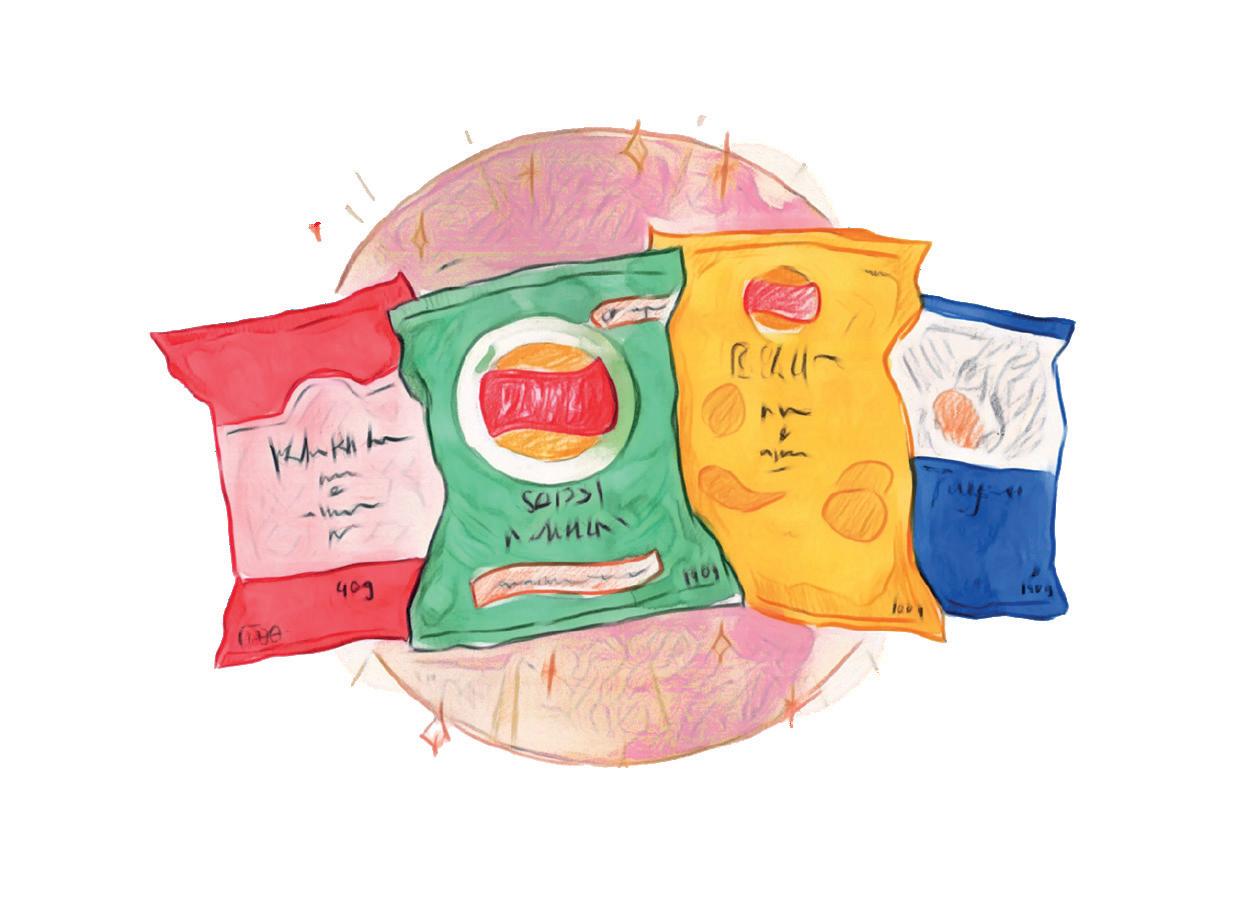
YouTube video that I highly recommend. In short, before Walkers dominated the crisp market, Golden Wonder was the prime choice for anyone craving crisps. However, through industrial strikes, factory fires, and increasing competition, the latter gradually faded in popularity. They did not fade into partial obscurity without leaving their mark, however, for they used green packets to signify cheese and onion, and blue for salt and vinegar. Thus, these two colour associations have been ingrained into British consumer consciousness, leading to many (falsely) claiming that Walkers switched their own colours around.
One can see why many associate green with cheese and onion rather than salt and vinegar. Green is much more of an earthy, agricultural colour that one would associate
with the humble onion. Blue, on the other hand, is evocative of the sea, and therefore sea salt. Even so, there’s a certain sense of sourness that green evokes, perhaps linked somehow to our associations of envy with the colour, or else simply due to the taste of limes. Though people online may continue to insist that Walkers changed their packaging, there doesn’t seem to be much reason for why they’d do this. It appears much more likely that Walkers is simply banking on these alternative associations of green, or perhaps they used the colour to distinguish themselves from Golden Wonder. But what about other colours? Red is almost universally representative of ready salted. As a basic primary colour, it seems fitting to apply to the most basic flavour. Furthermore, red proves to be an intensive colour, grabbing attention. Red is so intensive, in fact, that it has subsumed vast swathes of the food industry, as seen with Coca-Cola, McDonalds, and KFC. The crisp aisle gives
no respite from the tsunami of red that cascades across our food advertisement. Sometimes, colours simply match their respective flavours. Prawn flavours, for instance, are marked by pink packets. Yellow often (but not always) reflects cheese. Does this even matter? Charles Spence, experimental psychologist at the University of Oxford, has done much work on how colours influence our tastes. He has stated that “subjects will taste the colour of the crisp packet, not the crisp itself”. The vivid pinkness of prawn cocktail packets, for instance, enhances our experience of flavour. Additionally, the fierceness with comsumers debate which flavour should be which colour is a testament to how our culture can enthral us. Things as simple as packet colours can be powerful psychological enchantments, much more influential than the packet’s writing. The mere crisp packet has forged an alternative history in the minds of many, contrary to the apparent truth. The mere crisp packet has changed how we perceive and taste. The mere crisp packet bends us to its will.
Illustration by Sandra Palazuelos Garcia
The Odd Woman and the City: New York as a Woman
EMMA INGRAM-JOHNSON Relic Writer
Vivian Gornick’s The Odd Woman and the City tells a tale of New York City through its people. It is witty, disjointed, and personable. One hardly knows which aspect of the memoir is the most entrancing: her earthy description of the sought after city, the autobiography she inadvertently reveals through this dissection of her home, or the omnipresent friendships that litter her cityscape. More than this, she and New York become one — inseparable and symbiotic. As much as Gornick needed to keep retracing the avenues of Brooklyn, Queens, the Bronx, and the Upper East and West sides to feel connected to herself, the city needed her to keep its ‘sidewalks’ paved, its construction men hammering, and its skyscrapers towering, casting shadows over her slowly advancing form on the street below. We tend to think of the places in which people grow up as integral to themselves and their development, yet rarely consider the fact that communities that ‘create’ us and our cultures are equally constructed products of
human thought. Gornick’s assessment of her city can explain the frequent personification of places in literature and the wider cultural canon as female, or even as actualised women. The cities we live in are not just mazes of concrete, glass, and wood, nor are they simply the culmination of millions of minute, chance interactions between myriads of citizens. They are nurturers. In Western culture, this, of course, means they are typified as women — mostly as mothers. Gornick’s relationship with the city is dictated by her gender. With no children or partner as she approaches her nineties, Gornick’s love is reserved for feminist literature and the people of New York, and the city cradles her right back in its maternal bosom. Gornick’s choice of title lends itself to reading her relationship with New York as a partnership. Vivian Gornick and New York go hand in hand. Instead of intentionally invoking herself in the title, however, she
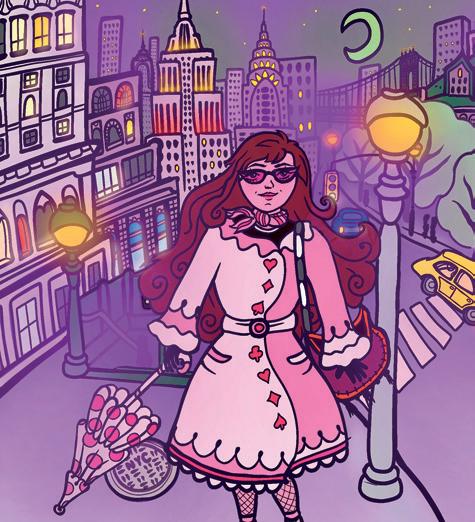
references a whole category of women who all individually feel they are represented and ‘found’ in a city large and chaotic enough to enforce anonymity on one’s own doorstep. Gornick’s status as an ‘odd woman’ is a reference to George Gissing’s 1893 The Odd Women, which dealt with the one million ‘surplus’ of women in Victorian England compared to the male population who were ‘left out’ of society due to their statuses as ‘unmarried’. The women in the novel, through matrilineal structures, teach other middle class women and girls secretarial skills. The marriage market, however, takes all of the younger women in its firm grasp by the last pages of the novel, and Gissing ultimately conforms to the plot-muddling and capricity frequently seen in the presentation of Victorian women.
Gornick alludes to Gissing incessantly throughout her memoir, rejecting the Victorian sentiments behind the title of ‘odd’ and instead absorbing this exclusive identity as inherently female and thus powerful. Even as she aligns herself with its
margins, Gornick feels herself to be, and through her writing, is central to the city of New York. Gornick’s position as the ‘odd’ woman out of New York married life, although no longer considered abnormal, mirrors the position the city takes on in the cultural zeitgeist. For those who live in the city, it is the people who truly form it; bodegas, street names, and subway lines are all important, yet form its backdrop rather than play a key role in New York’s culture. Gornick’s conversations across different neighbourhoods demonstrate this strikingly — there is a lack of cohesion amongst New Yorkers, and thus, the city fades into the background. For tourists like me, the shining lights and screeching yellow taxis obscure what might be considered the reality of the city in an all-consuming haze. Essentially, New York is lost to our imaginations and self-perceptions. It is this similarity between Gornick and New York which allow them both to bear their feminine titles: to be shunned while performing essential civilisation-sustaining work is a cornerstone of the female experience.
Illustration by Isabelle Holloway

ALEX BARNARD Relic Writer
I am a firm believer that not much in life can beat a sunny German beer garden. A day spent with a close friend in Munich last year saw us demolishing comically large beers and pretzels to the sound of a brass band and amid hundreds of other happy punters. For this reason, the prospect of bringing this back to Scotland seemed a weird and wonderful fantasy come true in the form of the St Andrews Oktoberfest.
The yearly event has become a staple of the St Andrews events calendar, not to mention a highly competitive one — tickets are obtained via a complicated system of table ballots, not only with St Andrews students but internationals too. Yes, people fly in for this. However, in the grand roster of events at this University, Oktoberfest is one that anyone with the moolah to travel to this, otherwise irrelevant, small Scottish town should attend.
Part of the reason that Oktoberfest is so well-loved is perhaps its authenticity. As a result of a committee filled with Germans and Austrians, elements like Paulaner beer imported directly from Germany and even a band, Wolfsegger, brought over, mean it’s not a fetishisation of German culture but as close to the real thing as possible. Even the night before Oktoberfest itself, numerous German voices could be heard across the three streets.
In advance of the event, I was invited to the TCCL Lodge, a charity which Oktoberfest has supported since 2011. The Lodge provides holidays in St Andrews free of charge to families with children diagnosed with cancer or leukaemia. There we were met by John Walker, the TCCL Treasurer, who explained the mission of the charity and the role Oktoberfest plays within it. A member of five charity committees and with forty years experience with the Cadets, Walker has dedicated his retirement to helping local communities.
In an unassuming but very well kept house close to Canongate, TCCL have created a holiday home for children with cancer and their families to enjoy St Andrews, totally free of charge. The Lodge is located under an hour from Ninewells, should anything happen while guests are visiting, and sleeps up to eight people. Walker noted that a large
EDITOR: OLGA ALONSO BLANCO
Prost to German Culture
Oktoberfest in Review
number of single parents also come with their children, and the Lodge can provide a wellneeded break. Children can enjoy a climbing frame, gaming consoles, and a large garden within the house itself, but the charity is also aided by the generosity of local businesses. Ranging from Jannetta’s to the Aquarium to the Botanic Gardens and more, free passes are available for almost any activity within St Andrews. It’s not just the Lodge which Walker and the team are responsible for — they also finance important items from computers for children with learning disabilities to hospital stethoscopes shaped like orangutans. Essentially, the charity provides families with the opportunity to enjoy all that St Andrews has to offer, only required to pay the cost of travel, but with the security of a hospital nearby.
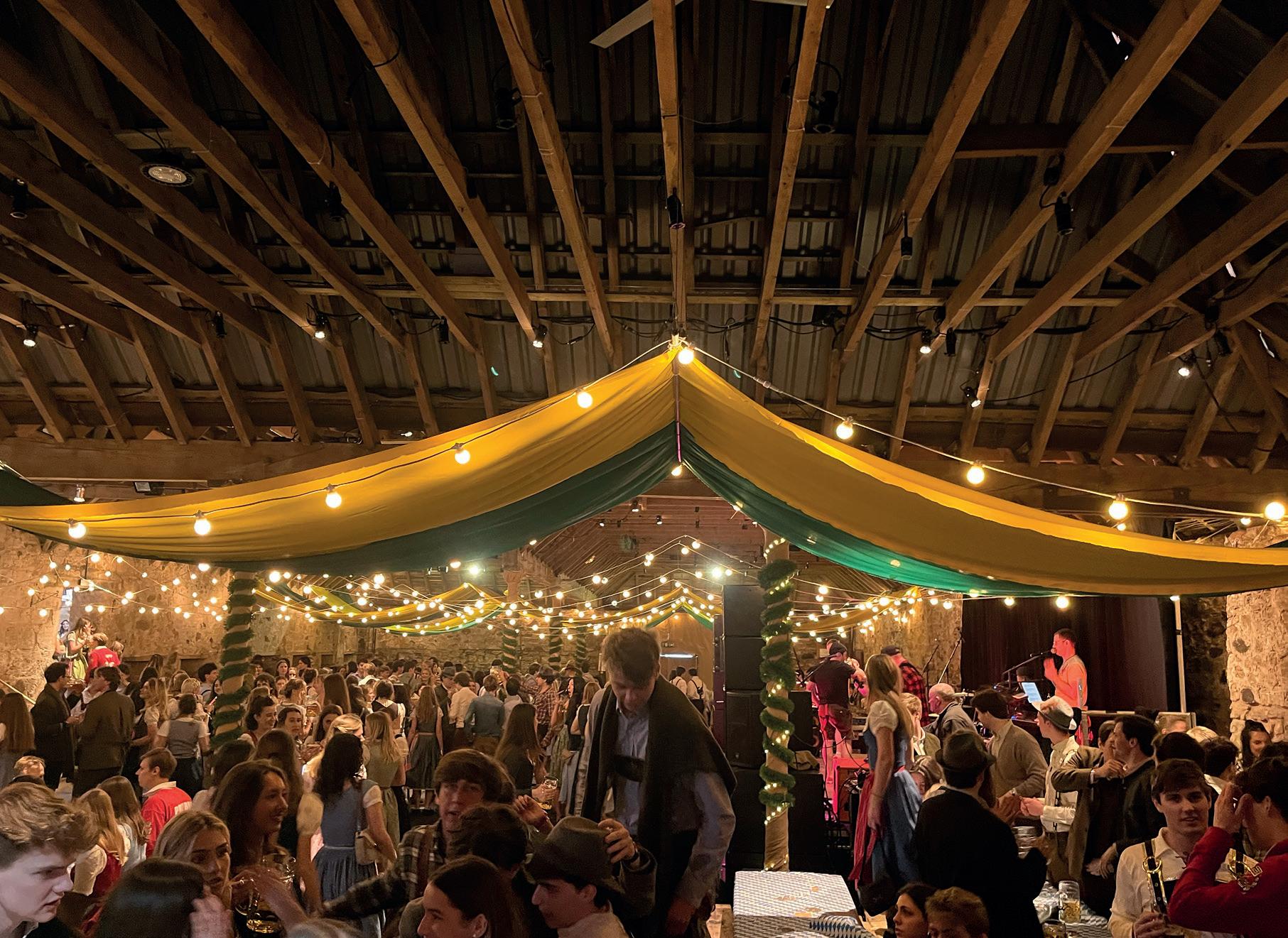
A month after the visit, I found myself a world away amidst the revelry of Kinkell Byre, ready to take on Oktoberfest. A St Andrews staple, it had been elaborately transformed to resemble a German beer hall: think long tables, endless rows of lights and ribbons, and beer stations galore. I was like a kid in Disneyland marvelling at every Epcot novelty. On stage, band Wolfsegger entertained for much of the day, encouraging attendees to raise their glasses and sing along in tentative German. Enthralled by the entertainment, endless dirndl-clad attendees swarmed the dance floor, such that it was difficult to move. I’m sure I’m not the only one who thinks guys should rock Lederhosen more often. The women’s various dirndls were also a spectacle in diverse colours and patterns. You can’t help but suspect
Amazon must make an absolute fortune selling these cheapo versions. Unusually, virtually everyone adhered to the dress code, creating the illusion that one really was someplace in Southern Germany. The caveat to this was that amidst a sea of Bavarian clones all wearing the same, friends were indistinguishable and thus impossible to find. Although there were a variety of drinks on sale, one reigned supreme: the mighty — and dangerous — Paulaner Stein. For the Germanically uninformed, this is a tankard of beer equivalent to two pints, so heavy that it’s almost impossible to lift; I had to resort to cradling mine like a baby. German beer is also stronger than beer here — remember England fans being warned this at the 2024 Euros? For a town where strong beers like Chouffe are only served by the half pint, it’s a wonder that this was permitted, but perhaps it forms much of the event’s appeal. Not only this, but a Stein was also cheaper than many St Andrews pints, sitting at only £6. You can imagine the results of this combination of cost- and intoxication-effectiveness, namely scrapping on the dancefloor including guests squaring up to security, some pretty
passionate making out, and You’ve Been Framed-worthy falling and staggering. Other excitements included a tower ride that dropped participants from a height, which had a pretty hefty queue to boot, as well as a variety of food trucks from the inevitable Saints Sizzle to more traditional German fare in the form of bratwurst. This was also next to the smoking area, which on account of my extremely flammable tacky lederhosen, generated some heart palpitations. Yes, the endless Steins did cause a certain level of chaos, and the swarm of guests could at times be a little overwhelming. However, Oktoberfest excelled in being so meticulously stylised, not cutting any corners on authenticity from music to beer and beyond. Plus, it’s all in support of a fantastic local charity, which you can imagine deservedly receives a pretty substantial wad of money each year from the event. If you can solve the mysterious puzzle of obtaining a table, it’s certainly worth attending — but good luck remembering any of it the next morning.
Photos by Olga Alonso Blanco
ADDIE NELSON Events Writer
Sprezzatura, the Italian concept coined by Baldassare Castiglione, embodies effortless elegance and grace. This year, VS infused this ethos into every facet of their show — from choreography and attire to lighting and music — delivering a performance that epitomised their commitment to refined artistry.
As the lights dimmed, the room hushed in anticipation. Two large screens flickered to life, unveiling a heartfelt video featuring interviews with VS committee members and models. Led by Creative Director Ines Tramarin, the film explored their personal journeys, with questions such as, “What does being part of VS mean to you?” and invitations to share their favourite memories. Their reflections painted a picture of more than just a fashion show — their collective experiences with VS reflected confidence, connection, and belonging, aligning seamlessly with the evening’s theme of effortless elegance and authenticity.
“That Sounded Really Bratty!” VS: Sprezzatura in Motion
As the video ended and the screens faded to black, a hush fell over the audience, shattered by a striking opening moment. A group of male models took centre stage, executing a daring lift as they effortlessly hoisted a female model into the air. She moved with fluid grace, her arms swirling in hypnotic motions, embodying
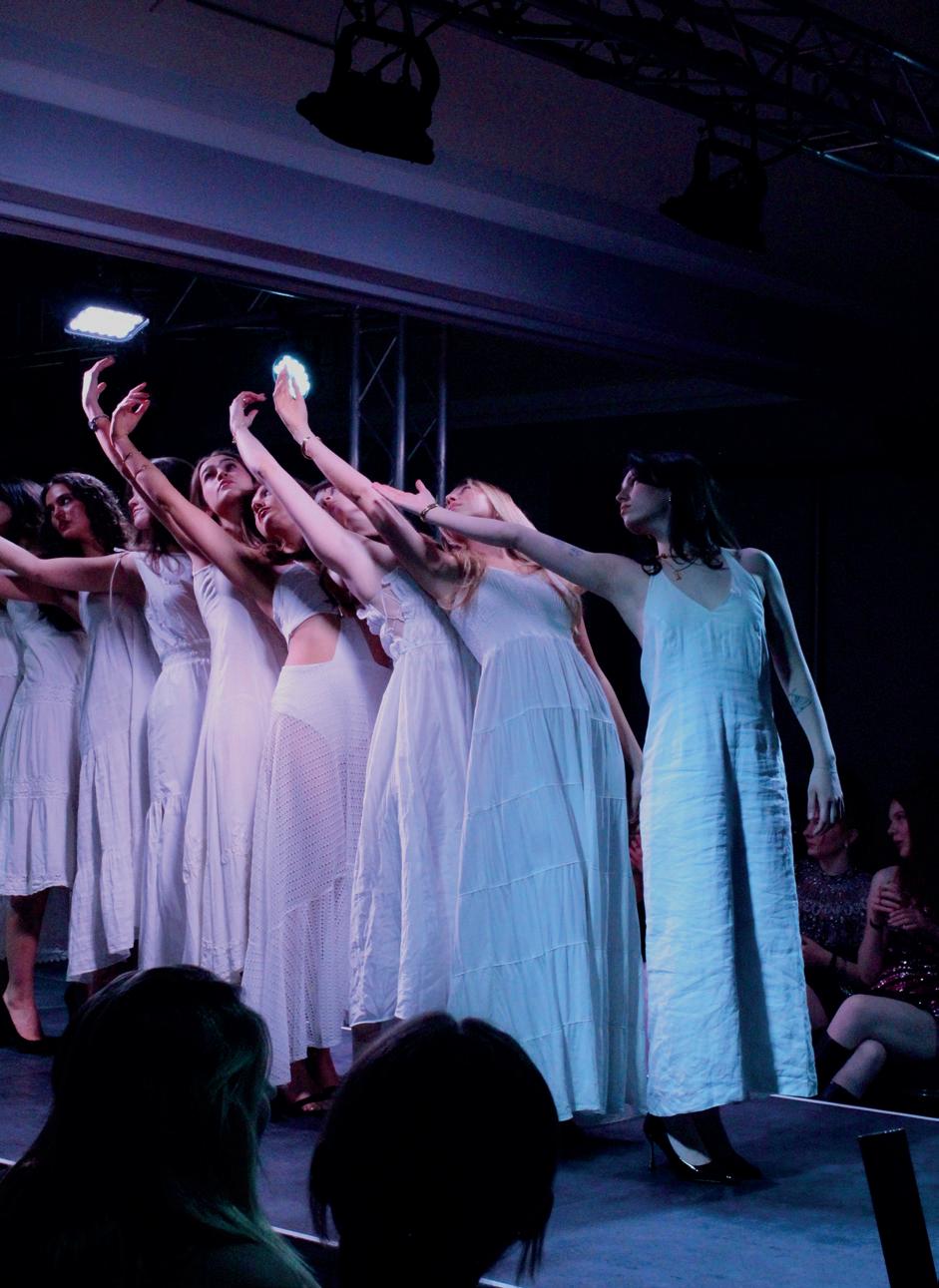
the essence of sprezzatura. Tramarin, who choreographed the opening and closing sequences, wanted this dreamlike moment to set the tone for the show — an enchanting blend of strength and elegance that captivated the audience from the start.
The show then unfolded in a dynamic interplay of lights and music, seamlessly weaving between moods and styles. A breathtaking sequence saw female models gliding across the stage in flowing white gowns to the haunting strains of ‘Young and Beautiful’ by Lana Del Rey. From there, the energy built, transitioning into sharper, more electrifying moments, such as the bold edge of ‘Alejandro’ by Lady Gaga. The show balanced these contrasts beautifully, moving between ethereal romance and striking intensity, keeping the audience engaged throughout.
The seamless integration of behind-thescenes interviews added another layer of authenticity, offering the audience another layer of connection to the show. India Kolb’s choreography deserves particular praise for designing sequences that challenged the models while maintaining an air of sprezzatura. The lifts, though intricate and demanding, never felt clunky or overworked, instead radiating elegance and fluidity while blending strength and grace.
Unlike other St Andrews student fashion shows, this production incorporated a video series interwoven between model and committee interviews
and the show itself. This approach added an interactive element, allowing the audience to experience behind-the-scenes moments and connect with the students on a more personal level. A striking video interlude featured models in a choreographed music video showcasing fashion from the show. This multi-layered presentation enhanced the event’s energy and depth, making for a truly immersive experience.
While the first half of the show had an ethereal, whimsical quality — featuring flowing white dresses and ball gowns — the second half took on a more vibrant, high-energy feel. Streetwear pieces took centre stage, accompanied by upbeat music that electrified the space. One particularly impressive moment featured another lift sequence where multiple male models hoisted their female counterparts, creating a breathtaking visual display. In another playful touch, models swapped denim jackets midrunway, draping them over their partner’s shoulders to show the piece’s versatility.
The momentum of the second half built anticipation for the grand finale. As the opening notes of Coldplay’s ‘A Sky Full of Stars’ filled the venue, models, and executive committee members burst onto the stage, radiating pure joy. The energy peaked as confetti cannons erupted, showering the space in a dazzling cascade of colour and celebration. It was a spectacular conclusion to an unforgettable night.
JONATHAN STOCK Events Writer
It’s almost been a year since Charlie XCX’s hit album Brat first graced our ears. What did the album mean? Did Brat summer actually happen? I ask myself these profound questions as I drunkenly line up for Brat Bop outside the Union, suited for the occasion in a lime green light. I realise that I am wearing a trench coat, perhaps not the brattiest of choices, and search frantically for my ID. I ready myself — ‘Back to Back’ is already playing inside.
Brat shone a spotlight on an uninhibited and more carefree way of life, of consumption. The album challenged how we think of our appearances and relationships with others. Shall this album be remembered or swept under the carpet of the pop hall of fame? One thing is for sure, St Andrews students like bumpin’ that, and by that I mean the dance floor.
“We’re really excited for kink bop,” an anonymous attendee as they made
their way towards the music. I wonder if the night shall live up to these great, even if a little misguided, expectations and wish I had brought my gimp-suit.
As with any St Andrews bop, success is decided by three principal factors: quality of music, level of inebriation, and the frequency of interaction with one’s opps. The first doesn’t always need to be high, as long as the second is off the scale. The third can throw you off even when the bass of ‘365’ isn’t causing a minor earthquake. Naturally, a balance of all three can make for a truly memorable night, those vignettes of the ideal uni life so often forgotten in the throes of a hangover the next morning.
601 is a curious environment to say the least. I imagine David Attenborough describing the habitat made, for one night only, for the Charlie XCXs and the Troye Sivans of eastern Fife. I certainly felt the ‘rush’ as the density of the crowd condensed me and my friends into one indistinguishable and nebulous blob of arms, legs, and pints. I am told, however, that pressure makes diamonds, and diamonds
are, after all, a brat’s best friend.
To the anonymous attendee, on the record of course, the night was “incredible” but the “salad of music”, however, brought down the hedonistic mood.
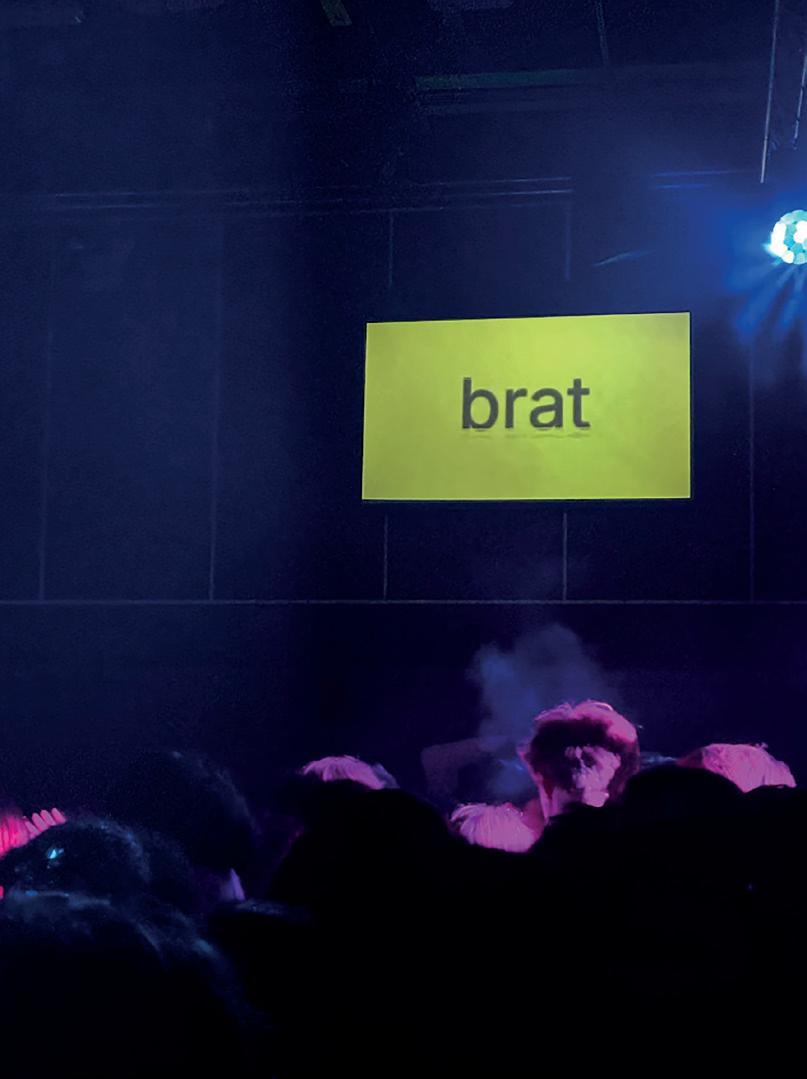
“One Direction is not Brat,” I heard another say as ‘What Makes You Beautiful’ boomed from the speakers. How Brat is One Direction? Both could be described as cultural phenomena, as widespread as the Plague in the Middle Ages, and yet only one is endorsed by model of the year, Alex Consani. In conclusion, hands on my knees, Angelina Jolie. Ultimately, Brat Bop was much like any other. One wonders why it wasn’t arranged earlier. One wonders why they played ‘Fein’. Perhaps it shall remain one of life’s many mysteries, an elusive and legendary enigma, much like Troye Sivan’s ardent beauty in the ‘One of Your Girls’ music video. All I can say is, I shall give the Union a call if I ever get lonely.
Photos by Cecilia Ryan
Photo by Jonathan Stock

Humour
URQUHART DYCE Sci-Tech Writer
Pop culture is full of scientists cracking jokes; entire sitcoms have been based on the humour of physicists. The sarcastic old mad scientist is an archetype we’ve seen time and time again. Still, in reality, scientists are often thought of as dry and boring people, viewed as more focused on labs than laughs. More importantly, according to a recent study published by the University of Georgia, we might need to crack a few more jokes if we want to increase public trust. Fake news and orange demagogues have helped to erode the perception of scientists as unbiased sources of fact with some success, but humour might be the unexpected antidote.
The study compared the reactions of over 2,000 participants to a range of comic strips posted by a fake scientist on X about artificial intelligence, then ranking the likability of this ‘scientist’ and the legitimacy of the
EDITOR: ANA-LUCIA CHALMERS
Laughing in Lab Coats
could help restore public trust in scientists
content as scientific communication. The results suggest that when scientists engage in lighthearted banter or self-deprecating jokes, the public perceives them as more relatable and trustworthy. In an era where misinformation spreads faster than the common cold, scientists need every tool at their disposal to connect with people.
Let’s not overlook what scientists are already doing to engage people with interesting (but not always the most practical) research. The Ig Nobel Prizes, awarded annually by the scientific humour magazine Annals of Improbable Research, celebrate studies that “first make people laugh, and then make them think”. These awards highlight quirky, unconventional research that might seem absurd at first glance but often has surprising scientific merit.
Take the 2024 Ig Nobel Prize for demography, which was awarded to Saul Justin Newman of the University of Oxford. His research uncovered a peculiar pattern: extreme age records — such as claims of
people living well past 110 — tend to come from regions with no birth certificates, clerical errors, pension fraud, and
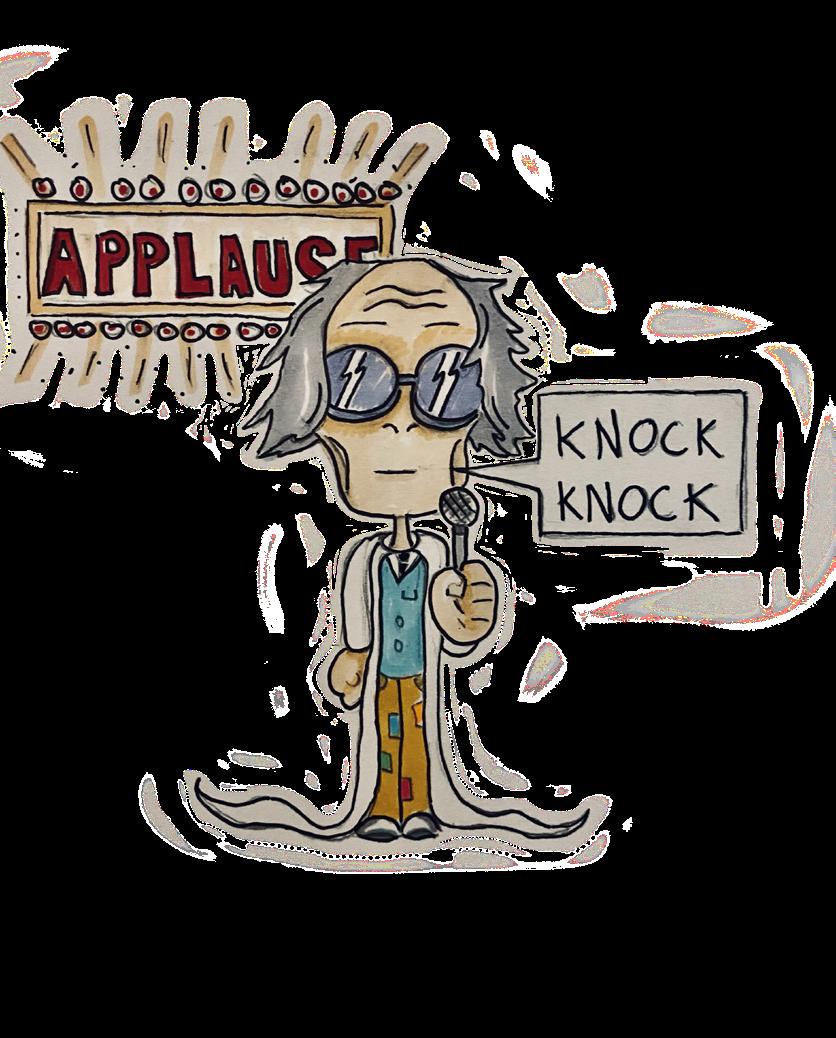
on aging and longevity, showing how errors
and fraud can distort demographic data. Other past winners have explored topics ranging from the physics of why ducklings swim in a row, the identification of drunk worms using chromatography, and the effectiveness of voodoo dolls in workplace revenge. While these studies may seem frivolous, they capture the public’s imagination and remind us that curiosity — no matter how bizarre — is at the heart of scientific discovery. This isn’t to say that humor alone will fix the crisis of public trust in science. Social media echo chambers, political polarisation, and sensationalist headlines all play their part in muddying the waters. But if making a joke or two can humanise scientists and make their work more accessible, then maybe it’s time to start sharpening our wit alongside our research skills. After all, if science can land a rover on Mars, it can surely land a solid punchline.
Illustration by Calum Mayor
Cracking the Airline’s Code
The math behind budget travel
MATTEO VERATELLI Sci-Tech Writer
Independent learning week: the time of the year when St Andrews suddenly becomes deserted and every student turns into the Indiana Jones of budget flight tickets. How many times, however, have you found an affordable flight one day and then realised with horror that the price had doubled by the time you looked it up again a few days later?
How can prices vary so drastically in such a short period? The reason for this can be traced back to the 1970s — American Airlines was looking for a way to increase revenue and popularise air travel to avoid half-empty planes. The solution, pioneered by the future CEO of the company, Robert Crandall, was what we now call ‘dynamic pricing’.
The idea behind it was simple: ticket prices should not be fixed but instead should change based on various factors, such as date, seasonality, and popularity. 50 years later, airlines still update their prices following the same principles.
The key concept of this strategy is price
buckets, in which seats are grouped based on cost. When demand for a specific fare is high, the computer automatically raises it to a higher bucket and vice versa. This way, prices are quickly and easily adjusted. However, direct demand is not the only

factor taken into account. The date and time of the flight also play a pivotal role. For example, weekend flights are always placed in higher buckets, as there is a higher demand for them. The same happens
with popular vacation destinations during holidays, though these get downgraded to lower buckets during the off-season.
Furthermore, booking flights early in the morning or late at night can help avoid peak commuting hours and expensive fares.
To take into account all these different scenarios, airlines nowadays average between twenty to over 70 different buckets. The new millennium has also provided airlines with a new tool: internet traffic can now be monitored to better estimate demand. Such a procedure has yet to be confirmed, but research on whether repeatedly visiting the same flight page leads to an increase in its price is being conducted. This logical process helps companies maximise revenues, but it can also be reversed and exploited to find flights at their cheapest. Most often, late Tuesday or early Wednesday (in the airline’s time zone) is the best time to book. This is because new fares are usually released on Mondays, but people do not tend to buy early in the week. Subsequently reacting to the low demand, prices are lowered for the next few days before being
raised again as the weekend approaches. Furthermore, prices tend to be higher in the first half of the month as people recieve their salary then and thus have more money to spend. Group bookings should also be avoided. In cases where low-fare tickets are available but are not enough for all the group members, websites will only show the more expensive bucket where enough seats are available on the same flight.
In addition, as a flight gets closer to the date, tickets are automatically moved into higher buckets. This upgrade happens for the first time three weeks before departure and repeats itself again two weeks and one week before. Consequently, it is better to buy tickets at least four weeks in advance.
So, if you are considering flying abroad next reading week, pay attention to when you book your flight. Earlier usually means better, but keep an eye on the day and week as well; low demand could offer pleasant surprises. Dynamic pricing can be a pain, but if tackled well, it could also be the key to your next dream holiday.
Illustration by Sandra Palazuelos Garcia
“The Goal is to Replace the Department” A conversation with St Andrews Engineering Society
ALICIA SVENSSON Sci-Tech Writer
The University of St Andrews offers a wide range of courses, from International Relations to Theology and Physics, but nowhere in its subject catalogue will you find engineering. So, despite lacking a formal engineering program, why has an engineering society emerged at St Andrews?
What is currently known as the St Andrews Engineering & Technology Society, or EngTech, originally consisted of three separate clubs: SPAD/ Automotive, Aerospace, and Robotics.
Nico Christou, President of EngTech, noted that “we had these three teams that had a lot of synergies just in terms of people within them. People who can code and work across teams are interested in various topics and fields of engineering — still, they were confined to their clubs [...] There is a lot to be gained from having them all under one umbrella and also having this be the engineering hub of St Andrews.”
These original clubs were founded after observing that many St Andrews students were missing an outlet for creating innovative projects and that the University still attracts engineering students despite its lack of a formal degree.
“You have a group of highly talented people
who aren’t given the resources to innovate and do projects,” said Christou. “Returning to what we do here, it all starts at the university level and [with] college students because we are the ones who will enter the workforce and be innovative. If we can provide an incubator or launch-pad for that, then we have done our job.”
Trajan Nader, Head of SPAD/ automotive, said, “I was supposed to do an engineering degree, but I chose St Andrews because of the social aspect and other factors, so I chose it over some depressing school in London. I applied to Maths and Physics, which is the closest thing to engineering here, but it is very theoretical, so many people here are still interested in engineering but have lost touch with it because it was so separated here at St Andrews. We wanted to give people the chance to apply their interests and replace an [official] engineering department.”
Student, and Formula Student AI — the first falling under aerospace to build and launch a rocket. The Formula student competitions
Formula [Students]. A lot of companies that sponsor Formula 1 stay after to hire students who have designed an effective car because you’ll be an excellent engineer.”
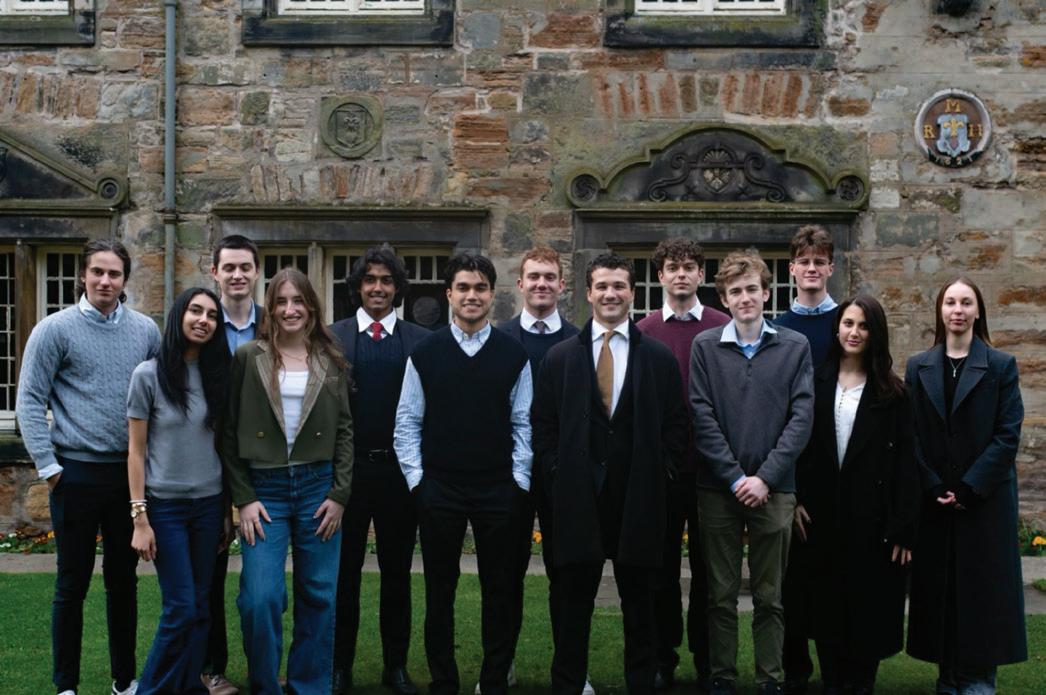
EngTech being student-driven and not governed by a University department allows for freedom and flexibility in projects. Independent ideas are always welcome, but the primary purpose of EngTech, as was also for the original clubs, is to compete. Currently, EngTech pursues three competitions: Project Odyssey, Formula
fall under SPAD/Automotive and consist of constructing a car or designing an AI programme to use in a self-driving car. These competitions provide hands-on practical experience, a passage into companies, as well as an attractive addition to one’s CV. Moreover, Formula Student is held at the same location as the Formula 1 races.
Co-Founder and VP of Formula Student Araan Suares, said, “If you have watched Formula 1, the engineers are a vital part of the team and a lot of UK and Europeanbased Formula 1 teams hire directly from
The EngTech society is not only for people in STEM subjects but for anyone who has an interest in engineering. Each team requires people of different expertise. The lack of an engineering department blurs the lines of who is ‘allowed’, and the criteria are instead dependent on genuine interest.
The St Andrews Engineering & Technology Society has become a dynamic hub for students interested in engineering despite the absence of a formal programme. EngTech encourages collaboration and innovation through competition by uniting individuals from various academic backgrounds. It provides hands-on experience and career opportunities, fostering connections within the university community and making it an invaluable resource for those looking to explore and apply their engineering interests.
Image Provided by EngTech
You Have Your Mother’s... Trauma?
LOGAN SIBBALD Sci-Tech Writer
How can you explain a deep-seated, torturous fear of something that you have never experienced? Moreover, if your parents suffered through unimaginable abuse as children and, to this day, refuse to ever talk about it, then why do you endure sweatfuelled night terrors and constant existential dread? These are the questions posed by individuals suffering from intergenerational trauma — a condition characterised by the transmission of post-traumatic stress disorder (PTSD) from a parent to offspring. Examples of this can be seen in the children of the survivors of the 1994 Rwandan genocide, which saw one million people killed over the course of just three months. With 41 per cent of survivors suffering from PTSD, female survivors showed lower levels of cortisol (the hormone which regulates the stress response) than Rwandan women who were not exposed to the genocide. Moreover, the children born to mothers who lived through the genocide, despite being in
the womb during at the time, also showed lower levels of cortisol compared to children born to mothers who did not. Moving from one generation to the next, this trauma was associated with a particular chemical modification in a gene involved in cortisol signalling in both parent and offspring, highlighting a biological mechanism in our genes responsible for the transfer of trauma. The amount of DNA in our bodies could stretch to the sun and back four times, but it is limited to our cells and thus tightly wound into kiss-shaped structures called chromosomes. This ensures that our genes are well-organised and that our cells have precise control over which genes are activated and which are silenced in response to environmental stimuli, development, and disease. This control over gene expression by modulating how tightly DNA is wrapped in chromosomes is termed epigenetics and differs from traditional genetics in that it does not physically alter DNA itself, just its accessibility. It is analogous to a family recipe scribbled on a sticky note: in your grandmother’s possession, it held pride of place on the
kitchen fridge, responsible for regular trays of lasagne; now, in your house, it is crumpled and stuffed to the back of the cutlery drawer. The recipe instructions themselves have not been altered — their ease of use has, and this may change as they are passed from one generation to the next.
In this way, epigenetic modifications serve as a biological memory, indicating whether a gene was active or silent in the past and influencing its expression in the present.
“Our lives [...] are impacted by the experiences of our parents.”
Considering this, another example of how epigenetics may influence the PTSDlike biology of subsequent generations is that of Holocaust survivors and their children. In this case, however, the epigenetic modifications conferred to
children were associated with fewer PTSDlike symptoms than were observed in their mothers. Underpinning this observation was the fact that, while mothers exposed to the Holocaust during childhood showed increased methylation (a form of epigenetic modification) in a gene called FKBP5, the opposite was seen in the same gene in their offspring. Since FKBP5 encodes a protein that is also involved in regulating the stress response, relieving its repression by lowering methylation levels has been suggested to promote resilience and awareness. As such, the epigenetic profile of a new generation may be adjusted so that it can better adapt to the challenges faced by a previous one. These propositions are all putative, however, and their validation will rely on experiments being replicated in larger cohorts and the discernment of the impact that additional factors, like the womb’s environment, may have on gene expression. Nonetheless, the concept that our lives — for better or worse — are affected by the experiences of our parents, and their parents before them, is both profoundly intriguing and unsettling.
Sport

EDITOR: MAHALEY WISE
Saints in the Spotlight
The stories of the Big BUCS Wednesday star performers
ELODIE COWAN
Sport Writer
Wednesday, 19 March was a landmark day for St Andrews sport. With the Women’s Football 1s chasing a national title and the Men’s Rugby 1s battling for the BUCS Rugby Union National Trophy, the stage was set for a day that more than lived up to the hype of Big BUCS Wednesday.
I had the privilege of being in Loughborough for the action, and the energy on campus was off the charts. With student spectators — beer cans in hand — friends and families lining the barricades, and the golden sunshine drenching the city, everything was primed for a sporting spectacle.
By the final whistles, both St Andrews teams had written their names into the history books and emerged victorious in two hard-fought finals.
Among the celebrations, two standout players were named BUCS Player of the Match by the officials: Olivia Boscaccy and Chris Schreuder. The Saint caught up with the pair to hear about their reflections on the day—and the stories behind their success.
An interview with Olivia Boscaccy:
Two goals and Player of the Match in the national final — how did that feel?
It was genuinely such a surprise — I
didn’t even know it was being awarded.
I didn’t feel fully in control during the game and really had to dig deep. Both goals felt almost accidental. The first came after a great team buildup — I blanked and just hit the ball. The second goal was me hoping that I could get anything off the rebound. I don’t even think of myself as a playmaker, so it was surreal.
The pure elation I felt running to celebrate with my team, revelling in the hope that we could win this game — I haven’t felt such joy from footy like that in a long time. I will always cherish those celebrations with my team.
Late kickoff, high stakes, long travel — how did you stay focused and composed through it all?
It was a weird adjustment driving up the day of the game. We were all very excited, but knew we had to ‘lock in’ as the kick-off got closer. We had a lot of time to settle into the emotions when we got to the stadium.
I think I can speak for the whole team when I say we went in with a “we absolutely cannot and will not lose” mindset. You could feel it in the locker room — nerves, excitement, and total determination.
Have mentors helped shape your development?
Definitely. Jay Gilman built my foundation and work ethic that I pride myself on today. Gareth Munro brought out a different player in me — someone who thrived in creativity and drive. He gave me a chance by selecting me as the only freshman to play on the varsity team and supported me all four years. He also helped me believe that playing at St Andrews was possible.
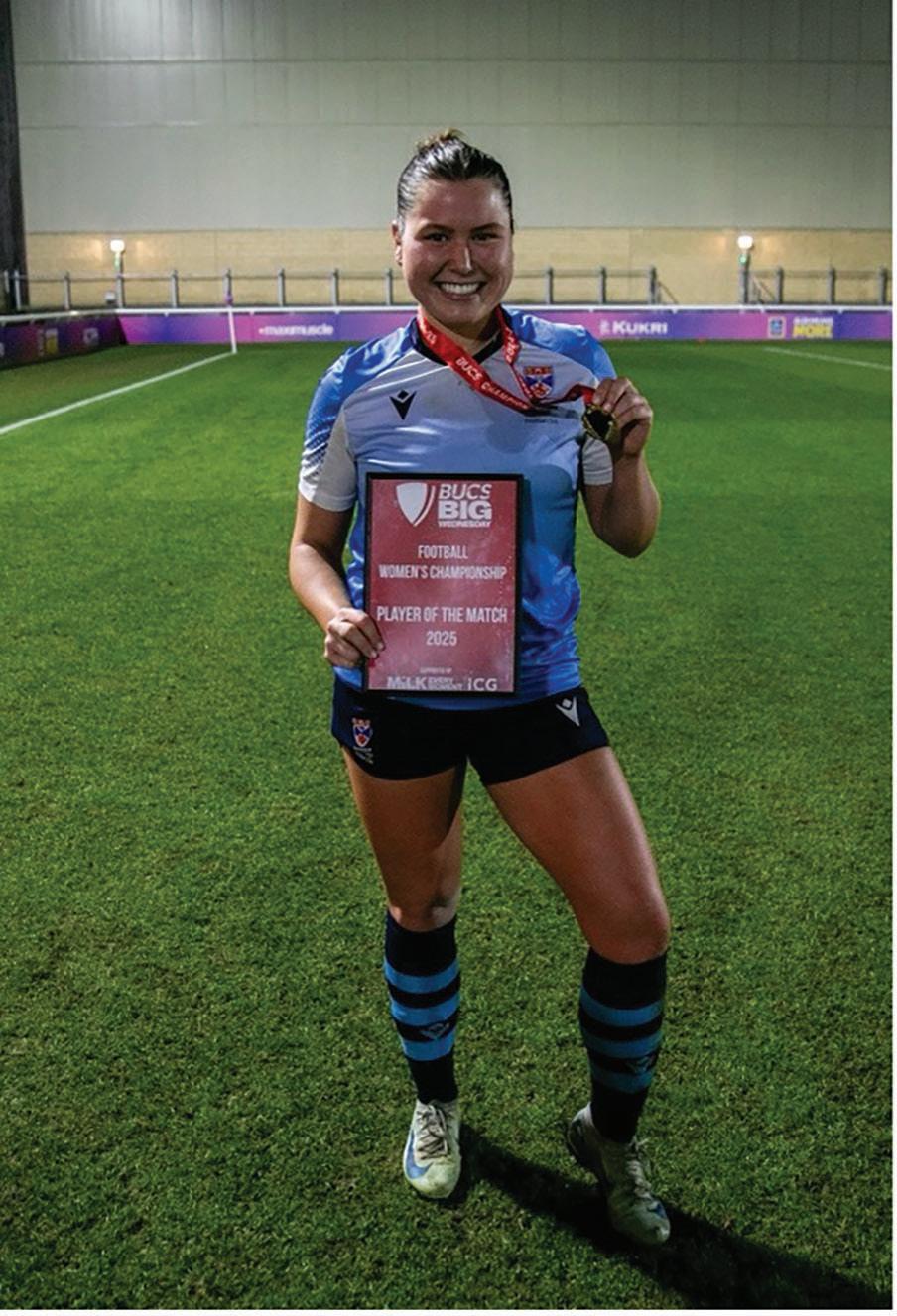
And here at university, Stu, Wayne, Ali, and Allan have elevated my game and have transformed me into the player I am today.
What does this team mean to you?
Everything. I have never in my entire career played on a team with such friendship and joy. The team always supports each other in everything we do.
An interview with Christopher Schreuder: Congratulations! How does it feel to be named Player of the Match?
Thank you. I’m very grateful. It is probably the best way to end what’s been a very successful season. I
couldn’t have done it without the rest of the team on the day. The Man of the Match award could’ve gone to anyone. What was going through your head during the final whistle? Did it feel real straight away? It took a few minutes to set in. An unrealistic thought for us at the start of the season had become a reality. I just felt very proud to be a Saint. It was special to share the moment with all my teammates. Loughborough had a strong home crowd. How did you manage that added pressure as a visiting team, especially for you as a fly-half?
I learnt how to deal with noisy crowds during my school rugby days. Back in South Africa, it was never easy playing away games, and those experiences helped me elevate my game for this occasion. It is also very satisfying as a visiting team hearing the home crowd go quiet. That fuels the fire.

You handled your conversions brilliantly. How do you stay composed in those high-pressure moments?
I’ve always loved kicking and think that it’s one of my biggest strengths. I just focus on my routine and trust it. I’ve also had some high-pressure moments in my career where I’ve had to slot important kicks. Those experiences helped me deal better in this high-pressure game. Was there a moment in the match where you felt the game shift in your favour?
A stand-out moment was Angus Mather’s try in the second half. There was some individual brilliance involved from Jamie Thomson, which was capped off by a world-class finish from Angus. That score put us 23-3 up, which gave us the belief that we were going to win the game. What does the trophy mean to you personally?
This was likely my last competitive rugby game ever and was the perfect way to end my rugby career. Winning the trophy is one of my biggest highlights, together with winning the Varsity match against Edinburgh at the start of the season.
What do you think you’ve brought to the team this season,
on a leadership or mentality level? I was expected to bring leadership and a different dynamic to the team through my experiences in my professional career. I hope that I lived up to those expectations and believe that I have left the jersey in a better place than I found it.
We wanted a more high-performance mindset this season. The whole team bought into it. You could see the emotions on the team’s faces after a few narrow defeats in the league. Every time we walked onto the field, we expected to win. I trust that this mindset will carry over to the future seasons to come.
A Day to Remember
From the first conversion to the final free kick, Big BUCS Wednesday delivered a showcase of determination, teamwork, and standout individual brilliance. Olivia Boscaccy and Chris Schreuder’s performances were the embodiment of that spirit — decisive, composed ,and humble in the face of pressure. But perhaps what made the day so special was what lay behind the silverware: the quiet resilience, the leadership, the hours of preparation, and the bonds forged in training. Two teams. Two titles. One unforgettable day for St Andrews sport.
Photos by Sandy Coull
Newcastle’s Shiny New Silverware
Newcastle wins a major trophy after 70 years
MAHALEY WISE
Sport Editor
Patience is critical to any team’s talent and tool kit. Too much aggression and pride can cause even the greatest teams to go down in a blaze of glory while the underdog takes the stage after years of preying and hoping. This was the case in early March when Newcastle beat Liverpool in the Carabao Cup final, bringing home a shiny new piece of silverware after 70 years of patiently waiting. It was a game powered by flight and calculated aerodynamics for Newcastle, as they headed the ball and linked it with classy footwork to score their two goals. The first goal was initiated by a corner kick sent flying across the pitch to the outside rims of the Red Wall created by Liverpool, where it was knocked off the head of Dan Burns with great force and into the back of the net. Immediately, the black and white crowd erupted into cheers at the historic moment that put an end to Newcastle’s scoring drought in must-win situations. It was an accomplished week for the Newcastle
defender, Dan Burns, who just two days earlier received his first call-up to England. Hearty hugs and poetic cheers overflowed in the stadium as Newcastle’s patience dwindled and defiance took its place. With a new empowered energy, Newcastle sought to repeat the same action as before in the second half by outlasting, outmaneuvering, and outachieving their bloody red opponents. The second goal by Newcastle was scored early into the second half at the 52-minute mark. It began with a left-footed cross by Tino Livramento, sending the ball sailing through the air where it collided with Jacob Murphy, punching it down to Alexander Isak, who stood patiently waiting to slide it into the goal after an earlier offside call that eliminated a previous goal. There was no doubt about this one, however, as the crowd once again broke out into elated cries. Isak embraced the crowd from the pitch, surrounded by the black and white jerseys of his teammates as they came one step closer to victory. Liverpool sauntered around the pitch in
a daze with memories of its defeat in the Champions League fresh on its mind. They finally found their rhythm in injury time

with a goal in the 94th minute by Federico Chiesa. However, it was too little too late, and Newcastle went home with the victory while Liverpool fans faced another heart-stopping defeat. For Newcastle fans, the memories of
the 1955 final cup win and 1976 Football League Cup Final goal faded away, now replaced by the shiny new victory of the Carabao Cup final win. The fiery Newcastle team was spearheaded by English manager Eddie Howe. This victory will make him the first English manager in the UK, since Harry Redknapp with Portsmouth in 2008, to claim a major trophy. On the sideline, he was the one to cheer the loudest and celebrate the most for his players on their path to glory. Overtaking the team in 2021, he came in with an iron fist and a dream for victory, advancing the team’s training and practices. On this fateful day, the day of the Carabao Cup, there seems to be a very bright future for the team.
Have Athletics Hit the Ground Running?
ISOBEL LISHER Sport Writer
Athletics is the epitome of human excellence. From endurance, to strength, to speed, it is the ultimate showcase of the fastest and strongest people on the planet — something captured by the superb Netflix documentary Sprint. With two seasons released and a third on the way, this documentary captures what makes this sport so unique, and why sprinting especially is finally getting the exposure and attention it deserves. Getting a Netflix deal alone is enough to show that athletics is increasing in popularity — but why is this? Sprint focuses on key individuals in the sport who competed in the 2022 World Athletics Championships in the first series, and the 2024 Paris Olympics in the second. This individual focus makes sense considering sprinting is, other than relays, an individual sport. Yet, it also presents the idea that this sport is dominated by big personalities who can shine on the world stage. In Sprint, medal-winning Olympic and World Championship sprinter Noah Lyles said that athletics “needs to be about the athletes, their personalities, and what they bring to the table”. Hence, big personalities equal
increased coverage and viewer numbers.
In this day and age, social media has become a focal point of society and has hurled all sorts of interests into the mass media — with sports being one of them. Although athletics has been televised since the 1950s, social media enhances these big personalities and shows other sides to their lives, increasing the appeal of the sport. Through personalising how spectators view them, athletes are more in control of their public status than ever — dare I say even becoming celebrities to the extent that sportspeople have not reached before.
Financially, social media also adds another dynamic to the popularity of athletics. Brand deals have become a key way for athletes to increase their paychecks, such as Noah Lyles and Puma, or 200m gold
medalist Gabby Thomas and Nike. These opportunities available to sportspeople today make their profession bigger than the sport, creating bigger legendary roles to fill.
Yet in a rather paradoxical way, the increased focus on these sports superstars almost makes the success of less public sportspeople even more exceptional. For example, the 2024 Olympic women’s 100m was all to play for
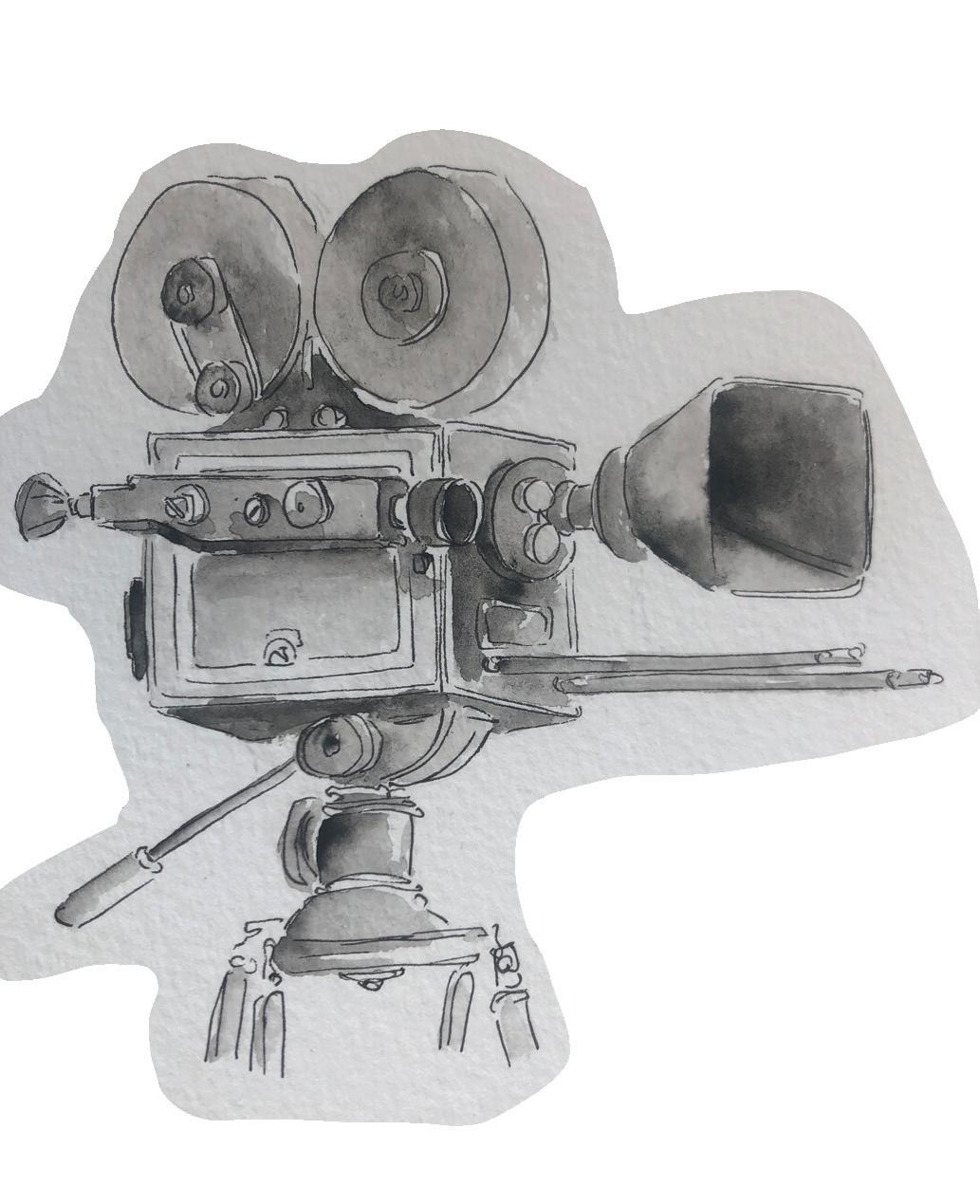
between the competitors, especially with the lack of the typical AmericanJamaican rivalry due to injuries in the Jamaican camp. A fierce showdown in a gruelling 10.72 seconds saw Saint Lucian Julien Alfred sprinting to victory, beating American
favourite Sha’Carri Richardson. Richardson is an athlete who is certainly not shy of attention and would have been a worthy winner of the gold, but everyone does love an underdog (not to undermine her skill but rather the lack of attention surrounding her). The whole melting pot of modern athletics makes watching the stars shine and the surpassing in underdog victories an equally exciting spectacle.
Importantly though, it is not just in the modern age that athletes’ names have started to roll off the tongue, with some massive sporting names coming from athletics. From 1930s sporting sensation Jesse Owen, to legends such as Michael Johnson and Allyson Felix, these are all athletes who did not need social media to create the names that they have. Yet, the roles in the public eye that Johnson and Felix still have today just goes to show that athletics has entered an era of stardom which makes the sport more about the sport itself. All these sportspeople are exceptional at what they do, and this attention is giving athletics the voice it deserves; I personally hope this sport can continue to take the centre stage.
Image from Wikimedia Commons
Illustration by Sarah Knight

He Was Working As A Waiter In A Cocktail Bar...
Thomas Tuchel gets off to a winning start in his World Cup quest
BEN BAGLEY Sport Writer
Tuchel was working as a cocktail waiter when he got the call offering him a job at VfB Stuttgart; he has gone on to coach some of Europe’s most prestigious clubs. He now faces undoubtedly the biggest challenge of his career — winning England the World Cup.
Many questioned the England national team appointing a German manager. Many may be surprised to learn that our Royal Family bore the name SaxeCoburg-Gotha until 1917. The ‘Windsors’ are about as English as a Dachshund dressed in a Giorgio Armani tuxedo.
Granted, England’s previous attempt at hiring a foreign manager was not a roaring success. Fabio Capello sleepwalked the national team into major tournament results like 0-0 against Algeria and 1-1 against the US with all the enthusiasm of a Neapolitan chef reluctantly preparing a picky British tourist a bowl of plain penne.
Tuchel seems a cut above the Italian. He’s got numerous domestic titles to his name as well as the coveted Champions League trophy. This guy is a serial winner.
The German’s all-encompassing approach to management has earned him admirers and sceptics in equal measure. The strict dietary requirements imposed on his players at Borussia
Dortmund earned him the nickname ‘Tofu Tuchel’ in the German tabloid press.
He is similarly unconventional in the dugout. His touchline antics resemble a competitive dad haranguing his tenyear-old son at a school sports day.
Tuchel’s predecessor, Sir Gareth Southgate, transformed the culture of the England football team. Once a toxic and defeatist environment, he instilled an infectious go get ’em mentality that the country really got behind.
Fans lose sight of just how bad England were pre-Gareth, losing to Iceland at Euro 2016, a country with more active volcanoes than professional footballers.
Southgate was the architect of unforgettable moments like the penalty win against Colombia, the comeback against Slovakia and the Watkins winner against the Netherlands.
Like any plucky British hero, however, Southgate’s reign will be remembered as an oh-so-near tale of anguish — a series of what-ifs culminating in Mikel Oyarzabal’s heartbreaking last-minute winner at the European Championship final last summer.
Despite Gareth’s successes, a clean break from the past was necessary in the wake of the devastating defeat in Berlin. Tuchel fits the bill. His cutthroat and at times arrogant manner is far-removed from Southgate’s unassuming charm.
Football v Football
by Anne-Carter Riggs
It was a regularly misty day at the sports centre: a little bit damp and very grey. Instead of walking inside to use the gym, I took a left turn towards the turf, accompanied by my fellow Sport writer Patrick Maitland to see if I had any coordination. My only previous experience playing football was the brief period I spent on my highschool’s third soccer team, spent mostly standing next to the goal to chat with my goalie friend. While I never once touched the ball, I did meet my school’s team sport requirement for
the fall. Now, as I stand in my apparently not ideal footwear selection (on clouds), I’m actually going to play.
My first kick was bad; it did not go too far. But after learning where to hit the ball, leaning back, and a little more umph, it made a load of difference.
After Lots of passing back and forth, I was starting to get the hang of it — some kicks even got
There were already promising signs in Tuchel’s opening games against Albania and Latvia over the international break. Myles Lewis-Skelly seems to be the

left-sided defender England have been crying out for — he linked up with the inimitable Jude Bellingham to become England’s youngest-ever debut scorer.

the ball in the air. For only 45 minutes of just passing, not even playing, I can see why football is addicting. Within that time, I definitely saw myself improving. I did not manage a bicycle kick, but I consistently started to get the ball to go where I wanted and with a little
Failure to fully utilise Bellingham’s godlike ability was one of the major criticisms levelled at Southgate during his tenure. His successor’s capacity to get the best out of the Real Madrid midfielder may be the difference between England lifting the World Cup Trophy in 2026.
The reality of the bizarrely short eighteen-month contract handed to him by the FA had an obvious impact on Tuchel’s first squad selection. He opted for the much maligned, but well experienced, Jordan Henderson, and handed Dan Burn his first senior cap, making him the second-oldest debutant in England history.
Hopefully, the immediacy of Tuchel’s task does not deter the German from rolling the dice when necessary. One of Southgate’s great strengths was making bold calls in high pressure situations, something the often-pragmatic Tuchel ought to emulate.
In many ways, the task of the England manager is akin to that of a mixologist. Tuchel has a wealth of ingredients at his disposal, but whether he can knock up a decent pina colada, only time will tell.
more speed. All in all, especially coming from someone who plays a sport which depends on many factors, the accessibility of football is extremely appealing: all you need is a ball. You’re not relying on boats, wind, or other equipment. And you can always improve. The millions of people who play football daily constantly improve; no wonder few quit completely. Not that I see myself playing with my buddies on a random day, but I definitely would take the opportunity to do so should it present itself.
Illustration by Isabelle Holloway
Photo from Wikimedia Commons

